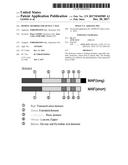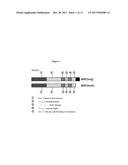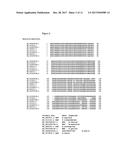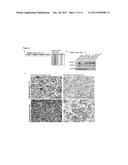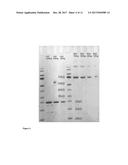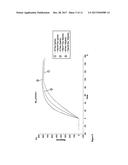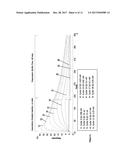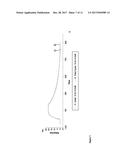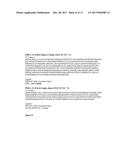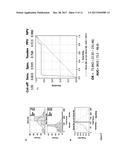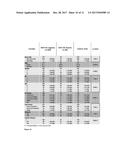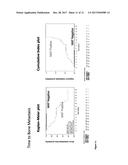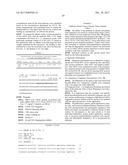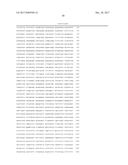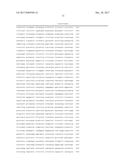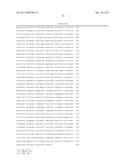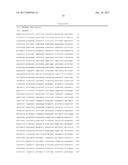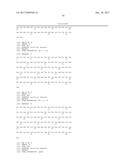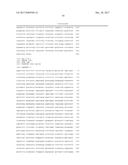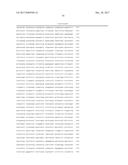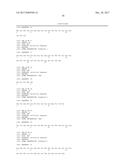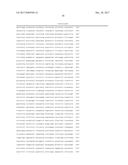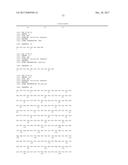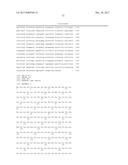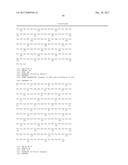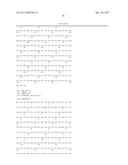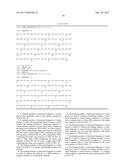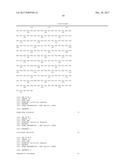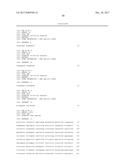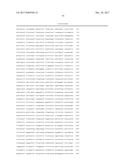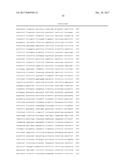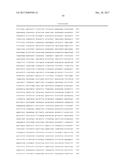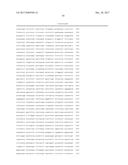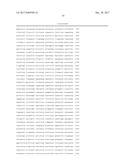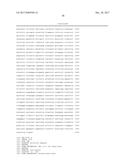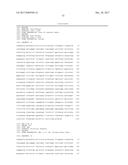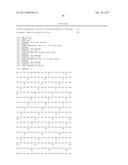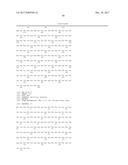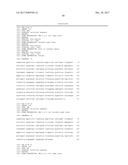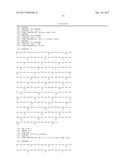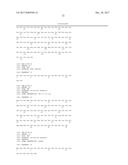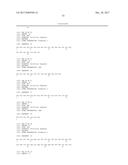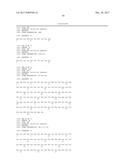Patent application title: BINDING MEMBERS FOR HUMAN C-MAF
Inventors:
IPC8 Class: AC07K1632FI
USPC Class:
1 1
Class name:
Publication date: 2017-12-28
Patent application number: 20170369589
Abstract:
The disclosure relates to binding members, especially antibody molecules,
which bind to human Maf. The binding members are useful for the
determination of the expression level of Maf.Claims:
1. A binding member or functional fragment or variant thereof that
specifically binds to the epitope encoded by SEQ ID NO: 22.
2. A binding member or functional fragment or variant thereof of claim 1 that specifically binds to human c-MAF, wherein the binding member or functional fragment or variant thereof comprises a heavy chain CDR1 comprising the amino acid sequence of SEQ ID NO: 38, and/or a heavy chain CDR2 comprising the amino acid sequence of SEQ ID NO: 40, and/or a heavy chain CDR3 comprising the amino acid sequence of SEQ ID NO: 42; and/or a light chain CDR1 comprising the amino acid sequence of SEQ ID NO: 26, and/or a light chain CDR2 comprising the amino acid sequence of SEQ ID NO: 28 and/or a light chain CDR3 comprising the amino acid sequence of SEQ ID NO: 30.
3. The binding member or functional fragment or variant thereof of claim 1 or 2, wherein said binding member is an antibody.
4. The binding member or functional fragment or variant of claim 3, wherein the antibody is a rabbit antibody, a chimeric antibody or a humanized antibody.
5. The binding member or functional fragment or variant thereof of claim 4, wherein said binding member or functional fragment or variant thereof comprises a V.sub.H domain with a sequence that is at least 80% identical to the amino acid sequence of SEQ ID NO: 17.
6. The binding member or functional fragment or variant thereof of claim 5, wherein the binding member or functional fragment or variant thereof comprises a V.sub.H domain with a sequence that is at least 90% identical to the amino acid sequence of SEQ ID NO: 17.
7. The binding member or functional fragment or variant thereof of claim 6, wherein the binding member or functional fragment or variant thereof comprises a V.sub.H domain with a sequence that is at least 95% identical to the amino acid sequence of SEQ ID NO: 17.
8. The binding member or functional fragment or variant thereof of claim 7, wherein the binding member of functional fragment or variant thereof comprises a V.sub.H domain with a sequence comprising the amino acid sequence of SEQ ID NO: 17.
9. The binding member or functional fragment or variant thereof of any one of claims 1-8, wherein the binding member of functional fragment or variant thereof comprises a V.sub.L domain with a sequence that is at least 80% identical to the amino acid sequence of SEQ ID NO: 21.
10. The binding member or functional fragment or variant thereof of claim 9, wherein the binding member of functional fragment or variant thereof comprises a V.sub.L domain with a sequence that is at least 90% identical to the amino acid sequence of SEQ ID NO: 21.
11. The binding member or functional fragment or variant thereof of claim 10, wherein the binding member or functional fragment or variant thereof comprises a V.sub.L domain with a sequence that is at least 95% identical to the amino acid sequence of SEQ ID NO: 21.
12. The binding member or functional fragment or variant thereof of claim 11, wherein the binding member or functional fragment or variant thereof comprises a V.sub.L domain with a sequence comprising the amino acid sequence of SEQ ID NO: 21.
13. The binding member or functional fragment or variant thereof of any one of claims 1-12, wherein the binding member or functional fragment or variant thereof comprises a heavy chain sequence that is at least 80% identical to the amino acid sequence of SEQ ID NO: 16.
14. The binding member or functional fragment or variant thereof of claim 13, wherein the binding member or functional fragment or variant thereof comprises a heavy chain sequence that is at least 90% identical to the amino acid sequence of SEQ ID NO: 16.
15. The binding member or functional fragment or variant thereof of claim 14, wherein the binding member or functional fragment or variant thereof comprises a heavy chain sequence that is at least 95% identical to the amino acid sequence of SEQ ID NO: 16.
16. The binding member or functional fragment or variant thereof of claim 15, wherein the binding member or functional fragment or variant thereof comprises a heavy chain sequence comprising the amino acid sequence of SEQ ID NO: 16.
17. The binding member or functional fragment or variant thereof of any one of claims 1-16, wherein the binding member or functional fragment or variant thereof comprises a light chain sequence that is at least 80% identical to the amino acid sequence of SEQ ID NO: 20.
18. The binding member or functional fragment or variant thereof of claim 17, wherein the binding member or functional fragment or variant thereof comprises a light chain sequence that is at least 90% identical to the amino acid sequence of SEQ ID NO: 20.
19. The binding member or functional fragment or variant thereof of claim 18, wherein the binding member or functional fragment or variant thereof comprises a light chain sequence that is at least 95% identical to the amino acid sequence of SEQ ID NO: 20.
20. The binding member or functional fragment or variant thereof of claim 19, wherein the antibody or fragment thereof comprises a light chain sequence comprising the amino acid sequence of SEQ ID NO: 20.
21. A polynucleotide encoding the binding member or functional fragment or variant thereof of any one of claims 1-20.
22. The polynucleotide of claim 21, wherein the polypeptide encodes an antigen binding molecule or fragment thereof.
23. The polynucleotide of claim 21 or 22, wherein the binding member or functional fragment or variant thereof is an antibody.
24. The polynucleotide of any one of claims 21-23, wherein the polynucleotide comprises a V.sub.H domain with a sequence that is at least 80% identical to the nucleotide sequence of SEQ ID NO: 15.
25. The polynucleotide of claim 24, wherein the polynucleotide encodes a V.sub.H domain with a sequence that is at least 90% identical to the nucleotide sequence of SEQ ID NO: 15.
26. The polynucleotide of claim 25, wherein the polynucleotide encodes a V.sub.H domain with a sequence that is at least 95% identical to the nucleotide sequence of SEQ ID NO: 15.
27. The polynucleotide of claim 26, wherein the polynucleotide encodes a V.sub.H domain with a sequence that is identical to the nucleotide sequence of SEQ ID NO: 15.
28. The polynucleotide of any one of claims 21-27, wherein the polynucleotide encodes a V.sub.L domain with a sequence that is at least 80% identical to the nucleotide sequence of SEQ ID NO: 20.
29. The polynucleotide of claim 28, wherein the polynucleotide encodes a V.sub.L domain with a sequence that is at least 90% identical to the nucleotide sequence of SEQ ID NO: 20.
30. The polynucleotide of claim 29, wherein the polynucleotide encodes a V.sub.L domain with a sequence that is at least 95% identical to the nucleotide sequence of SEQ ID NO: 20.
31. The polynucleotide of claim 30, wherein the polynucleotide encodes a V.sub.L domain with a sequence that is identical to the nucleotide sequence of SEQ ID NO: 20.
32. The polynucleotide of any one of claims 21-31, wherein the polynucleotide encodes a heavy chain with a sequence that is at least 80% identical to the nucleotide sequence of SEQ ID NO: 14.
33. The polynucleotide of claim 32, wherein the polynucleotide encodes a heavy chain with a sequence that is at least 90% identical to the nucleotide sequence of SEQ ID NO: 14.
34. The polynucleotide of claim 33, wherein the polynucleotide encodes a heavy chain with a sequence that is at least 95% identical to the nucleotide sequence of SEQ ID NO: 14.
35. The polynucleotide of claim 34, wherein the polynucleotide encodes a heavy chain with a sequence that is identical to the nucleotide sequence of SEQ ID NO: 14.
36. The polynucleotide of any one of claims 21-35, wherein the polynucleotide encodes a light chain with a sequence that is at least 80% identical to the nucleotide sequence of SEQ ID NO: 18.
37. The polynucleotide of claim 36, wherein the polynucleotide encodes a light chain with a sequence that is at least 90% identical to the nucleotide sequence of SEQ ID NO: 18.
38. The polynucleotide of claim 37, wherein the polynucleotide encodes a light chain with a sequence that is at least 95% identical to the nucleotide sequence of SEQ ID NO: 18.
39. The polynucleotide of claim 38, wherein the polynucleotide encodes a light chain with a sequence that is identical to the nucleotide sequence of SEQ ID NO: 18.
40. The polynucleotide of claims 21-39. wherein the amino acid encoded for by the polynucleotide binds to the epitope described by SEQ ID NO: 22.
41. The binding member or functional fragment or variant thereof of any one of claims 1-20, wherein the binding member or functional fragment or variant thereof binds to human c-MAF with an affinity (KD) of at least about 1.5 nM or less.
42. The binding member or functional fragment or variant thereof of claim 41, wherein the binding member or variant thereof binds to human c-MAF with an affinity (KD) of at least about 1.2 nM or less.
43. The binding member or functional fragment or variant thereof of claim 42, wherein the binding member or variant thereof binds to human c-MAF with an affinity (KD) of at least about 1.1 nM or less.
44. A vector comprising the polynucleotide of any one of claims 21-40.
45. A host cell comprising the polynucleotide of any one of claims 21-40, the vector of claim 44, or expressing the binding member of any one of claim 1-19 or 41-43.
46. A method of producing an antigen binding member comprising culturing the host cell of claim 45.
47. A method of using an antigen binding member produced by the host cell of claim 45 or the method of claim 46 to detect c-MAF.
48. A binding member or functional fragment or variant thereof that competes for binding with INB-1-11-8 to the epitope encoded by SEQ ID NO: 22.
Description:
REFERENCE TO SEQUENCE LISTING
[0001] The content of the electronically submitted sequence listing ("3190_012PC01_SL.txt", 77,454 bytes, created on Dec. 4, 2015) filed with the application is incorporated herein by reference in its entirety.
FIELD OF THE INVENTION
[0002] This invention relates to binding members, especially antibody molecules, which bind to human c-MAF. The binding members are useful for the quantitation of c-MAF, for the diagnosis and prognosis of c-MAF-related disorders, and for the treatment of c-MAF-related disorders.
BACKGROUND
Problem
[0003] Metastasis, a complex process caused by elaborate interactions between tumor cells and the surrounding normal tissues in different vital organs, accounts for 90 percent of all cancer deaths in patients with solid tumors. The molecular and cellular mechanisms that lead primary tumors to form metastases must be understood in order to better address this major life-threatening problem. The identification of metastasis genes and mechanisms is essential for understanding the basic biology of this lethal condition and its implications for clinical practice. Previous work provided a sense of the complexity of the metastasis process, but it failed to explain how and why metastasis occurs, what mechanisms make metastasis a tissue-specific process, what events allow dormant metastases to become active and lethal many years after removal of a primary tumor, and what metastasis-mediating genes would eventually constitute worthy diagnostic markers and therapeutic targets.
[0004] The present invention is based on the realization that the reliable identification of markers that predict bone metastasis would provide a preventive therapeutic opportunity by imposing restrictions to the spreading and colonization of bone metastatic tissue by cancer cells and delay or transform a lethal condition, and the necessity for a mechanism of identifying the expression of the metastasis predicting marker. Thus, for example, it has been shown that protein and mRNA accumulation of MAF, a bona fide breast cancer bone metastasis gene, can be acquired by 16q22-24 (16q23) amplifications or 16q23 translocations among other potential mechanisms. c-MAF is also responsible for driving the cancer bone metastatic lesions, including osteolytic cancer bone metastasis.
SUMMARY OF INVENTION
[0005] In one embodiment, the present invention relates to the detection of genetic abnormalities through the use of an antibody and to the prognosis and/or diagnosis of metastasis (e.g., bone metastasis) in cancer based on same. In one embodiment, the invention involves the use of an antibody to determine the levels of a gene of interest in a primary tumor sample. In one embodiment, the invention relates to a binding member (e.g., an antibody) that specifically binds to human c-MAF. Likewise, the invention also relates to a method for designing a customized therapy in a subject with cancer which comprises determining the level of a gene of interest in a sample using an antibody. In one embodiment, the gene of interest is MAF. In another embodiment, the cancer is breast cancer, lung cancer, prostate cancer, or renal cancer.
[0006] In one aspect, the present invention is directed to a binding member or functional fragment or variant thereof that specifically binds to the epitope encoded by SEQ ID NO: 22. In some embodiments, the binding member or functional fragment or variant thereof specifically binds to human c-MAF, wherein the binding member or functional fragment or variant thereof comprises a heavy chain CDR1 comprising the amino acid sequence of SEQ ID NO: 38, and/or a heavy chain CDR2 comprising the amino acid sequence of SEQ ID NO: 40, and/or a heavy chain CDR3 comprising the amino acid sequence of SEQ ID NO: 42; and/or a light chain CDR1 comprising the amino acid sequence of SEQ ID NO: 26, and/or a light chain CDR2 comprising the amino acid sequence of SEQ ID NO: 28 and/or a light chain CDR3 comprising the amino acid sequence of SEQ ID NO: 30.
[0007] In some embodiments, said binding member is an antibody. In some embodiments, the antibody is a rabbit antibody, a chimeric antibody or a humanized antibody.
[0008] In some embodiments, said binding member or functional fragment or variant thereof comprises a VH domain with a sequence that is at least 80% identical to the amino acid sequence of SEQ ID NO: 17. In some embodiments, the binding member or functional fragment or variant thereof comprises a VH domain with a sequence that is at least 90% identical to the amino acid sequence of SEQ ID NO: 17. In some embodiments, the binding member or functional fragment or variant thereof comprises a VH domain with a sequence that is at least 95% identical to the amino acid sequence of SEQ ID NO: 17. In some embodiments, the binding member of functional fragment or variant thereof comprises a VH domain with a sequence comprising the amino acid sequence of SEQ ID NO: 17.
[0009] In some embodiments, the binding member of functional fragment or variant thereof comprises a VL domain with a sequence that is at least 80% identical to the amino acid sequence of SEQ ID NO: 21. In some embodiments, the binding member of functional fragment or variant thereof comprises a VL domain with a sequence that is at least 90% identical to the amino acid sequence of SEQ ID NO: 21. In some embodiments, the binding member or functional fragment or variant thereof comprises a VL domain with a sequence that is at least 95% identical to the amino acid sequence of SEQ ID NO: 21. In some embodiments, the binding member or functional fragment or variant thereof comprises a VL domain with a sequence comprising the amino acid sequence of SEQ ID NO: 21.
[0010] In some embodiments, the binding member or functional fragment or variant thereof comprises a heavy chain sequence that is at least 80% identical to the amino acid sequence of SEQ ID NO: 16. In some embodiments, the binding member or functional fragment or variant thereof comprises a heavy chain sequence that is at least 90% identical to the amino acid sequence of SEQ ID NO: 16. In some embodiments, the binding member or functional fragment or variant thereof comprises a heavy chain sequence that is at least 95% identical to the amino acid sequence of SEQ ID NO: 16. In some embodiments, the binding member or functional fragment or variant thereof comprises a heavy chain sequence comprising the amino acid sequence of SEQ ID NO: 16.
[0011] In some embodiments, the binding member or functional fragment or variant thereof comprises a light chain sequence that is at least 80% identical to the amino acid sequence of SEQ ID NO: 20. In some embodiments, the binding member or functional fragment or variant thereof comprises a light chain sequence that is at least 90% identical to the amino acid sequence of SEQ ID NO: 20.
[0012] The binding member or functional fragment or variant thereof of claim 18, wherein the binding member or functional fragment or variant thereof comprises a light chain sequence that is at least 95% identical to the amino acid sequence of SEQ ID NO: 20. In some embodiments, the antibody or fragment thereof comprises a light chain sequence comprising the amino acid sequence of SEQ ID NO: 20.
[0013] In some embodiments, the present invention is directed to a polynucleotide encoding any binding member or functional fragment or variant thereof described herein. In some embodiments, the polynucleotide encodeas a polypeptide that encodes an antigen binding molecule or fragment thereof. In some embodiments, the binding member or functional fragment or variant thereof is an antibody.
[0014] In some embodiments, the polynucleotide comprises a VH domain with a sequence that is at least 80% identical to the nucleotide sequence of SEQ ID NO: 15. In some embodiments, the polynucleotide encodes a VH domain with a sequence that is at least 90% identical to the nucleotide sequence of SEQ ID NO: 15. In some embodiments, the polynucleotide encodes a VH domain with a sequence that is at least 95% identical to the nucleotide sequence of SEQ ID NO: 15. In some embodiments, the polynucleotide encodes a VH domain with a sequence that is identical to the nucleotide sequence of SEQ ID NO: 15.
[0015] In some embodiments, the polynucleotide encodes a VL domain with a sequence that is at least 80% identical to the nucleotide sequence of SEQ ID NO: 20. In some embodiments, polynucleotide encodes a VL domain with a sequence that is at least 90% identical to the nucleotide sequence of SEQ ID NO: 20. In some embodiments, the polynucleotide encodes a VL domain with a sequence that is at least 95% identical to the nucleotide sequence of SEQ ID NO: 20. In some embodiments, polynucleotide encodes a VL domain with a sequence that is identical to the nucleotide sequence of SEQ ID NO: 20.
[0016] In some embodiments, the polynucleotide encodes a heavy chain with a sequence that is at least 80% identical to the nucleotide sequence of SEQ ID NO: 14. In some embodiments, the polynucleotide encodes a heavy chain with a sequence that is at least 90% identical to the nucleotide sequence of SEQ ID NO: 14. In some emboidments, the polynucleotide encodes a heavy chain with a sequence that is at least 95% identical to the nucleotide sequence of SEQ ID NO: 14. In some embodiments, the polynucleotide encodes a heavy chain with a sequence that is identical to the nucleotide sequence of SEQ ID NO: 14.
[0017] In some embodiments, the polynucleotide encodes a light chain with a sequence that is at least 80% identical to the nucleotide sequence of SEQ ID NO: 18. In some embodiments, the polynucleotide encodes a light chain with a sequence that is at least 90% identical to the nucleotide sequence of SEQ ID NO: 18. In some embodiments, the polynucleotide encodes a light chain with a sequence that is at least 95% identical to the nucleotide sequence of SEQ ID NO: 18. In some embodiments, the polynucleotide encodes a light chain with a sequence that is identical to the nucleotide sequence of SEQ ID NO: 18.
[0018] In some embodiments, the amino acid encoded for by the polynucleotide binds to the epitope described by SEQ ID NO: 22.
[0019] In some embodiments, the binding member or functional fragment or variant thereof binds to human c-MAF with an affinity (KD) of at least about 1.5 nM or less. In some embodiments, the binding member or variant thereof binds to human c-MAF with an affinity (KD) of at least about 1.2 nM or less. In some embodiments, the binding member or variant thereof binds to human c-MAF with an affinity (KD) of at least about 1.1 nM or less.
[0020] In some embodiments, the present invention is directed to a vector comprising any polynucleotide disclosed herein.
[0021] In some embodiments, the present invention is directed to a host cell comprising any polynucleotide disclosed herein or any vector disclosed herein, or expressing the any binding member disclosed herein. In some embodiments, the present invention is directed to a method of producing an antigen binding member comprising culturing the host cell. In some embodiments, the present invention is directed to a method of using an antigen binding member produced by the host cell or the method or production to detect c-MAF.
[0022] In some embodiments, the present invention is directed to a binding member or functional fragment or variant thereof that competes for binding with INB-1-11-8 to the epitope encoded by SEQ ID NO: 22.
BRIEF DESCRIPTION OF THE FIGURES
[0023] FIG. 1 illustrates a comparison of the 2 isoforms of c-MAF--the short isoform (MAF(short)), and the long isoform (MAF(long)).
[0024] FIG. 2 illustrates a comparison of c-MAF amino sequences from H. sapiens, P. troglodytes, B. Taurus, M musculus, R norvegicus, G. gallus, and D. rerio.
[0025] FIG. 3. A) Elisa antigen-specific binding results. INB-1-11-8 was tested in a range of dilutions to assess its specificity for antigen binding. The results confirmed that antigen affinity was retained even at dilutions above 1:500. B) INB-1-11-8 Antibody specificity was tested by western blot. The antibody was used at 1:50 dilution using 3% BSA as the blocking solution. The antibody specifically recognized endogenous c-MAF isforms (including post translational modified proteins) and its degradation forms. Moreover, it specifically recognized recombinantly expressed long and short human c-MAF isoforms and Mouse c-MAF isoform. MCF7 and T47 are ER+ breast cancer cell lines. BoM2 are a bone metastatic MCF7 derivative. 293T cells are kidney cells C) Representative c-MAF immunohistochemistry images of primary breast cancer tissues. The left column images represents c-MAF positive tumors. The right column are c-MAF negative tumors. Top images were stained with INB-1-11-8 antibody against Maf. Bottom images, where acquired with M153 antibody from Santa Cruz Biotechnology Inc., are provided for comparison purposes.
[0026] FIG. 4 illustrates an SDS-PAGE analysis of commercial BSA and cMaf (Q1) samples.
[0027] FIG. 5 illustrates an exemplary sensorgram of the CFCA-Analysis of cMaf (Q1).
[0028] FIG. 6 illustrates a kinetic analysis of c-MAF (Q1) binding to INB-1-11-8.
[0029] FIG. 7 illustrates a single concentration fit of c-MAF (Q1) binding to INB-1-11-8.
[0030] FIG. 8 illustrates the sequences of the heavy and light chains of the c-MAF antibody INB-1-11-8.
[0031] FIG. 9. A) IHC Score. Model evaluation: Histogram Plot. B) Sensitivity and Specificity plot. C) Receiving operating curve (ROC).
[0032] FIG. 10. Baseline characteristics bivariate analysis.
[0033] FIG. 11. A) Kaplan-Meier curve depicting bone metastasis-free probability; B) cumulative bone metastasis incidence plot.
DETAILED DESCRIPTION OF THE INVENTION
Definitions of General Terms and Expressions
[0034] "And/or" where used herein is to be taken as specific disclosure of each of the two specified features or components with or without the other. For example `A and/or B` is to be taken as specific disclosure of each of (i) A, (ii) B and (iii) A and B, just as if each is set out individually herein.
[0035] As used herein, "binding member" describes one member of a pair of molecules that bind one another. The members of a binding pair may be naturally derived or wholly or partially synthetically produced. One member of the pair of molecules has an area on its surface, or a cavity, which binds to and is therefore complementary to a particular spatial and polar organization of the other member of the pair of molecules. Examples of types of binding pairs are antigen-antibody, receptor-ligand and enzyme-substrate. In some embodiments, the binding member is an antibody. In some embodiments, the binding member is an antibody that binds a c-MAF antigen.
[0036] As used herein, "CDR region" or "CDR" is intended to indicate the hypervariable regions of the heavy and light chains of the immunoglobulin as defined by Kabat et al., (1991) Sequences of Proteins of Immunological Interest, 5th Edition. US Department of Health and Human Services, Public Service, NIH, Washington. An antibody typically contains 3 heavy chain CDRs, termed HCDR1, HCDR2, and HCDR3, and 3 light chain CDRs, termed LCDR1, LCDR2 and LCDR3. The term CDR or CDRs is used here in order to indicate one of these regions or several, or even the whole, of these regions which contain the majority of the amino acid residues responsible for the binding by affinity of the antibody for the antigen or the epitope which it recognizes. Among the six CDR sequences, the third CDR of the heavy chain (HCDR3) has a greatest size variability i.e. greater diversity, essentially due to the mechanism known in the art as V(D)J rearrangement of the V, D and J gene segments of the germline immunoglobulin heavy chain gene locus. The HCDR3 may be as short as two amino acids or as long as 26 amino acids, or may have any length in between these two extremes. CDR length may also vary according to the length that can be accommodated by the particular underlying framework. Functionally, HCDR3 can play an important role in the determination of the specificity of the antibody (Segal et al., (1974) Proc Natl Acad Sci USA. 71(11): 4298-302; Amit et al., (1986) Science 233(4765): 747-53; Chothia et al., (1987) J. Mol. Biol. 196(4): 901-17; Chothia et al., (1989) Nature 342(6252): 877-83; Caton et al., (1990) J. Immunol. 144(5): 1965-8; Sharon (1990a) PNAS USA. 87(12): 4814-7, Sharon (1990b) J. Immunol. 144: 4863-4869, Kabat et al., (1991) Sequences of Proteins of Immunological Interest, 5th Edition. US Department of Health and Human Services, Public Service, NIH, Washington).
[0037] As used herein, "antibody", "antibody molecule", or "antibodies" describes an immunoglobulin whether naturally, or partly, or wholly synthetically produced. The term also covers any polypeptide or protein comprising an antibody antigen-binding site. It must be understood here that the invention does not relate to the antibodies in natural form, that is to say they are not in their natural environment but that they have been able to be isolated or obtained by purification from natural sources, or else obtained by genetic recombination, or by chemical synthesis, and that they can then contain unnatural amino acids. Antibody fragments that comprise an antibody antigen-binding site include, but are not limited to, molecules such as Fab, Fab', F(ab').sub.2, Fab'-SH, scFv, Fv, dAb and Fd. Various other antibody molecules including one or more antibody antigen-binding sites have been engineered, including for example Fab2, Fab3, diabodies, triabodies, tetrabodies, camelbodies, nanobodies and minibodies. Antibody molecules and methods for their construction and use are described in Hollinger & Hudson (2005) Nature Biot. 23(9): 1126-1136.
[0038] As used herein, "antibody molecule" should be construed as covering any binding member or substance having an antibody antigen-binding site with the required specificity and/or binding to antigen. Thus, this term covers functional antibody fragments and derivatives, including any polypeptide comprising an antibody antigen-binding site, whether natural or wholly or partially synthetic. Chimeric molecules comprising an antibody antigen-binding site, or equivalent, fused to another polypeptide (e.g. derived from another species or belonging to another antibody class or subclass) are therefore included. Cloning and expression of chimeric antibodies are described for example in EP0120694A (Boss et al) and EP0125023A (Cabilly et al), which are incorporated herein in their entirety.
[0039] As used herein, "functional fragment or variant" of, for example, a binding member of the present invention means a fragment or variant of a binding member that retains at least some function of a full binding member (e.g., the ability to specifically bind to antigen such as Maf).
[0040] As used herein, the term "amplification of a gene" refers to a process through which various copies of a gene or of a gene fragment are formed in an individual cell or a cell line. The copies of the gene are not necessarily located in the same chromosome. The duplicated region is often called an "amplicon". Normally, the amount of mRNA produced, i.e., the gene expression level, also increases in proportion to the copy number of a particular gene.
[0041] As used herein, "MAF gene", "Maf", "c-MAF" or "c-Maf" (v-Maf musculoaponeurotic fibrosarcoma oncogene homologue (avian) also known as Maf or MGC71685) is a transcription factor containing a leucine zipper which acts like a homodimer or a heterodimer. Depending on the DNA binding site, the encoded protein can be a transcriptional activator or repressor. The DNA sequence encoding MAF is described in the NCBI database under accession number NG_016440 (SEQ ID NO: 1 (coding)). The genomic sequence of MAF is set forth in SEQ ID NO:13. The methods of the present invention may utilize either the coding sequence or the genomic DNA sequence. Two messenger RNA are transcribed from said DNA sequence, each of which will give rise to one of the two c-MAF protein isoforms, the a isoform and the .beta. isoform. The complementary DNA sequences of each of said isoforms are described, respectively, in the NCBI database under accession numbers NM_005360.4 (SEQ ID NO: 2) and NM_001031804.2 (SEQ ID NO: 3). More information about the isoforms of c-MAF can be found in Eychene et al., NRC 8: 683-693 (2008), which is incorporated herein by reference in its entirety. In some embodiments, the invention is directed to use of the c-MAF gene to predict the prognosis of cancer generally, for example, Int'l. Appl. Nos. PCT/IB2013/001204 and PCT/ES2011/070693 and U.S. application Ser. No. 13/878,114 and Ser. No. 13/878,114 (triple-negative breast cancer and ER+ breast cancer), Int'l Appl. No. PCT/US2014/026154 (renal cell carcinoma), Int'l Appl. No. PCT/US2014/028722 (breast cancer), Int'l Appl. No. PCT/US2013/044584 (lung cancer), U.S. application Ser. No. 14/050,262 and Int'l Appl. No. PCT/IB2013/002866 (prostate cancer), Int'l Appl. No. PCT/US2014/059506 (HER2+ breast cancer), U.S. application Ser. No. 14/213,670 and Int'l Appl. No. PCT/US2014/028569 (metastatic cancer), each of which is incorporated here by reference in its entirety.
[0042] In the context of the present invention, "functionally equivalent variant of the c-MAF protein" is understood as (i) variants of the c-MAF protein (SEQ ID NO: 4 or SEQ ID NO: 5) in which one or more of the amino acid residues are substituted by a conserved or non-conserved amino acid residue (preferably a conserved amino acid residue), wherein such substituted amino acid residue may or may not be one encoded by the genetic code, or (ii) variants comprising an insertion or a deletion of one or more amino acids and having the same function as the c-MAF protein, i.e., to act as a DNA binding transcription factor. Variants of the c-MAF protein can be identified using methods based on the capacity of c-MAF for promoting in vitro cell proliferation as shown in Int'l Pat. Publ. WO2005/046731 (incorporated herein by reference in its entirety), based on the capacity of an inhibitor or test compound for blocking the transcription capacity of a reporter gene under the control of cyclin D2 promoter or of a promoter containing the c-MAF responsive region (MARE or c-MAF responsive element) in cells expressing c-MAF as described in Int'l Pat. Publ. WO2008/098351 (incorporated herein by reference in its entirety). Variants of c-MAF can also be identified based on the capacity of an inhibitor for blocking reporter gene expression under the control of the IL-4 promoter in response to the stimulation with PMA/ionomycin in cells expressing NFATc2 and c-MAF as described in U.S. Publ. No. US2009/048117A (incorporated herein by reference in its entirety).
[0043] c-MAF variants according to the invention preferably have sequence similarity with the amino acid sequence of any of the c-MAF protein isoforms (SEQ ID NO: 4 or SEQ ID NO: 5) of at least about 50%, at least about 60%, at least about 70%, at least about 80%, at least about 90%, at least about 91%, at least about 92%, at least about 93%, at least about 94%, at least about 95%, at least about 96%, at least about 97%, at least about 98% or at least about 99%. The degree of similarity between the variants and the specific c-MAF protein sequences defined previously is determined using algorithms and computer processes which are widely known by the persons skilled in the art. The similarity between two amino acid sequences is preferably determined using the BLASTP algorithm [BLAST Manual, Altschul, S., et al., NCBI NLM NIH Bethesda, Md. 20894, Altschul, S., et al., J. Mol. Biol. 215: 403-410 (1990)].
[0044] As used herein, Mammalian target of rapamycin (mTOR) or "mTor" refers to those proteins that correspond to EC 2.7.11.1. mTor enzymes are serine/threonine protein kinases and regulate cell proliferation, cell motility, cell growth, cell survival, and transcription.
[0045] As used herein, an "mTor inhibitor" refers to any molecule capable of completely or partially inhibiting the mTor gene expression, both by preventing the expression product of said gene from being produced (interrupting the mTor gene transcription and/or blocking the translation of the mRNA coming from the mTor gene expression) and by directly inhibiting the mTor protein activity. Including inhibitors that have a dual or more targets and among them mTor protein activity.
[0046] As used herein, "Src" refers to those proteins that correspond to EC 2.7.10.2. Src is a non-receptor tyrosine kinase and a proto-oncogene. Src may play a role in cell growth and embryonic development.
[0047] As used herein, a "Src inhibitor" refers to any molecule capable of completely or partially inhibiting Src gene expression, both by preventing the expression product of said gene from being produced (interrupting the Src gene transcription and/or blocking the translation of the mRNA coming from the Src gene expression) and by directly inhibiting the Src protein activity.
[0048] As used herein, "Prostaglandin-endoperoxide synthase 2", "cyclooxygenase-2" or "COX-2" refers to those proteins that correspond to EC 1.14.99.1. COX-2 is responsible for converting arachidonic acid to prostaglandin endoperoxide H2.
[0049] As used herein, a "COX-2 inhibitor" refers to any molecule capable of completely or partially inhibiting COX-2 gene expression, both by preventing the expression product of said gene from being produced (interrupting the COX-2 gene transcription and/or blocking the translation of the mRNA coming from the COX-2 gene expression) and by directly inhibiting the COX-2 protein activity.
[0050] As used herein "outcome" or "clinical outcome" refers to the resulting course of disease and/or disease progression and can be characterized for example by recurrence, period of time until recurrence, metastasis, period of time until metastasis, number of metastases, number of sites of metastasis and/or death due to disease. For example a good clinical outcome includes cure, prevention of recurrence, prevention of metastasis and/or survival within a fixed period of time (without recurrence), and a poor clinical outcome includes disease progression, metastasis and/or death within a fixed period of time.
[0051] As used herein, the term "expression level" of a gene refers to the measurable quantity of gene product produced by the gene in a sample of the subject, wherein the gene product can be a transcriptional product or a translational product. Accordingly, the expression level can pertain to a nucleic acid gene product such as mRNA or cDNA or a polypeptide gene product. The expression level is derived from a subject's sample and/or a reference sample or samples, and can for example be detected de novo or correspond to a previous determination. The expression level can be determined or measured, for example, using microarray methods, PCR methods (such as qPCR), and/or antibody based methods, as is known to a person of skill in the art. In some embodiments, the expression level of c-MAF is measured using an antibody disclosed herein.
[0052] As used herein, the term "gene copy number" refers to the copy number of a nucleic acid molecule in a cell. The gene copy number includes the gene copy number in the genomic (chromosomal) DNA of a cell. In a normal cell (non-tumoral cell), the gene copy number is normally two copies (one copy in each member of the chromosome pair). The gene copy number sometimes includes half of the gene copy number taken from samples of a cell population.
[0053] "Increased expression level" is understood as the expression level when it refers to the levels of the MAF gene greater than those in a reference sample or control sample. Increased levels can be caused without excluding other mechanisms by a gene or 16q23 or 16q22-24 chromosomal locus amplification or translocation. Particularly, a sample can be considered to have high c-MAF expression level when the expression level in the sample isolated from the patient is at least about 1.1 times, about 1.5 times, about 5 times, about 10 times, about 20 times, about 30 times, about 40 times, about 50 times, about 60 times, about 70 times, about 80 times, about 90 times, about 100 times or even more with respect to the reference or control.
[0054] "Probe", as used herein, refers to an oligonucleotide sequence that is complementary to a specific nucleic acid sequence of interest. In some embodiments, the probes may be specific to regions of chromosomes which are known to undergo translocations. In some embodiments, the probes have a specific label or tag. In some embodiments, the tag is a fluorophore. In some embodiments, the probe is a DNA in situ hybridization probe whose labeling is based on the stable coordinative binding of platinum to nucleic acids and proteins. In some embodiments, the probe is described in U.S. patent application Ser. No. 12/067,532 and U.S. patent application Ser. No. 12/181,399, which are incorporated by reference in their entirety, or as described in Swennenhuis et al. "Construction of repeat-free fluorescence in situ hybridization probes" Nucleic Acids Research 40(3):e20 (2012).
[0055] "Tag" or "label", as used herein, refers to any physical molecule which is directly or indirectly associated with a probe, allowing the probe or the location of the probed to be visualized, marked, or otherwise captured.
[0056] "Translocation", as used herein, refers to the exchange of chromosomal material in unequal or equal amounts between chromosomes. In some cases, the translocation is on the same chromosome. In some cases, the translocation is between different chromosomes. Translocations occur at a high frequency in many types of cancer, including breast cancer and leukemia. Translocations can be either primary reciprocal translocations or the more complex secondary translocations. There are several primary translocations that involve the immunoglobin heavy chain (IgH) locus that are believed to constitute the initiating event in many cancers. (Eychene, A., Rocques, N., and Puoponnot, C., A new MAFia in cancer. 2008. Nature Reviews: Cancer. 8: 683-693.)
[0057] "Polyploid" or "polyploidy", as used herein, indicates that the cell contains more than two copies of a gene of interest. In some instances, the gene of interest is MAF. In some embodiments, polyploidy is associated with an accumulation of expression of the gene of interest. In some embodiments, polyploidy is associated with genomic instability. In some embodiments, the genomic instability may lead to chromosome translocations.
[0058] "Whole genome sequencing", as used herein, is a process by which the entire genome of an organism is sequenced at a single time. See, e.g., Ng., P. C. and Kirkness, E. F., Whole Genome Sequencing. 2010. Methods in Molecular Biology. 628: 215-226.
[0059] "Exome sequencing", as used herein, is a process by which the entire coding region of the DNA of an organism is sequenced. In exome sequencing, the mRNA is sequenced. The untranslated regions of the genome are not included in exome sequencing. See, e.g., Choi, M. et al., Genetic diagnosis by whole exome capture and massively parallel DNA sequencing. 2009. PNAS. 106(45): 19096-19101.
[0060] "Metastasis", as used herein, is understood as the propagation of a cancer from the organ where it started to a different organ. It generally occurs through the blood or lymphatic system. When the cancer cells spread and form a new tumor, the latter is called a secondary or metastatic tumor. The cancer cells forming the secondary tumor are like those of the original tumor. If a breast cancer, for example, spreads (metastasizes) to the lung, the secondary tumor is formed of malignant breast cancer cells. The disease in the lung is metastatic breast cancer and not lung cancer.
[0061] "Predicting", as used herein, refers to the determination of the likelihood that the subject suffering from cancer will develop metastasis to a distant organ. As used herein, "good prognosis" indicates that the subject is expected (e.g. predicted) to survive and/or have no, or is at low risk of having, recurrence or distant metastases within a set time period. The term "low" is a relative term and, in the context of this application, refers to the risk of the "low" expression group with respect to a clinical outcome (recurrence, distant metastases, etc.). A "low" risk can be considered as a risk lower than the average risk for an heterogeneous cancer patient population. In the study of Paik et al. (2004), an overall "low" risk of recurrence was considered to be lower than 15 percent. The risk will also vary in function of the time period. The time period can be, for example, five years, ten years, fifteen years or even twenty years after initial diagnosis of cancer or after the prognosis was made.
[0062] As used herein, "poor prognosis" indicates that the subject is expected, e.g.
[0063] predicted, to not survive and/or to have, or is at high risk of having, recurrence or distant metastases within a set time period. The term "high" is a relative term and, in the context of this application, refers to the risk of the "high" expression group with respect to a clinical outcome (recurrence, distant metastases, etc.). A "high" risk can be considered as a risk higher than the average risk for a heterogeneous cancer patient population. In the study of Paik et al. (2004), an overall "high" risk of recurrence was considered to be higher than 15 percent. The risk will also vary in function of the time period. The time period can be, for example, five years, ten years, fifteen years or even twenty years of initial diagnosis of cancer or after the prognosis was made.
[0064] "Reference value", as used herein, refers to a laboratory value used as a reference for values/data obtained by laboratory examinations of patients or samples collected from patients. The reference value or reference level can be an absolute value; a relative value; a value that has an upper and/or lower limit; a range of values; an average value; a median value, a mean value, or a value as compared to a particular control or baseline value. A reference value can be based on an individual sample value, such as for example, a value obtained from a sample from the subject being tested, but at an earlier point in time. The reference value can be based on a large number of samples, such as from a population of subjects of the chronological age matched group, or based on a pool of samples including or excluding the sample to be tested.
[0065] As used herein, "Subject" or "patient" refers to all animals classified as mammals and includes but is not limited to domestic and farm animals, primates and humans, for example, human beings, non-human primates, cows, horses, pigs, sheep, goats, dogs, cats, or rodents. Preferably, the subject is a human man or woman of any age or race.
[0066] The term "treatment", as used herein, refers to any type of therapy, which aims at terminating, preventing, ameliorating or reducing the susceptibility to a clinical condition as described herein. In a preferred embodiment, the term treatment relates to prophylactic treatment (i.e. a therapy to reduce the susceptibility to a clinical condition), of a disorder or a condition as defined herein. Thus, "treatment," "treating," and their equivalent terms refer to obtaining a desired pharmacologic or physiologic effect, covering any treatment of a pathological condition or disorder in a mammal, including a human. The effect may be prophylactic in terms of completely or partially preventing a disorder or symptom thereof and/or may be therapeutic in terms of a partial or complete cure for a disorder and/or adverse effect attributable to the disorder. That is, "treatment" includes (1) preventing the disorder from occurring or recurring in a subject, (2) inhibiting the disorder, such as arresting its development, (3) stopping or terminating the disorder or at least symptoms associated therewith, so that the host no longer suffers from the disorder or its symptoms, such as causing regression of the disorder or its symptoms, for example, by restoring or repairing a lost, missing or defective function, or stimulating an inefficient process, or (4) relieving, alleviating, or ameliorating the disorder, or symptoms associated therewith, where ameliorating is used in a broad sense to refer to at least a reduction in the magnitude of a parameter, such as inflammation, pain, or immune deficiency. In some embodiments, the treatment is to prevent bone degradation. In some embodiments, the treatment is any treatment disclosed or considered in Int'l. Appl. No. PCT/IB2013/001204, U.S. Prov. Appl. No. 61/801,769, U.S. Prov. Appl. No. 61/801,642, U.S. Prov. Appl. No. 61/801,718, Int'l Appl. No. PCT/US2013/044584, U.S. Prov. Appl. No. 61/713,318, and Int'l Appl. No. PCT/US2014/059506 which are incorporated here by reference in its entirety.
[0067] As used herein, "sample" or "biological sample" means biological material isolated from a subject. The biological sample may contain any biological material suitable for determining the expression level of the c-MAF gene. The sample can be isolated from any suitable biological tissue or fluid such as, for example, tumor tissue, blood, blood plasma, serum, urine or cerebral spinal fluid (CSF).
[0068] "Tumor tissue sample" is understood as the tissue sample originating from the primary cancer tumor. Said sample can be obtained by conventional methods, for example biopsy, using methods well known by the persons skilled in related medical techniques.
[0069] "Osteolytic bone metastasis" refers to a type of metastasis in which bone resorption (progressive loss of the bone density) is produced in the proximity of the metastasis resulting from the stimulation of the osteoclast activity by the tumor cells and is characterized by severe pain, pathological fractures, hypercalcaemia, spinal cord compression and other syndromes resulting from nerve compression.
Binding Members
[0070] A binding member normally comprises a molecule having a binding site. For example, a binding member may be an antibody molecule or a non-antibody protein that comprises a binding site. A binding site may be provided by means of arrangement of CDRs on antibody framework regions and/or on non-antibody protein scaffolds, such as fibronectin or cytochrome B etc. (Haan & Maggos (2004) BioCentury, 12(5): A1-A6; Koide et al., (1998) J. Mol. Biol. 284: 1141-1151; Nygren et al., (1997) Curr. Op. Struct. Biol. 7: 463-469), or by randomizing or mutating amino acid residues of a loop within a protein scaffold to confer binding specificity for a desired target. Scaffolds for engineering novel binding sites in proteins have been reviewed in detail by Nygren et al., ibid. Protein scaffolds for antibody mimics are disclosed in WO 00/034784 A1 (Lipovsek), in which the inventors describe proteins (antibody mimics) that include a fibronectin type III domain having at least one randomized loop. A suitable scaffold into which to graft one or more CDRs, e.g. a set of HCDRs, may be provided by any domain member of the immunoglobulin gene superfamily. The scaffold may be a human or non-human protein. An advantage of a non-antibody protein scaffold is that it may provide an antigen-binding site in a scaffold molecule that is smaller and/or easier to manufacture than at least some antibody molecules. Small size of a binding member may confer useful physiological properties, such as an ability to enter cells, penetrate deep into tissues or reach targets within other structures, or to bind within protein cavities of the target antigen. Use of antigen binding sites in non-antibody protein scaffolds is reviewed in Wess, (2004) In: BioCentury, The Bernstein Report on BioBusiness, 12(42), A1-A7. Typical are proteins having a stable backbone and one or more variable loops, in which the amino acid sequence(s) of the loop or loops is/are specifically or randomly mutated to create an antigen-binding site that binds the target. Such proteins include the IgG-binding domains of protein A from S. aureus, transferrin, tetranectin, fibronectin, lipocalins as well as gamma-crystalline and other Affilin.TM. scaffolds (Scil Proteins).
[0071] Examples of other approaches include synthetic `Microbodies` based on cyclotides--small proteins having intra-molecular disulphide bonds, Microproteins (Versabodies.TM., Amunix) and ankyrin repeat proteins (DARPins, Molecular Partners).
[0072] In addition to antibody sequences and/or an antigen-binding site, a binding member according to the present invention may comprise other amino acids, e.g. forming a peptide or polypeptide, such as a folded domain, or to impart to the molecule another functional characteristic in addition to ability to bind antigen. Binding members of the invention may carry a detectable label, or may be conjugated to a toxin or a targeting moiety or enzyme (e.g. via a peptidyl bond or linker). For example, a binding member may comprise a catalytic site (e.g. in an enzyme domain) as well as an antigen binding site, wherein the antigen binding site binds to the antigen and thus targets the catalytic site to the antigen. The catalytic site may inhibit biological function of the antigen, e.g. by cleavage.
[0073] In some embodiments, the binding member is an antibody. Although, as noted, the CDRs of the antibody can be carried by non-antibody scaffolds, the structure for carrying a CDR or a set of CDRs of the invention will often be an antibody heavy or light chain sequence or substantial portion thereof in which the CDR or set of CDRs is located at a location corresponding to the CDR or set of CDRs of naturally occurring V.sub.H and V.sub.L antibody variable domains encoded by rearranged immunoglobulin genes. The structures and locations of immunoglobulin variable domains may be determined by reference to Kabat et al., (1991), ibid and updates thereof. A number of academic and commercial on-line resources are available to query this database. For example, see Martin, (1996) PROTEINS: Structure, Function and Genetics, 25:130-133 and the associated on-line resource, currently at the web address of http://www.bioinf.org.uk/abs/simkab.html.
[0074] It is possible to take monoclonal and other antibodies and use techniques of recombinant DNA technology to produce other antibodies or chimeric molecules that bind the target antigen. Such techniques may involve introducing DNA encoding the immunoglobulin variable region, or the CDRs, of an antibody to the constant regions, or constant regions plus framework regions, of a different immunoglobulin. See, for instance, EP0184187A (Kudo et al) or EP0239400A (Winter). A hybridoma or other cell producing an antibody may be subject to genetic mutation or other changes, which may or may not alter the binding specificity of antibodies produced.
[0075] Further techniques available in the art of antibody engineering have made it possible to isolate human and humanized antibodies. For example, human hybridomas can be made as described by Kontermann & Dubel (2001) Antibody Engineering, Springer-Verlag New York, LLC; ISBN: 3540413545. Phage display, another established technique for generating binding members has been described in detail in many publications, such as Kontermann & Dubel, ibid and WO 92/01047 A1 (McCafferty et al).
[0076] Transgenic mice in which the mouse antibody genes are inactivated and functionally replaced with human antibody genes while leaving intact other components of the mouse immune system, can be used for isolating human antibodies (Mendez et al., (1997) Nature Genet. 15(2): 146-156). Alternatively, the method described by Grawunder & Melchers (WO 03/068819 A1) can be used to generate genetically modified vertebrate precursor lymphocytes for the production of heterologous antibodies or binding proteins. In some embodiments, rabbits are used to generate the antibodies. In some embodiments, the antibody is generated using a hybridoma supernatant, a recombinant antibody-transient expression method, or a recombinant antibody--stable cell line development and production method. In some embodiments, the antibody is optionally purified with Protein A. Humanized antibodies can be produced using techniques known in the art such as those disclosed in for example WO 91/09967 A1 (Adair et al). Further, WO 04/006955 A1 (Foote) describes methods for humanizing antibodies, based on selecting variable region framework sequences from human antibody genes by comparing canonical CDR structure types for CDR sequences of the variable region of a non-human antibody to canonical CDR structure types for corresponding CDRs from a library of human antibody sequences, e.g. germline antibody gene segments. Human antibody variable regions having similar canonical CDR structure types to the non-human CDRs form a subset of member human antibody sequences from which to select human framework sequences. The subset members may be further ranked by amino acid similarity between the human and the non-human CDR sequences. In the method of WO 04/006955 A1 ibid, top ranking human sequences are selected to provide the framework sequences for constructing a chimeric antibody that functionally replaces human CDR sequences with the non-human CDR counterparts using the selected subset member human frameworks, thereby providing a humanized antibody of high affinity and low immunogenicity without need for comparing framework sequences between the non-human and human antibodies. Chimeric antibodies made according to the method are also disclosed.
[0077] It has been shown that fragments of a whole antibody can perform the function of binding antigens. Examples of binding fragments are (i) the Fab fragment consisting of V.sub.L, V.sub.H, C.sub.L and C.sub.H1 domains; (ii) the Fd fragment consisting of the V.sub.H and C.sub.H1 domains; (iii) the Fv fragment consisting of the V.sub.L and V.sub.H domains of a single antibody; (iv) the dAb fragment (Ward et al., (1989) Nature 341(6242): 544-6; McCafferty et al., (1990) Nature 348(6301): 552-4; Holt et al., (2003) Trends in Biotechnology 21:484-490), which consists of a V.sub.H or a V.sub.L domain; (v) isolated CDR regions; (vi) F(ab').sub.2 fragments, a bivalent fragment comprising two linked Fab fragments (vii) single chain Fv molecules (scFv), wherein a V.sub.H domain and a V.sub.L domain are linked by a peptide linker which allows the two domains to associate to form an antigen binding site (Bird et al., (1998) Science 242(4877): 423-6; Huston et al., (1988) PNAS USA, 85: 5879-5883); (viii) bispecific single chain Fv dimers (WO 93/011161 A1 (Whitlow et al.)) and (ix) `diabodies`, multivalent or multispecific fragments constructed by gene fusion (Holliger et al., 1993) PNAS USA. 90(14): 6444-8 & WO 94/13804 A1). Fv, scFv or diabody molecules may be stabilized by the incorporation of disulphide bridges linking the V.sub.H and V.sub.L domains (Reiter et al., (1996) Nature Biotech, 14: 1239-1245). Minibodies comprising an scFv joined to a C.sub.H3 domain may also be made (Hu et al, (1996) Cancer Res. 56: 3055-3061). Other examples of binding fragments are Fab', which differs from Fab fragments by the addition of a few residues at the carboxyl terminus of the heavy chain C.sub.H1 domain, including one or more cysteines from the antibody hinge region, and Fab'-SH, which is a Fab' fragment in which the cysteine residue(s) of the constant domains bear a free thiol group. Antibody molecules have also been described that containing just two CDRs linked by a framework region (Qui et al., (2007) Nat. Biotechnol. 25:921-929). CDR3 from the V.sub.H or V.sub.L domain was linked to the CDR1 or CDR2 loop of the other domain with linkage through the C terminus of the selected CDR1 or CDR2 to the N terminus of the CDR3, via a FR region.
[0078] A domain antibody (dAb) is a small monomeric antigen-binding fragment of an antibody, namely the variable region of an antibody heavy or light chain (Holt et al., (2003) Trends in Biotechnology 21: 484-490). V.sub.H dAbs occur naturally in camelids (e.g. camel, llama) and may be produced by immunizing a camelid with a target antigen, isolating antigen-specific B cells and directly cloning dAb genes from individual B cells; however dAbs can also be produced in cell culture. A binding member of the present invention may be a dAb comprising a V.sub.H or V.sub.L domain substantially as set out herein, or a V.sub.H or V.sub.L domain comprising a set of CDRs substantially as set out herein.
[0079] Antibody fragments of the invention can be obtained starting from any of the antibodies disclosed herein, by methods such as digestion by enzymes e.g. pepsin or papain and/or by cleavage of the disulfide bridges by chemical reduction. In another manner, the antibody fragments comprised in the present invention can be obtained by techniques of genetic recombination well known to the person skilled in the art or else by peptide synthesis or by nucleic acid synthesis and expression.
[0080] Functional antibody fragments according to the present invention include any functional fragment whose half-life is increased by a chemical modification, especially by PEGylation, or by incorporation in a liposome for example.
[0081] Bispecific or bifunctional antibodies form a second generation of monoclonal antibodies in which two different variable regions are combined in the same molecule (Holliger & Bohlen, (1999) Cancer & Metastasis Rev. 18: 411-419). Their use has been demonstrated both in the diagnostic field and in the therapy field from their capacity to recruit new effector functions or to target several molecules on the surface of tumor cells. Where bispecific antibodies are to be used, these may be conventional bispecific antibodies, which can be manufactured in a variety of ways (Holliger & Winter, (1993) Curr. Op. Biotech. 4: 446-449). Examples of bispecific antibodies include those of the BiTE.RTM. technology (Micromet, Inc.) in which the binding domains of two antibodies with different specificity can be used and directly linked via short flexible peptides. This combines two antibodies on a short single polypeptide chain. Diabodies and scFv can be constructed without an Fc region, using only variable domains, potentially reducing the effects of anti-idiotypic reaction.
[0082] Bispecific antibodies can be constructed as entire IgG, as bispecific F(ab').sub.2, as Fab'PEG, as diabodies or else as bispecific scFv. Further, two bispecific antibodies can be linked using routine methods known in the art to form tetravalent antibodies. Bispecific diabodies, as opposed to bispecific whole antibodies, may also be particularly useful because they can be readily constructed and expressed in E. coli.
[0083] As noted above, in some embodiments, a binding member in accordance with the present invention is an antibody that binds to c-MAF. A high potency binding member may be obtained directly from an initial screen. Assays and potencies are described in more detail elsewhere herein.
[0084] In some embodiments, the binding member is an antigen binding molecule or fragment thereof that binds to human c-MAF, wherein the antibody binding molecule or fragment thereof comprises a heavy chain CDR1 at least about 70%, about 75%, about 80%, about 85%, about 90%, about 95%, about 99% or about 100% identical to the amino acid sequence of SEQ ID NO: 38, and/or a heavy chain CDR2 at least about 70%, about 75%, about 80%, about 85%, about 90%, about 95%, about 99% or about 100% identical to the amino acid sequence of SEQ ID NO: 40, and/or a heavy chain CDR3 at least about 70%, about 75%, about 80%, about 85%, about 90%, about 95%, about 99% or about 100% identical to the amino acid sequence of SEQ ID NO: 42; and/or comprising a light chain CDR1 at least about 70%, about 75%, about 80%, about 85%, about 90%, about 95%, about 99% or about 100% identical to the amino acid sequence of SEQ ID NO: 26, and/or a light chain CDR2 at least about 70%, about 75%, about 80%, about 85%, about 90%, about 95%, about 99% or about 100% identical to the amino acid sequence of SEQ ID NO: 28 and/or a light chain CDR3 at least about 70%, about 75%, about 80%, about 85%, about 90%, about 95%, about 99% or about 100% identical to the amino acid sequence of SEQ ID NO: 30.
[0085] In some embodiments, the antigen binding molecule or fragment thereof is an antibody. In some embodiments, the antibody is a rabbit antibody, a mouse antibody, a chimeric antibody or a humanized antibody.
[0086] In some embodiments, the antibody or fragment thereof comprises a V.sub.H domain with a sequence that is at least about 70%, at least about 75%, at least about 80%, at least about 85%, at least about 90%, at least about 95%, at least about 99%, at least about 99%, or at least about 100% identical to the amino acid sequence of SEQ ID NO: 17.
[0087] In some embodiments, the antigen binding molecule or fragment thereof comprises a V.sub.L domain with a sequence that is at least about 70%, at least about 75%, at least about 80%, at least about 85%, at least about 90%, at least about 95%, at least about 99%, at least about 99%, or at least about 100% identical to the amino acid sequence of SEQ ID NO: 21.
[0088] In some embodiments, the antibody or fragment thereof comprises a heavy chain sequence that is at least about 70%, at least about 75%, at least about 80%, at least about 85%, at least about 90%, at least about 95%, at least about 99%, at least about 99%, or at least about 100% identical to the amino acid sequence of SEQ ID NO: 16.
[0089] In some embodiments, the antibody or fragment thereof comprises a light chain sequence that is at least about 70%, at least about 75%, at least about 80%, at least about 85%, at least about 90%, at least about 95%, at least about 99%, at least about 99%, or at least about 100% identical to the amino acid sequence of SEQ ID NO: 20.
[0090] In some embodiments, an antibody V.sub.H variable domain with the amino acid sequence of a said selected binding member may be provided in isolated form, as may a binding member comprising such a V.sub.H domain. In some embodiments, an antibody V.sub.L variable domain with the amino acid sequence of a said selected binding member may be provided in isolated form, as may a binding member comprising such a V.sub.L domain. In some embodiments, the binding member is a variant of any binding member disclosed herein. In some embodiments, the V.sub.H and/or V.sub.L domains are variants of any V.sub.H and/or V.sub.L domains disclosed herein.
[0091] The ability to bind c-MAF may be further tested, also the ability to compete with any antibody molecule of the present invention for binding to c-MAF. Binding affinity of different binding members can be compared under appropriate conditions.
[0092] Variants of the V.sub.H and V.sub.L domains and CDRs of the present invention, including those for which amino acid sequences are set out herein, and which can be employed in binding members of the invention can be obtained by means of methods of sequence alteration or mutation and screening for antigen binding members with desired characteristics. Examples of desired characteristics include but are not limited to:
[0093] Increased binding affinity for antigen relative to known antibodies which are specific for the antigen
[0094] Increased neutralization of an antigen activity relative to known antibodies which are specific for the antigen if the activity is known
[0095] Specified competitive ability with a known antibody or ligand to the antigen at a specific molar ratio
[0096] Ability to immunoprecipitate complex
[0097] Ability to bind to a specified epitope such as a linear epitope, e.g. using peptides screened in linear and/or constrained conformation or conformational epitope, formed by non-continuous residues
[0098] Ability to modulate a new biological activity of c-MAF, or a downstream molecule. Such methods are also provided herein.
[0099] In some embodiments, the binding member binds to the antigen c-MAF. In some embodiments, the binding member binds to human c-MAF. In some embodiments, the binding member binds to an epitope corresponding to 83-EQKAHLEDYYWMTGYPQQ-100 (18 a.a.) of c-MAF of human origin (SEQ ID NO: 22)
[0100] An antibody antigen-binding site composed of a V.sub.H domain and a V.sub.L domain is typically formed by six loops of polypeptide: three from the light chain variable domain (V.sub.L) and three from the heavy chain variable domain (V.sub.H). Analysis of antibodies of known atomic structure has elucidated relationships between the sequence and three-dimensional structure of antibody combining sites. These relationships imply that, except for the third region (loop) in V.sub.H domains, binding site loops have one of a small number of main-chain conformations or canonical structures. The canonical structure formed in a particular loop has been shown to be determined by its size and the presence of certain residues at key sites in both the loop and in framework regions (Chothia et al., (1992) J. Molecular Biology 227: 799-817; Al-Lazikani et al., (1997) J. Mol. Biol. 273(4): 927-948).
[0101] This study of sequence-structure relationship can be used for prediction of those residues in an antibody of known sequence, but of an unknown three-dimensional structure, which are important in maintaining the three-dimensional structure of its CDR loops and hence maintain binding specificity. In a structural approach, a model can be created of the antibody molecule (Chothia et al., (1986) Science 223: 755-758) using any freely available or commercial package, such as WAM (Whitelegg & Rees, (2000) Prot. Eng. 12: 815-824). A protein visualization and analysis software package, such as Insight II (Accelrys, Inc.) or Deep View (Guex & Peitsch, (1997) Electrophoresis 18: 2714-2723) may then be used to evaluate possible substitutions at each position in the CDR. This information may then be used to make substitutions likely to have a minimal or beneficial effect on activity.
[0102] The techniques required to make substitutions within amino acid sequences of CDRs, antibody V.sub.H or V.sub.L domains and binding members generally are available in the art. Variant sequences may be made, with substitutions that may or may not be predicted to have a minimal or beneficial effect on activity, and tested for ability to bind c-MAF and/or for any other desired property.
[0103] Variable domain amino acid sequence variants of any of the V.sub.H and V.sub.L domains whose sequences are specifically disclosed herein may be employed in accordance with the present invention, as discussed.
[0104] A further aspect of the invention is an antibody molecule comprising a V.sub.H domain that has at least about 60, about 70, about 80, about 85, about 90, about 95, about 98 or about 99% amino acid sequence identity with a V.sub.H domain of any of antibodies shown in the appended sequence listing (e.g., SEQ ID NO. 17), and/or comprising a V.sub.L domain that has at least about 60, about 70, about 80, about 85, about 90, about 95, about 98 or about 99% amino acid sequence identity with a V.sub.L domain of any of antibodies in the appended sequence listing (e.g., SEQ ID NO. 21). Algorithms that can be used to calculate % identity of two amino acid sequences include e.g. BLAST (Altschul et al., (1990) J. Mol. Biol. 215(3): 403-10), FASTA (Pearson & Lipman, (1988) PNAS USA 85(8): 2444-8), or the Smith-Waterman algorithm (Smith & Waterman, (1981) J. Mol. Biol. 147(1): 195-7), e.g. employing default parameters. Particular variants may include one or more amino acid sequence alterations (addition, deletion, substitution and/or insertion of an amino acid residue).
[0105] Alterations may be made in one or more framework regions and/or one or more CDRs. The alterations normally do not result in loss of function, so a binding member comprising a thus-altered amino acid sequence may retain an ability to bind c-MAF. It may retain the same quantitative binding ability as a binding member in which the alteration is not made, e.g. as measured in an assay described herein. The binding member comprising a thus-altered amino acid sequence may have an improved ability to bind c-MAF.
[0106] Alteration may comprise replacing one or more amino acid residue with a non-naturally occurring or non-standard amino acid, modifying one or more amino acid residue into a non-naturally occurring or non-standard form, or inserting one or more non-naturally occurring or non-standard amino acid into the sequence. Examples of numbers and locations of alterations in sequences of the invention are described elsewhere herein. Naturally occurring amino acids include the 20 `standard` L-amino acids identified as G, A, V, L, I, M, P, F, W, S, T, N, Q, Y, C, K, R, H, D, E by their standard single-letter codes. Non-standard amino acids include any other residue that may be incorporated into a polypeptide backbone or result from modification of an existing amino acid residue. Non-standard amino acids may be naturally occurring or non-naturally occurring. Several naturally occurring non-standard amino acids are known in the art, such as 4-hydroxyproline, 5-hydroxylysine, 3-methylhistidine, N-acetylserine (Voet & Voet, Biochemistry, 3rd Edition, (Wiley) 2004). Those amino acid residues that are derivatised at their N-alpha position will only be located at the N-terminus of an amino-acid sequence. Normally in the present invention an amino acid is an L-amino acid, but it may be a D-amino acid. Alteration may therefore comprise modifying an L-amino acid into, or replacing it with, a D-amino acid. Methylated, acetylated and/or phosphorylated forms of amino acids are also known, and amino acids in the present invention may be subject to such modification.
[0107] Amino acid sequences in antibody domains and binding members of the invention may comprise non-natural or non-standard amino acids described above. Non-standard amino acids (e.g. D-amino acids) may be incorporated into an amino acid sequence during synthesis, or by modification or replacement of the `original` standard amino acids after synthesis of the amino acid sequence.
[0108] Use of non-standard and/or non-naturally occurring amino acids increases structural and functional diversity, and can thus increase the potential for achieving desired c-MAF-binding properties in a binding member of the invention. Additionally, D-amino acids and analogues have been shown to have different pharmacokinetic profiles compared with standard L-amino acids, owing to in vivo degradation of polypeptides having L-amino acids after administration to an animal e.g. a human, meaning that D-amino acids are advantageous for some in vivo applications.
[0109] Novel V.sub.H or V.sub.L regions carrying CDR-derived sequences of the invention may be generated using random mutagenesis of one or more selected V.sub.H and/or V.sub.L genes to generate mutations within the entire variable domain. Such a technique is described by Gram et al., (1992), who used error-prone PCR. In some embodiments one or two amino acid substitutions are made within an entire variable domain or set of CDRs. Another method that may be used is to direct mutagenesis to CDR regions of V.sub.H or V.sub.L genes (Barbas et al., (1994) PNAS USA 91: 3809-3813; Schier et al., (1996) J. Mol. Biol. 263: 551-567).
[0110] All the above-described techniques are known as such in the art and the skilled person will be able to use such techniques to provide binding members of the invention using routine methodology in the art.
[0111] A further aspect of the invention provides a method for obtaining an antibody antigen-binding site for c-MAF, the method comprising providing by way of addition, deletion, substitution or insertion of one or more amino acids in the amino acid sequence of a V.sub.H domain set out herein a V.sub.H domain which is an amino acid sequence variant of the V.sub.H domain, optionally combining the V.sub.H domain thus provided with one or more V.sub.L domains, and testing the V.sub.H domain or V.sub.H/V.sub.L combination or combinations to identify a binding member or an antibody antigen-binding site for c-MAF and optionally with one or more desired properties, e.g. ability to bind c-MAF. Said V.sub.L domain may have an amino acid sequence which is substantially as set out herein. An analogous method may be employed in which one or more sequence variants of a V.sub.L domain disclosed herein are combined with one or more V.sub.H domains. In some embodiments, the variant of the V.sub.L or V.sub.H domain is a functional variant. As noted above, a CDR amino acid sequence substantially as set out herein may be carried as a CDR in a human antibody variable domain or a substantial portion thereof. The HCDR3 sequences substantially as set out herein represent embodiments of the present invention and each of these may be carried as a HCDR3 in a human heavy chain variable domain or a substantial portion thereof.
[0112] Similarly, one or more, or all three CDRs may be grafted into a repertoire of V.sub.H or V.sub.L domains that are then screened for a binding member or binding members for c-MAF.
[0113] For example, one or more of antibody HCDR1, HCDR2 and HCDR3 or set of HCDRs may be employed (SEQ ID NOs 38, 40, and 42), and/or one or more of antibody LCDR1, LCDR2 and LCDR3 or set of LCDRs may be employed (SEQ ID NOs 26, 28, and 30). Similarly, other V.sub.H and V.sub.L domains, sets of CDRs and sets of HCDRs and/or sets of LCDRs disclosed herein may be employed.
[0114] Other manipulation steps include the introduction of linkers to join variable domains of the invention to further protein sequences including antibody constant regions, other variable domains or detectable/functional labels as discussed in more detail elsewhere herein.
[0115] Although in some aspects of the invention, binding members comprise a pair of V.sub.H and V.sub.L domains, single binding domains based on either V.sub.H or V.sub.L domain sequences form further aspects of the invention. It is known that single immunoglobulin domains, especially V.sub.H domains, are capable of binding target antigens in a specific manner. In the case of either of the single binding domains, these domains may be used to screen for complementary domains capable of forming a two-domain binding member able to bind c-MAF. This may be achieved by phage display screening methods using the so-called hierarchical dual combinatorial approach as disclosed in WO92/01047 (McCafferty et al) and in Marks et al., (1992) Biotechnology 10(7): 779-83.
[0116] Binding members of the present invention may further comprise antibody constant regions or parts thereof, e.g. human antibody constant regions or parts thereof. For example, a V.sub.L domain may be attached at its C-terminal end to antibody light chain constant domains. Similarly, a binding member based on a V.sub.H domain may be attached at its C-terminal end to all or part (e.g. a C.sub.H1 domain) of an immunoglobulin heavy chain derived from any antibody isotype, e.g. IgG, IgA, IgE and IgM and any of the isotype sub-classes, particularly IgG.sub.1 and IgG.sub.4. IgG.sub.1 is advantageous, due to its effector function and ease of manufacture. Any synthetic or other constant region variant that has these properties and stabilizes variable regions may also be useful in the present invention.
[0117] Binding members of the present invention may also include antibodies or fragments comprising a modified Fc region, wherein the modified Fc region comprises at least one amino acid modification relative to a wild-type Fc region. The variant Fc region may be designed, relative to a comparable molecule comprising the wild-type Fc region, so as to bind Fc receptors with a greater or lesser affinity. Fc region refers to naturally occurring or synthetic polypeptides homologous to the IgG C-terminal domain that is produced upon papain digestion of IgG. IgG Fc has a molecular weight of approximately 50 kD. For antibodies and/or fragments of the present invention, an entire Fc region can be used, or only a half-life enhancing portion.
[0118] The Fc region can be mutated, if desired, to inhibit its ability to fix complement and bind the Fc receptor with high affinity. In an embodiment of the present invention, antibodies or fragments may be provided with a modified Fc region where a naturally occurring Fc region is modified to increase the half-life of the antibody or fragment in a biological environment, for example, the serum half-life or a half-life measured by an in vitro assay. Methods for altering the original form of a Fc region of an IgG also are described in U.S. Pat. No. 6,998,253 (Presta & Snedecor). Effector functions that can be altered (e.g., enhanced) by making modifications to the Fc region, either by modifying glycosylation patterns or by modifying the amino acid sequence of the Fc region, include, but are not limited to: such as complement-dependent cytotoxicity (CDC), antibody-dependent cellular cytotoxicity (ADCC) and antibody-dependent cell phagocytosis (ADCP). Potential modifications include insertion, deletion or substitution of one or more amino acid residues, including substitution with alanine, a conservative substitution, a non-conservative substitution, or replacement with a corresponding amino acid residue at the same position from a different IgG subclass (e.g. replacing an IgG.sub.1 residue with a corresponding IgG.sub.2 residue at that position).
[0119] Thus, in a further aspect, the present invention encompasses a c-MAF binding member as described elsewhere herein, wherein said binding member comprises an Fc region or an equivalent region that comprises at least an IgG CH2 region, that has been modified to increase one or more effector functions. In one embodiment, the binding member is modified to alter the glycosylation pattern of the N-linked oligosaccharides such that the activity of one or more effector functions is increased. In another embodiment, the binding member is modified to alter the amino acid sequence of the Fc region such that the activity of one or more effector functions is increased. Methods of measuring effector function activity and determining whether or not they are increased are well known in the art.
[0120] Binding members of the present invention may be labeled with a detectable or functional label. Thus, a binding member or antibody molecule can be present in the form of an immunoconjugate so as to obtain a detectable and/or quantifiable signal. An immunoconjugate may comprise an antibody molecule of the invention conjugated with detectable or functional label. A label can be any molecule that produces or can be induced to produce a signal, including but not limited to fluorochromes, radiolabels, enzymes, chemiluminescers or photosensitizers. Thus, binding may be detected and/or measured by detecting fluorescence or luminescence, radioactivity, enzyme activity or light absorbance. Illustrative examples of labels that can be used include radioactive isotopes, enzymes, fluorochromes, chemiluminescence reagents, enzyme substrates or cofactors, enzyme inhibitors, particles, dyes, etc.
[0121] Suitable labels include, by way of illustration and not limitation, enzymes, such as alkaline phosphatase, glucose-6-phosphate dehydrogenase (`G6PDH`), alpha-D-galactosidase, glucose oxydase, glucose amylase, carbonic anhydrase, acetylcholinesterase, lysozyme, malate dehydrogenase and peroxidises, e.g. horseradish peroxidase; dyes; fluorescent labels or fluorochromes, such as fluorescein and its derivatives, rhodamine compounds and derivatives, green/yellow fluorescent protein (G/YFP), red fluorescent protein (RFP), blue fluorescent protein (BFP), dansyl, umbelliferone, phycoerythrin, phycocyanin, allophycocyanin, o-phthaldehyde, and fluorescamine; fluorophores such as lanthanide cryptates and chelates e.g. Europium etc (Perkin Elmer and Cis Biointernational), chemoluminescent labels or chemiluminescers, such as isoluminol, luminol and the dioxetanes; bio-luminescent labels, such as luciferase and luciferin; sensitizers; coenzymes; enzyme substrates; radiolabels including but not limited to bromine77, carbon14, cobalt57, fluorine8, gallium67, gallium 68, hydrogen3 (tritium), indium111, indium113m, iodine123m, iodine125, iodine126, iodine131, iodine133, mercury107, mercury203, phosphorous32, rhenium99m, rhenium101, rhenium105, ruthenium95, ruthenium97, ruthenium103, ruthenium105, scandium47, selenium75, sulphur35, technetium99, technetium99m, tellurium121m, tellurium122m, tellurium125m, thulium165, thulium167, thulium168, yttrium199 and other radiolabels mentioned herein; particles, such as latex or carbon particles; metal sol; crystallite; liposomes; cells, etc., which may be further labelled with a dye, catalyst or other detectable group; molecules such as biotin, digoxygenin or 5-bromodeoxyuridine; toxin moieties, such as for example a toxin moiety selected from a group of Pseudomonas exotoxin (PE or a cytotoxic fragment or mutant thereof), Diptheria toxin or a cytotoxic fragment or mutant thereof, a botulinum toxin A, B, C, D, E or F, ricin or a cytotoxic fragment thereof e.g. ricin A, abrin or a cytotoxic fragment thereof, saporin or a cytotoxic fragment thereof, pokeweed antiviral toxin or a cytotoxic fragment thereof and bryodin 1 or a cytotoxic fragment thereof.
[0122] Suitable enzymes and coenzymes are disclosed in U.S. Pat. No. 4,275,149 (Litman et al) and U.S. Pat. No. 4,318,980 (Boguslaski et al) and suitable fluorescers and chemiluminescers are disclosed in U.S. Pat. No. 4,275,149, which are incorporated herein by reference in their entirety. Labels further include chemical moieties, such as biotin that may be detected via binding to a specific cognate detectable moiety, e.g. labeled avidin or streptavidin, or genetically engineered streptavidin, like streptactin (IBA GmbH, Gottingen, Del.). Detectable labels may be attached to antibodies of the invention using conventional chemistry known in the art.
[0123] Immunoconjugates or their functional fragments can be prepared by methods known to the person skilled in the art. They can be coupled to enzymes or to fluorescent labels directly or by the intermediary of a spacer group or of a linking group, such as a polyaldehyde, like glutaraldehyde, ethylenediaminetetraacetic acid (EDTA), diethylene-triaminepentaacetic acid (DPTA), or in the presence of coupling agents, such as those mentioned above for the therapeutic conjugates. Conjugates containing labels of fluorescein type can be prepared by reaction with an isothiocyanate.
[0124] The methods known to the person skilled in the art existing for coupling the therapeutic radioisotopes to the antibodies either directly or via a chelating agent, such as EDTA, DTPA, mentioned above, can be used for the radio-elements which can be used in diagnosis. It is likewise possible to perform labeling with Iodine-131 by the chloramine T method (Hunter & Greenwood, (1962) Nature 194: 495-6) or else with technetium-99m (Tc-99m) by the technique described in U.S. Pat. No. 4,424,200 (Crockford & Rhodes) or attached via DTPA as described in U.S. Pat. No. 4,479,930 (Hnatowich), both of which are herein incorporated by reference in their entirety.
[0125] There are numerous methods by which the label can produce a signal detectable by external means, for example, by visual examination, electromagnetic radiation, heat and chemical reagents. The label can also be bound to another binding member that binds the binding member of the invention, or to a support.
[0126] The label can directly produce a signal, and therefore, additional components are not required to produce a signal. Numerous organic molecules, for example fluorescers, are able to absorb ultraviolet and visible light, where the light absorption transfers energy to these molecules and elevates them to an excited energy state. This absorbed energy is then dissipated by emission of light at a second wavelength. This second wavelength emission may also transfer energy to a labeled acceptor molecule, and the resultant energy dissipated from the acceptor molecule by emission of light for example fluorescence resonance energy transfer (FRET). Other labels that directly produce a signal include radioactive isotopes and dyes.
[0127] Alternately, the label may need other components to produce a signal, and the signal producing system would then include all the components required to produce a measurable signal, which may include substrates, coenzymes, enhancers, additional enzymes, substances that react with enzymatic products, catalysts, activators, co-factors, inhibitors, scavengers, metal ions, and a specific binding substance required for binding of signal generating substances. A detailed discussion of suitable signal producing systems can be found in U.S. Pat. No. 5,185,243 (Ullman et al). The present invention provides a method comprising causing or allowing binding of a binding member as provided herein specific for c-MAF. As noted, such binding may take place in vivo, e.g. following administration of a binding member, or nucleic acid encoding a binding member, or it may take place in vitro, for example in ELISA, Western blotting, affinity chromatography, immunocytochemistry, immunoprecipitation, neutralization and biochemical or cell-based assays.
Determination of the Levels of the Gene of Interest Using an Antibody of the Invention
[0128] In a preferred embodiment, the binding members (e.g., antibodies) of the present invention are used to quantify c-MAF protein expression levels. c-MAF protein expression level can be quantified by any conventional method which allows detecting and quantifying said protein in a sample from a subject. By way of non-limiting illustration, said protein levels can be quantified, for example, by using antibodies with c-MAF binding capacity (or a fragment thereof containing an antigenic determinant) and the subsequent quantification of the complexes formed. In some embodiments, the antibodies used to detect the c-MAF protein expression level are any antibody described herein. The antibodies used in these assays may or may not be labeled. There is a wide range of known assays that can be used in the present invention which use unlabeled antibodies (primary antibody) and labeled antibodies (secondary antibody); these techniques include Western-blot or Western transfer, ELISA (enzyme-linked immunosorbent assay), RIA (radioimmunoassay), competitive EIA (competitive enzyme immunoassay), DAS-ELISA (double antibody sandwich ELISA), immunocytochemical and immunohistochemical techniques, techniques based on the use of protein microarrays or biochips including specific antibodies or assays based on colloidal precipitation in formats such as dipsticks. Other ways for detecting and quantifying said c-MAF protein include affinity chromatography techniques, ligand binding assays, etc. When an immunological method is used, any antibody or reagent that is known to bind to the c-MAF protein with a high affinity can be used for detecting the amount thereof. Nevertheless, the use of an antibody, for example, polyclonal sera, supernatants of hybridomas or monoclonal antibodies, antibody fragments, Fv, Fab, Fab' and F(ab')2, scFv, humanized diabodies, triabodies, tetrabodies, nanobodies, alphabodies, stapled peptides, cyclopeptides and antibodies is preferred. In some embodiments, the antibody is INB-1-11-8, which is described in Example 1. The INB-1-11-8 light chain sequence is SEQ ID NO: 20 and the INB-1-11-8 heavy chain sequence is SEQ ID NO: 16.
[0129] The K.sub.D may be determined by surface plasmon resonance, e.g. BIAcore.RTM.. Surface plasmon resonance involves passing an analyte in fluid phase over a ligand attached to a solid support, and determining association rates (k.sub.a) and dissociation rates (k.sub.d) between analyte and ligand. Surface plasmon resonance may for example be performed whereby a binding member is passed in fluid phase over gB protein attached to a support. Biacore allows the extent to which different molecules interact with a single partner immobilized on a sensor surface to be determined, and reveals the specificity of an interaction. Biacore allows for a determination of the association rates (k.sub.a) and dissociation rates (k.sub.d) between analyte and ligand. The kinetics of an interaction, i.e. the rates of complex formation (k.sub.a) and dissociation (k.sub.d), can be determined from the information in a sensorgram The affinity may be expressed as the dissociation constant, K.sub.D, which is calculated from the ratio of the dissociation and the association rate constants k.sub.d/k.sub.a as determined by surface plasmon resonance using a monovalent analyte data model. In some embodiments, the affinity is the monovalent binding affinity.
[0130] In some embodiments, the antibody or fragment thereof described herein binds to human c-MAF with an affinity (KD) of at least about 1 .mu.M, 100 nM, 50 nM, 10 nM, at least about 9 nM, at least about 8 mM, at least about 7 nM, at least about 6 nM, at least about 5 nM, at least about 4 nM, at least about 3 nM, at least about 2.5 nM, at least about 2 nM, at least about 1.9 nM, at least about 1.8 nM, at least about 1.7 nM, at least about 1.6 nM, at least about 1.5 nM, at least about 1.4 nM, at least about 1.3 nM, at least about 1.2 nM, at least about 1.1 nM, at least about 1.0 nM, at least about 0.9 nM, at least about 0.8 nM, at least about 0.7 nM, at least about 0.6 nM, at least about 0.5 nM, at least about 0.4 nM, at least about 0.3 nM, at least about 0.2 nM, at least about 0.1 nM, at least about 75 pM, at least about 50 pM, at least about 25 pM, or at least about 1 pM. In some embodiments, the affinity (KD) of the antibody for c-MAF is between at least about 1 nM and about 1.2 nM, between at least about 1 nM and about 1.5 nM, between at least about 1 nM and about 2.0 nM, between at least about 1 nM and about 3.0 nM, between at least about 1 nM and about 4.0 nM, between at least about 1 nM and about 5.0 nM, between at least about 1 nM and about 6.0 nM, between at least about 1 nM and about 7.0 nM, between at least about 1 nM and about 8.0 nM, between at least about 1 nM and about 9.0 nM, between at least about 1 nM and about 10 nM In some embodiments, between at least about 1 nM and about 50 nM, between at least about 1 nM and about 100 nM, between at least about 1 nM and about 1 .mu.M between at least about 0.1 nM and about 1.5 nM, or between at least about 10 pM and about 1.5 nM. In some embodiments, the antibody or fragment thereof described herein binds to human c-MAF with an affinity (KD) of at least about 1.1 nM.
[0131] In a particular embodiment, the c-MAF protein levels are quantified by means of western blot, ELISA or a protein array.
[0132] In another particular embodiment, the c-MAF protein levels are quantified from exosomes, circulating DNA or circulating tumor cells. Exosomes are 40-100 nm membrane vesicles secreted by most cell types in vivo and in vitro. Exosomes form in a particular population of endosomes, called multivesicular bodies (MVBs) by inward budding into the lumen of the compartment. Upon fusion of MVBs with the plasma membrane, these internal vesicles are secreted. Exosomes can be isolated from diverse cell lines or body fluids by several methods well known in the art (Thery C. et al., Curr Protoc Cell Biol. 2006 April; Chapter 3:Unit 3.22) (the entire contents of which are incorporated by reference herein). Several commercial kits are available for the isolation of exosomes such as ExoQuick.TM. or ExoTest.TM..
[0133] The present invention provides methods for measuring levels of antigen directly, by employing a binding member according to the invention, e.g. in a biosensor system. For instance, the present invention comprises a method of detecting and/or measuring binding to c-MAF, comprising, (i) exposing said binding member to c-MAF and (ii) detecting binding of said binding member to c-MAF, wherein binding is detected using any method or detectable label described herein. This, and any other binding detection method described herein, may be interpreted directly by the person performing the method, for instance, by visually observing a detectable label. Alternatively, this method, or any other binding detection method described herein, may produce a report in the form of an autoradiograph, a photograph, a computer printout, a flow cytometry report, a graph, a chart, a test tube or container or well containing the result, or any other visual or physical representation of a result of the method.
[0134] The amount of binding of a binding member to c-MAF may be determined. Quantitation may be related to the amount of the antigen in a test sample, which may be of diagnostic interest. Screening for binding and/or the quantitation thereof may be useful, for instance, in screening patients for diseases or disorders referred to herein and/or any other disease or disorder involving aberrant c-MAF expression and/or activity.
[0135] A diagnostic method of the invention may comprise (i) obtaining a tissue or fluid sample from a subject, (ii) exposing said tissue or fluid sample to one or more binding members (e.g., antibodies) of the present invention; and (iii) detecting bound c-MAF as compared with a control sample, wherein an increase in the amount of c-MAF binding as compared with the control may indicate c-MAF expression and/or activity. Tissue or fluid samples to be tested include tumor, blood, serum, saliva, urine, sputum, a biopsy material or any tissue suspected of containing Maf. Subjects testing positive for increased c-MAF may also benefit from the treatment methods disclosed later herein. Those skilled in the art are able to choose a suitable mode of determining binding of the binding member to an antigen according to their preference and general knowledge, in light of the methods disclosed herein.
[0136] One embodiment comprises in a second step comparing the c-MAF gene expression level obtained in the sample (e.g., tumor sample) from the subject with a reference value.
[0137] Once the c-MAF gene expression level in a sample from a subject with cancer has been measured and compared with the reference value, if the expression level of said gene is increased with respect to said reference value, then it can be concluded that said subject has a greater tendency to develop metastasis (e.g., bone metastasis).
[0138] The determination of the c-MAF gene expression level should be correlated with the reference value.
[0139] In an embodiment, reference value(s) as intended herein may convey absolute quantities of MAF. In another embodiment, the quantity of any one or more biomarkers in a sample from a tested subject may be determined directly relative to the reference value (e.g., in terms of increase or decrease, or fold-increase or fold-decrease). Advantageously, this may allow one to compare the quantity of any one or more biomarkers in the sample from the subject with the reference value (in other words to measure the relative quantity of any one or more biomarkers in the sample from the subject vis-a-vis the reference value) without the need to first determine the respective absolute quantities of said one or more biomarkers.
[0140] In a preferred embodiment, the reference value is the c-MAF gene expression level in a control sample or reference sample. Depending on the type of tumor to be analyzed, the exact nature of the control or reference sample may vary. Thus, in the event that a prognosis is to be evaluated, then the reference sample is a sample from cancer that has not metastasized or that corresponds to the median value of the c-MAF gene expression level measured in a tumor tissue collection in biopsy samples from subjects with cancer, which have not metastasized.
[0141] Said reference sample is typically obtained by combining equal amounts of samples from a subject population. Generally, the typical reference samples will be obtained from subjects who are clinically well documented and in whom the absence of metastasis is well characterized. In such samples, the normal concentrations (reference concentration) of the biomarker (MAF gene) can be determined, for example by providing the mean concentration over the reference population. Various considerations are taken into account when determining the reference concentration of the marker. Among such considerations are the age, weight, sex, general physical condition of the patient and the like. For example, equal amounts of a group of at least about 2, at least about 10, at least about 100 to preferably more than about 1000 subjects, preferably classified according to the foregoing considerations, for example according to various age categories, are taken as the reference group. The sample collection from which the reference level is derived will preferably be formed by subjects suffering from the same type of cancer as the patient object of the study.
[0142] In a particular embodiment the reference values for "increased" or "reduced" expression of the c-MAF expression are determined by calculating the percentiles by conventional means which involves performing assays in one or several samples isolated from subjects whose disease is well documented by any of the methods mentioned above the c-MAF expression level. The "reduced" level of c-MAF can then preferably be assigned to samples wherein the c-MAF expression level is equal to or lower than about the 50.sup.th percentile in the normal population including, for example, expression level equal to or lower than about the 60.sup.th percentile in the normal population, equal to or lower than about the 70.sup.th percentile in the normal population, equal to or lower than about the 80.sup.th percentile in the normal population, equal to or lower than about the 90.sup.th percentile in the normal population, and equal to or lower than about the 95.sup.th percentile in the normal population. The "increased" c-MAF gene expression level can then preferably be assigned to samples wherein the c-MAF gene expression level is equal to or greater than the 50.sup.th percentile in the normal population including, for example, expression level equal to or greater than about the 60.sup.th percentile in the normal population, equal to or greater than about the 70.sup.th percentile in the normal population, equal to or greater than about the 80.sup.th percentile in the normal population, equal to or greater than about the 90.sup.th percentile in the normal population, and equal to or greater than about the 95.sup.th percentile in the normal population.
[0143] The reactivities of binding members in a sample may be determined by any appropriate means. A competitive binding assay may be used with radioactive antigen, for example an isotope label such as .sup.99Tc, .sup.14C, .sup.131I, .sup.125I, .sup.3H, .sup.32P or .sup.35.sub.S, or nonradioactive antigen using antigen or an analogue linked to a reporter molecule. The reporter molecule may be a fluorochrome, phosphor or laser dye with spectrally isolated absorption or emission characteristics. Suitable fluorochromes include fluorescein, rhodamine, phycoerythrin and Texas Red, and lanthanide chelates or cryptates. Suitable chromogenic dyes include diaminobenzidine.
[0144] Other reporters include macromolecular colloidal particles or particulate material, such as latex beads that are coloured, magnetic or paramagnetic, and biologically or chemically active agents that can directly or indirectly cause detectable signals to be visually observed, electronically detected or otherwise recorded. These molecules may be enzymes, which catalyze reactions that develop, or change colours or cause changes in electrical properties, for example. They may be molecularly excitable, such that electronic transitions between energy states result in characteristic spectral absorptions or emissions. They may include chemical entities used in conjunction with biosensors. Biotin/avidin or biotin/streptavidin and alkaline phosphatase or horseradish peroxidase detection systems may be employed.
[0145] The signals generated by individual binding member-reporter conjugates may be used to derive quantifiable absolute or relative data of the relevant binding member binding in samples (normal and test).
[0146] The present invention also provides the use of a binding member (e.g., an antibody) as above for measuring antigen levels (e.g., Maf) in a competition assay, that is to say a method of measuring the level of antigen in a sample by employing a binding member as provided by the present invention in a competition assay. This may be where the physical separation of bound from unbound antigen is not required. Linking a reporter molecule to the binding member so that a physical or optical change occurs on binding is one possibility. The reporter molecule may directly or indirectly generate detectable signals, which may be quantifiable. The linkage of reporter molecules may be directly or indirectly, covalently, e.g. via a peptide bond or non-covalently. Linkage via a peptide bond may be as a result of recombinant expression of a gene fusion encoding antibody and reporter molecule.
[0147] In various aspects and embodiments, the present invention extends to a binding member that competes for binding to c-MAF with any antibody. Competition between binding members may be assayed in vitro, for example by tagging a specific reporter molecule to one binding member which can be detected in the presence of other untagged binding member(s), to enable identification of binding members which bind the same epitope or an overlapping epitope. Competition may be determined for example using ELISA or by surface plasmon resonance, in which hCMV is immobilized to a solid phase and a first tagged or labeled binding member along with one or more other untagged or unlabeled binding members is added to the solid phase. Presence of an untagged binding member that competes with the tagged binding member is observed by a decrease in the signal emitted by the tagged binding member.
[0148] For example, the present invention includes a method of identifying a c-MAF binding compound, comprising (i) immobilizing a protein to a support, (ii) contacting said immobilized protein simultaneously or in a step-wise manner with at least one tagged or labeled binding member according to the invention and one or more untagged or unlabeled test binding compounds, and (iii) identifying a new c-MAF binding compound by observing a decrease in the amount of bound tag from the tagged binding member. Such methods can be performed in a high-throughput manner using a multiwell or array format. Such assays may be also be performed in solution. See, for instance, U.S. Pat. No. 5,814,468 (Sliman et al), which is herein incorporated by reference in its entirety. As described above, detection of binding may be interpreted directly by the person performing the method, for instance, by visually observing a detectable label, or a decrease in the presence thereof. Alternatively, the binding methods of the invention may produce a report in the form of an autoradiograph, a photograph, a computer printout, a flow cytometry report or any other visual or physical representation of a result of the method.
[0149] Competition assays can also be used in epitope characterization. In one instance epitope characterization may be used to identify the epitope bound by a c-MAF binding member which optionally may have optimized neutralizing and/or modulating characteristics. Such an epitope can be linear or conformational. A conformational epitope can comprise at least two different domains of Maf, wherein said domains are positioned in proximity to each other when c-MAF proteins are folded in its tertiary or quaternary structure to form a conformational epitope which is recognized by an inhibitor of Maf, such as any c-MAF-binding member provided in this specification. In testing for competition a peptide fragment of the antigen may be employed, especially a peptide including or consisting of an epitope of interest. A peptide having the epitope sequence plus one or more amino acids at either end may be used. Binding members according to the present invention may be such that their binding for antigen is inhibited by a peptide with or including the sequence given.
Methods of Using Binding Members Described Herein
[0150] In some embodiments, the present invention is directed to an in vitro method for quantifying the c-MAF gene expression level in a tumor sample of a subject using a binding member (e.g., an antibody), variant, or fragment thereof described herein.
[0151] In some embodiments, the present invention is directed to an in vitro method for the diagnosis of metastasis in a subject with cancer and/or for the prognosis of the tendency to develop metastasis in a subject with cancer, said method comprising:
[0152] (i) quantifying the c-MAF gene expression level in a tumor sample of said subject using binding member (e.g., an antibody), variant, or fragment thereof described herein and
[0153] (ii) comparing the expression level obtained in (i) with the expression level of the c-MAF gene in a control sample, wherein if the expression level of the c-MAF gene in said tumor sample is increased with respect to the expression level of the c-MAF gene in the control sample, then said subject has a positive diagnosis for metastasis or a greater tendency to develop metastasis.
[0154] In some embodiments, the present invention is directed to an in vitro method for designing a customized therapy for a subject with cancer which comprises
[0155] (i) quantifying the c-MAF gene expression level in a tumor sample of said subject using binding member (e.g., an antibody), variant, or fragment thereof of described herein, and
[0156] (ii) comparing the expression level obtained in (i) with the expression level of the c-MAF gene in a control sample, wherein if the expression level is increased with respect to said reference value, then said subject is susceptible to receive a therapy aiming to prevent and/or treat the metastasis. If the expression level is not increased with respect to said reference value, then said subject is not susceptible to receive a therapy aiming to prevent and/or treat the metastasis. In some embodiments, the sample is a tumor derived sample, including: a tumor sample, a circulating tumor sample, circulating tumor DNA, or tumor-derived exosomes.
[0157] In some embodiments, the present invention is directed to an in vitro method for designing a customized therapy for a subject having cancer with metastasis which comprises
[0158] (i) quantifying the c-MAF gene expression level in a tumor tissue sample of said subject using a binding member (e.g., an antibody), variant, or fragment described herein, and
[0159] (ii) comparing the expression level obtained in step (i) with the expression level of the c-MAF gene in a control sample, wherein if the c-MAF gene expression level in the tumor tissue sample is increased with respect to the expression level of the c-MAF gene in the control sample, then said subject is susceptible to receive a therapy intended to prevent or inhibit bone metastasis and degradation. If the expression level is not increased with respect to said reference value, then said subject is not susceptible to receive a therapy aiming to prevent and/or treat bone metastasis and degradation
[0160] In some embodiments, the present invention is directed to an in vitro method for designing a customized therapy for a subject having cancer with metastasis which comprises
[0161] (i) quantifying the c-MAF gene expression level in a bone metastatic tumor tissue sample of said subject using a binding member (e.g., an antibody), variant, or fragment described herein, and
[0162] (ii) comparing the expression level obtained in step (i) with the expression level of the c-MAF gene in a control sample, wherein if the c-MAF gene expression level in the tumor tissue sample is increased with respect to the expression level of the c-MAF gene in the control sample, then said subject is susceptible to receive a therapy intended to prevent or inhibit bone degradation. If the expression level is not increased with respect to said reference value, then said subject is not susceptible to receive a therapy aiming to prevent and/or treat bone degradation.
[0163] In some embodiments, the present invention is directed to an in vitro method for typing a sample of a subject suffering from cancer, the method comprising:
[0164] a) providing a sample from said subject;
[0165] b) quantifying the expression level of c-MAF in said sample using a binding member (e.g., an antibody), variant, or fragment described herein; and,
[0166] c) typing said sample by comparing the quantified expression level of c-MAF to a predetermined reference level of c-MAF expression; wherein said typing provides prognostic information related to the risk of bone metastasis in said subject.
[0167] In another aspect, the present invention relates to an in vitro method for determining the risk of metastasis in a subject suffering cancer, which comprises determining the expression level of the c-MAF gene in a sample of said subject using a binding member described herein.
[0168] In a preferred embodiment, the metastasis is bone metastasis. In one embodiment, an expression level of said gene above the average value plus one standard deviation is indicative of an increased risk of early bone metastasis.
[0169] In a preferred embodiment, the bone metastasis is very early bone metastasis.
[0170] In a preferred embodiment, the bone metastasis is osteolytic metastasis.
[0171] "Early bone metastasis" as used herein, relates to a bone metastasis that appears before 5 years post surgery in a patient with breast cancer.
[0172] "Very early bone metastasis" as used herein, relates to a bone metastasis that appears before 3 years post surgery in a patient with breast cancer.
[0173] In some embodiments, the present invention is directed to a method for preventing, inhibiting or reducing the risk of metastasis in a subject suffering from cancer, said method comprising administering to said subject a binding member (e.g., an antibody), variant, or fragment thereof described herein. In some embodiments, the metastasis is bone metastasis.
[0174] In some embodiments, the cancer is selected from a group consisting of: breast cancer, lung cancer, prostate cancer, and renal cell carcinoma. In some embodiments, the breast cancer is selected from: HER2+ breast cancer, ER+ breast cancer, and triple negative breast cancer.
[0175] Accordingly, the present invention provides a method of treating or diagnosis of a c-MAF related disorder. In some embodiments, the invention provides a method of treatment of a c-MAF related disorder comprising administering to a patient in need thereof an effective amount of one or more binding members (e.g., antibodies) of the present invention alone or in a combined therapeutic regimen with another appropriate medicament known in the art or described herein.
[0176] As is known in the state of the art, the treatment to be administered to a subject suffering from cancer depends on whether the latter is a malignant tumor, i.e., whether it has high probabilities of undergoing metastasis, or whether the latter is a benign tumor. In the first assumption, the treatment of choice is a systemic treatment such as chemotherapy and in the second assumption, the treatment of choice is a localized treatment such as radiotherapy.
[0177] Therefore, as described in the present invention, given that c-MAF gene overexpression in cancer cells is related to the presence of metastasis (e.g., bone metastasis), the expression level of the c-MAF gene is useful for making decisions in terms of the most suitable therapy for the subject suffering said cancer.
[0178] In a particular embodiment, the metastasis is bone metastasis. In some embodiments, the bone metastasis is osteolytic metastasis.
[0179] In one embodiment, the present invention comprises in a first step quantifying the c-MAF gene expression level in a sample in a subject suffering from cancer. In a preferred embodiment, the sample is a tumor tissue sample.
[0180] In another particular embodiment, the method comprises quantifying only the c-MAF gene expression level as a single marker, i.e., the method does not involve determining the expression level of any additional marker.
[0181] In a particular embodiment, the sample can be a primary tumor tissue sample of the subject.
[0182] In one embodiment, the c-MAF gene expression level obtained in the tumor sample of the subject is compared with a reference value. In a preferred embodiment, the reference value is the c-MAF gene expression level of said gene in a control sample. The determination of the c-MAF gene expression level must be related to values of a control sample or reference sample. Depending on the type of tumor to be analyzed, the exact nature of the control sample may vary. Thus preferably the reference sample is a sample of a subject with cancer, that has not metastasized or that corresponds to the median value of the c-MAF gene expression level measured in a tumor tissue collection in biopsy samples of subjects with cancer, which has not metastasized.
[0183] Once the c-MAF gene expression level in the sample has been measured, using a binding member disclosed herein, and compared with the reference value, if the expression level of said gene is increased with respect to the reference value, then it can be concluded that said subject is susceptible to receiving therapy or not receiving therapy aiming to prevent (if the subject has yet to undergo metastasis) and/or treat metastasis or not prevent and/or treat metastasis (if the subject has already experienced metastasis).
[0184] When the primary cancer with or without metastasis is detected or has metastasized, systemic treatments including but not limited to chemotherapy, hormone treatment, immunotherapy, or a combination thereof can be used. Additionally, radiotherapy and/or surgery can be used. The choice of treatment generally depends on the type of primary cancer, the size, the location of the metastasis, the age, the general health of the patient and the types of treatments used previously.
[0185] The systemic treatments are those that reach the entire body and could represent therapies therapy aiming to prevent or inhibit (if the subject has yet to undergo metastasis) and/or treat metastasis (if the subject has already experienced metastasis), such as:
[0186] Chemotherapy is the use of medicaments to destroy cancer cells. The medicaments are generally administered through oral or intravenous route. Sometimes, chemotherapy is used together with radiation treatment. Suitable chemotherapeutic treatments for breast cancer include, without limitation, anthracyclines (doxorubicin, epirubicin, pegylated liposomal doxorubicin), Taxanes (paclitaxel, docetaxel, albumin nano-particle bound paclitaxel), 5-fluorouracil (continuous infusion 5-FU, capecitabine), Vinca alkaloids (vinorelbine, vinblastine), Gemcitabine, Platinum salts (cisplatin, carboplatin), cyclophosphamide, Etoposide and combinations of one or more of the above such as Cyclophosphamide/anthracycline+/-5-fluorouracil regimens (such as doxorubicin/cyclophosphamide (AC), epirubicin/cyclophosphamide, (EC) cyclophosphamide/epirubicin/5-fluorouracil (CEF), cyclophosphamide/doxorubicin/5-fluorouracil (CAF), 5 -fluorouracil/epirubicin/cyclophosphamide (FEC)), cyclophosphamide/metothrexate/5-fluorouracil (CMF), anthracyclines/taxanes (such as doxorubicin/paclitaxel or doxorubicin/docetaxel), Docetaxel/capecitabine, Gemcitabine/paclitaxel, Taxane/platinum regimens (such as paclitaxel/carboplatin or docetaxel/carboplatin).
[0187] Immunotherapy is a treatment that aids the immune system itself of the patient to combat cancer. There are several types of immunotherapy which are used to treat metastasis in patients. These include but are not limited to cytokines, monoclonal antibodies and antitumor vaccines.
[0188] In another aspect, the treatment is Alpharadin (radium-223 dichloride). Alpharadin uses alpha radiation from radium-223 decay to kill cancer cells. Radium-223 naturally self-targets to bone metastases by virtue of its properties as a calcium-mimic. Alpha radiation has a very short range of 2-10 cells (when compared to current radiation therapy which is based on beta or gamma radiation), and therefore causes less damage to surrounding healthy tissues (particularly bone marrow). With similar properties to calcium, radium-223 is drawn to places where calcium is used to build bone in the body, including the site of faster, abnormal bone growth--such as that seen in the skeletal metastases of men with advanced, castration-resistant prostate cancer. Radium-223, after injection, is carried in the bloodstream to sites of abnormal bone growth. The place where a cancer starts in the body is known as the primary tumor. Some of these cells may break away and be carried in the bloodstream to another part of the body. The cancer cells may then settle in that part of the body and form a new tumor. If this happens it is called a secondary cancer or a metastasis. Most patients with late stage prostate cancer suffer the maximum burden of disease in their bones. The aim with radium-223 is to selectively target this secondary cancer. Any radium-223 not taken-up in the bones is quickly routed to the gut and excreted.
[0189] In another aspect, the treatment is an mTor inhibitor. In some aspects, the mTor inhibitor is a dual mTor/PI3kinase inhibitor. In some aspects, the mTor inhibitor is used to prevent or inhibit metastasis. In some aspects the mTor inhibitor is selected from the group consisting of: ABI009 (sirolimus), rapamycin (sirolimus), Abraxane (paclitaxel), Absorb (everolimus), Afinitor (everolimus), Afinitor with Gleevec, AS703026 (pimasertib), Axxess (umirolimus), AZD2014, BEZ235, Biofreedom (umirolimus), BioMatrix (umirolimus), BioMatrix flex (umirolimus), CC115, CC223, Combo Bio-engineered Sirolimus Eluting Stent ORBUSNEICH (sirolimus), Curaxin CBLC102 (mepacrine), DE109 (sirolimus), DS3078, Endeavor DES (zotarolimus), Endeavor Resolute (zotarolimus), Femara (letrozole), Hocena (antroquinonol), INK128, Inspiron (sirolimus), IPI504 (retaspimycin hydrochloride), KRN951 (tivozanib), ME344, MGA031 (teplizumab), MiStent SES (sirolimus), MKC1, Nobori (umirolimus), OSI027, OVI123 (cordycepin), Palomid 529, PF04691502, Promus Element (everolimus), PWT33597, Rapamune (sirolimus), Resolute DES (zotarolimus), RG7422, SAR245409, SF1126, SGN75 (vorsetuzumab mafodotin), Synergy (everolimus), Taltorvic (ridaforolimus), Tarceva (erlotinib), Torisel (temsirolimus), Xience Prime (everolimus), Xience V (everolimus), Zomaxx (zotarolimus), Zortress (everolimus), Zotarolimus Eluting Peripheral Stent MEDTRONIC (zotarolimus), AP23841, AP24170, ARmTOR26, BN107, BN108, Canstatin GENZYME (canstatin), CU906, EC0371, EC0565, KI1004, LOR220, NV128, Rapamycin ONCOIMMUNE (sirolimus), SB2602, Sirolimus PNP SAMYANG BIOPHARMACEUTICALS (sirolimus), TOP216, VLI27, VS5584, WYE125132, XL388, Advacan (everolimus), AZD8055, Cypher Select Plus Sirolimus eluting Coronary Stent (sirolimus), Cypher Sirolimus eluting coronary stent (sirolimus), Drug Coated Balloon (sirolimus), E-Magic Plus (sirolimus), Emtor (sirolimus), Esprit (everolimus), Evertor (everolimus), HBF0079, LCP-Siro (sirolimus), Limus CLARIS (sirolimus), mTOR Inhibitor CELLZOME, Nevo Sirolimus eluting Coronary Stent (sirolimus), nPT-mTOR, Rapacan (sirolimus), Renacept (sirolimus), ReZolve (sirolimus), Rocas (sirolimus), SF1126, Sirolim (sirolimus), Sirolimus NORTH CHINA (sirolimus), Sirolimus RANBAXY (sirolimus), Sirolimus WATSON (sirolimus) Siropan (sirolimus), Sirova (sirolimus), Supralimus (sirolimus), Supralimus-Core (sirolimus), Tacrolimus WATSON (tacrolimus), TAFA93, Temsirolimus ACCORD (temsirolimus), Temsirolimus SANDOZ (temsirolimus), TOP216, Xience Prime (everolimus), Xience V (everolimus). In a specific aspect the mTor inhibitor is Afinitor (everolimus) (http://www.afinitor.com/index.jsp?usertrack.filter_applied=true&NovaId=4- 029462064338207963; last accessed Nov. 28, 2012). In another aspect, everolimus is combined with an aromatase inhibitor. (See. e.g., Baselga, J., el al., Everolimus in Postmenopausal Hormone-Receptor Positive Advanced Breast Cancer. 2012. N. Engl. J. Med. 366(6): 520-529, which is herein incorporated by reference). In another aspect, mTor inhibitors can be identified through methods known in the art. (See, e.g., Zhou, H. et al. Updates of mTor inhibitors. 2010. Anticancer Agents Med. Chem. 10(7): 571-81, which is herein incorporated by reference). In some aspects, the mTor inhibitor is used to treat or prevent or inhibit metastasis in a patient that is positive for a hormone receptor. (See. e.g., Baselga, J., el al., Everolimus in Postmenopausal Hormone-Receptor Positive Advanced Breast Cancer. 2012. N. Engl. J. Med. 366(6): 520-529). In some embodiments, the patient is ER+. In some aspects, the mTor inhibitor is used to treat or prevent or inhibit metastasis in a patient with advanced breast cancer. In some aspects, the mTor inhibitor is used in combination with a second treatment. In some aspects, the second treatment is any treatment described herein.
[0190] In another aspect, the treatment is a Src kinase inhibitor. In some aspects, the Src inhibitor is used to prevent or inhibit metastasis. In some aspects, the Src kinase inhibitor is selected from the group: AZD0530 (saracatinib), Bosulif (bosutinib), ENMD981693, KD020, KX01, Sprycel (dasatinib), Yervoy (ipilimumab), AP23464, AP23485, AP23588, AZD0424, c-Src Kinase Inhibitor KISSEI, CU201, KX2361, SKS927, SRN004, SUNK706, TG100435, TG100948, AP23451, Dasatinib HETERO (dasatinib), Dasatinib VALEANT (dasatinib), Fontrax (dasatinib), Src Kinase Inhibitor KINEX, VX680, (tozasertib lactate), XL228, and SUNK706. In some embodiments, the Src kinase inhibitor is dasatinib. In another aspect, Src kinase inhibitors can be identified through methods known in the art (See, e.g., Sen, B. and Johnson, F. M. Regulation of Src Family Kinases in Human Cancers. 2011. J. Signal Transduction. 2011: 14 pages, which is herein incorporated by reference). In some aspects, the Src kinase inhibitor is used to treat or prevent or inhibit metastasis in a patient that is positive for the SRC-responsive signature (SRS). In some aspects, the patient is SRS+ and ER-. (See. e.g., Zhang, CH.-F, et al. Latent Bone Metastasis in Breast Cancer Tied to Src-Dependent survival signals. 2009. Cancer Cell. 16: 67-78, which is herein incorporated by reference.) In some aspects, the Src kinase inhibitor is used to treat or prevent or inhibit metastasis in a patient with advanced breast cancer. In some aspects, the Src kinase inhibitor is used in combination with a second treatment. In some aspects, the second treatment is any treatment described herein.
[0191] In another aspect, the treatment is a COX-2 inhibitor. In some aspects, the COX-2 inhibitor is used to prevent or inhibit metastasis. In some aspects, the COX-2 inhibitor is selected from the group: ABT963, Acetaminophen ER JOHNSON (acetaminophen), Acular X (ketorolac tromethamine), BAY1019036 (aspirin), BAY987111 (diphenhydramine, naproxen sodium), BAY11902 (piroxicam), BCIBUCH001 (ibuprofen), Capoxigem (apricoxib), CS502, CS670 (pelubiprofen), Diclofenac HPBCD (diclofenac), Diractin (ketoprofen), GW406381, HCT1026 (nitroflurbiprofen), Hyanalgese-D (diclofenac), HydrocoDex (acetaminophen, dextromethorphan, hydrocodone), Ibuprofen Sodium PFIZER (ibuprofen sodium), Ibuprofen with Acetaminophen PFIZER (acetaminophen, ibuprofen), Impracor (ketoprofen), IP880 (diclofenac), IP940 (indomethacin), ISV205 (diclofenac sodium), JNS013 (acetaminophen, tramadol hydrochloride), Ketoprofen TDS (ketoprofen), LTNS001 (naproxen etemesil), Mesalamine SALIX (mesalamine), Mesalamine SOFAR (mesalamine), Mesalazine (mesalamine), ML3000 (licofelone), MRX7EAT (etodolac), Naproxen IROKO (naproxen), NCX4016 (nitroaspirin), NCX701 (nitroacetaminophen), Nuprin SCOLR (ibuprofen), OMS103HP (amitriptyline hydrochloride, ketoprofen, oxymetazoline hydrochloride), Oralease (diclofenac), OxycoDex (dextromethorphan, oxycodone), P54, PercoDex (acetaminophen, dextromethorphan, oxycodone), PL3100 (naproxen, phosphatidyl choline), PSD508, R-Ketoprofen (ketoprofen), Remura (bromfenac sodium), ROX828 (ketorolac tromethamine), RP19583 (ketoprofen lysine), RQ00317076, SDX101 (R-etodolac), TDS943 (diclofenac sodium), TDT070 (ketoprofen), TPR100, TQ1011 (ketoprofen), TT063 (S-flurbiprofen), UR8880 (cimicoxib), V0498TA01A (ibuprofen), VT122 (etodolac, propranolol), XP20B (acetaminophen, dextropropoxyphene), XP21B (diclofenac potassium), XP21L (diclofenac potassium), Zoenasa (acetylcysteine, mesalamine), Acephen, Actifed Plus, Actifed-P, Acular, Acular LS, Acular PF, Acular X, Acuvail, Advil, Advil Allergy Sinus, Advil Cold and Sinus, Advil Congestion Relief, Advil PM, Advil PM Capsule, Air Salonpas, Airtal, Alcohol-Free NyQuil Cold & Flu Relief, Aleve, Aleve ABDI IBRAHIM, Aleve-D, Alka-Seltzer, Alka-Seltzer BAYER, Alka-Seltzer Extra Strength, Alka-Seltzer Lemon-Lime, Alka-Seltzer Original, Alka-Seltzer Plus, Alka-Seltzer plus Cold and Cough, Alka-Seltzer plus Cold and Cough Formula, Alka-Seltzer Plus Day and Night Cold Formula, Alka-Seltzer Plus Day Non-Drowsy Cold Formula, Alka-Seltzer Plus Flu Formula, Alka-Seltzer Plus Night Cold Formula, Alka-Seltzer Plus Sinus Formula, Alka-Seltzer Plus Sparkling Original Cold Formula, Alka-Seltzer PM, Alka-Seltzer Wake-Up Call, Anacin, Anaprox, Anaprox MINERVA, Ansaid, Apitoxin, Apranax, Apranax abdi, Arcoxia, Arthritis Formula Bengay, Arthrotec, Asacol, Asacol HD, Asacol MEDUNA ARZNEIMITTEL, Asacol ORIFARM, Aspirin BAYER, Aspirin Complex, Aspirin Migran, AZD3582, Azulfidine, Baralgan M, BAY1019036, BAY987111, BAY11902, BCIBUCH001, Benadryl Allergy, Benadryl Day and Night, Benylin 4 Flu, Benylin Cold and Flu, Benylin Cold and Flu Day and Night, Benylin Cold and Sinus Day and Night, Benylin Cold and Sinus Plus, Benylin Day and Night Cold and Flu Relief, Benylinl All-In-One, Brexin, Brexin ANGELINI, Bromday, Bufferin, Buscopan Plus, Caldolor, Calmatel, Cambia, Canasa, Capoxigem, Cataflam, Celebrex, Celebrex ORIFARM, Children's Advil Allergy Sinus, Children's Tylenol, Children's Tylenol Cough and Runny Nose, Children's Tylenol plus cold, Children's Tylenol plus Cold and Cough, Children's Tylenol plus cold and stuffy nose, Children's Tylenol plus Flu, Children's Tylenol plus cold & allergy, Children's Tylenol plus Cough & Runny Nose, Children's Tylenol plus Cough & Sore Throat, Children's Tylenol plus multi symptom cold, Clinoril, Codral Cold and Flu, Codral Day and Night Day Tablets, Codral Day and Night Night Tablets, Codral Nightime, Colazal, Combunox, Contac Cold plus Flu, Contac Cold plus Flu Non-Drowsy, Coricidin D, Coricidin HBP Cold and Flu, Coricidin HBP Day and Night Multi-Symptom Cold, Coricidin HBP Maximum Strength Flu, Coricidin HBP Nighttime Multi-Symptom Cold, Coricidin II Extra Strength Cold and Flu, CS502, CS670, Daypro, Daypro Alta, DDS06C, Demazin Cold and Flu, Demazin Cough, Cold and Flu, Demazin day/night Cold and Flu, Demazin PE Cold and Flu, Demazin PE day/night Cold and Flu, Diclofenac HPBCD, Dimetapp Day Relief, Dimetapp Multi-Symptom Cold and Flu, Dimetapp Night Relief, Dimetapp Pain and Fever Relief, Dimetapp PE Sinus Pain, Dimetapp PE Sinus Pain plus Allergy, Dipentum, Diractin, Disprin Cold `n` Fever, Disprin Extra, Disprin Forte. Disprin Plus, Dristan Cold, Dristan Junior, Drixoral Plus, Duexis, Dynastat, Efferalgan, Efferalgan Plus Vitamin C, Efferalgan Vitamin C, Elixsure IB, Excedrin Back and Body, Excedrin Migraine, Excedrin PM, Excedrin Sinus Headache, Excedrin Tension Headache, Falcol, Fansamac, Feldene, FeverAll, Fiorinal, Fiorinal with Codeine, Flanax, Flector Patch, Flucam, Fortagesic, Gerbin, Giazo, Gladio, Goody's Back and Body Pain, Goody's Cool Orange, Goody's Extra Strength, Goody's PM, Greaseless Bengay, GW406381, HCT1026, He Xing Yi, Hyanalgese-D, HydrocoDex, Ibuprofen Sodium PFIZER, Ibuprofen with, Acetaminophen PFIZER, Icy Hot SANOFI AVENTIS, Impracor, Indocin, Indomethacin APP PHARMA, Indomethacin MYLAN, Infants' Tylenol, IP880, IP940, Iremod, ISV205, JNS013, Jr. Tylenol, Junifen, Junior Strength Advil, Junior Strength Motrin, Ketoprofen TDS, Lemsip Max, Lemsip Max All in One, Lemsip Max All Night, Lemsip Max Cold and Flu, Lialda, Listerine Mouth Wash, Lloyds Cream, Lodine, Lorfit P, Loxonin, LTNS001, Mersyndol, Mesalamine SALIX, Mesalamine SOFAR, Mesalazine, Mesasal GLAXO, Mesasal SANOFI, Mesulid, Metsal Heat Rub, Midol Complete, Midol Extended Relief, Midol Liquid Gels, Midol PM, Midol Teen Formula, Migranin COATED TABLETS, ML3000, Mobic, Mohrus, Motrin, Motrin Cold and Sinus Pain, Motrin PM, Movalis ASPEN, MRX7EAT, Nalfon, Nalfon PEDINOL, Naprelan, Naprosyn, Naprosyn RPG LIFE SCIENCE, Naproxen IROKO, NCX4016, NCX701, NeoProfen LUNDBECK, Nevanac, Nexcede, Niflan, Norgesic MEDICIS, Novalgin, Nuprin SCOLR, Nurofen, Nurofen Cold and Flu, Nurofen Max Strength Migraine, Nurofen Plus, Nuromol, NyQuil with Vitamin C, Ocufen, OMS103HP, Oralease, Orudis ABBOTT JAPAN, Oruvail, Osteluc, OxycoDex, P54, Panadol, Panadol Actifast, Paradine, Paramax, Parfenac, Pedea, Pennsaid, Pentasa, Pentasa ORIFARM, Peon, Percodan, Percodan-Demi, PercoDex, Percogesic, Perfalgan, PL2200, PL3100, Ponstel, Prexige, Prolensa, PSD508, R-Ketoprofen, Rantudil, Relafen, Remura, Robaxisal, Rotec, Rowasa, ROX828, RP19583, RQ00317076, Rubor, Salofalk, Salonpas, Saridon, SDX101, Seltouch, sfRowasa, Shinbaro, Sinumax, Sinutab, Sinutab, sinus, Spalt, Sprix, Strefen, Sudafed Cold and Cough, Sudafed Head Cold and Sinus, Sudafed PE Cold plus Cough, Sudafed PE Pressure plus Pain, Sudafed PE, Severe Cold, Sudafed PE Sinus Day plus Night Relief Day Tablets, Sudafed PE Sinus Day plus Night Relief Night Tablets, Sudafed PE Sinus plus Anti-inflammatory Pain Relief, Sudafed Sinus Advance, Surgam, Synalgos-DC, Synflex, Tavist allergy/sinus/headache, TDS943, TDT070, Theraflu Cold and Sore Throat, Theraflu Daytime Severe Cold and Cough, Theraflu Daytime Warming Relief,Theraflu Warming Relief Caplets Daytime Multi-Symptom Cold, Theraflu Warming Relief Cold and Chest Congestion, Thomapyrin, Thomapyrin C, Thomapyrin Effervescent, Thomapyrin Medium, Tilcotil, Tispol, Tolectin, Toradol, TPR100, TQ1011, Trauma-Salbe, Trauma-Salbe Kwizda, Treo, Treximet, Trovex, TT063, Tylenol, Tylenol Allergy Multi-Symptom, Tylenol Back Pain, Tylenol Cold & Cough Daytime, Tylenol Cold & Cough Nighttime, Tylenol Cold and Sinus Daytime, Tylenol Cold and Sinus Nighttime, Tylenol Cold Head Congestion Severe, Tylenol Cold Multi Symptom Daytime, Tylenol Cold Multi Symptom Nighttime Liquid, Tylenol Cold Multi Symptom Severe, Tylenol Cold Non-Drowsiness Formula, Tylenol Cold Severe Congestion Daytime, Tylenol Complete Cold, Cough and Flu Night time, Tylenol Flu Nighttime, Tylenol Menstrual, Tylenol PM, Tylenol Sinus Congestion & Pain Daytime, Tylenol Sinus Congestion & Pain Nighttime, Tylenol Sinus Congestion & Pain Severe, Tylenol Sinus Severe Congestion Daytime, Tylenol Ultra Relief, Tylenol with Caffeine and Codeine phosphate, Tylenol with Codeine phosphate, Ultra Strength Bengay Cream, Ultracet, UR8880, V0498TA01A, Vicks NyQuil Cold and Flu Relief, Vicoprofen, Vimovo, Voltaren Emulgel, Voltaren GEL, Voltaren NOVARTIS CONSUMER HEALTH GMBH, Voltaren XR, VT122, Xefo, Xefo Rapid, Xefocam, Xibrom, XL3, Xodol, XP20B, XP21B, XP21L, Zipsor, and Zoenasa. In another aspect, COX-2 inhibitors can be identified through methods known in the art (See, e.g., Dannhardt, G. and Kiefer, W. Cyclooxygenase inhibitors--current status and future prospects. 2001. Eur. J. Med. Chem. 36: 109-126, which is herein incorporated by reference). In some aspects, the COX-2 inhibitor is used to treat or prevent or inhibit metastasis in a patient with advanced breast cancer. In some aspects, the COX-2 inhibitor is used in combination with a second treatment. In some aspects, the second treatment is any treatment described herein. In some aspects, the COX-2 inhibitor is used in combination with a second treatment selected from the group consisting of: Denosumab, Zometa (http://www.us.zometa.com/index.jsp?usertrack.filter_applied=true&NovaId=- 2935376934467633633; last accessed Dec. 2, 2012), Carbozantinib or Cabozantinib, Antibody or peptide blocking PTHLH (parathyroid hormone like hormone) or PTHrP (parathyroid hormone related protein) and Everolimus.
[0192] In another aspect, the treatment agents used for avoiding and/or preventing bone degradation include, but are not limited to:
[0193] Parathyroid hormone (PTH) and Parathyroid like hormone (PTHLH) inhibitors (including blocking antibodies) or recombinant forms thereof (teriparatide corresponding to the amino acids 7-34 of PTH). This hormone acts by stimulating the osteoclasts and increasing their activity.
[0194] Strontium ranelate: is an alternative oral treatment, and forms part of the group of drugs called "dual action bone agents" (DABAs) because they stimulate the osteoblast proliferation and inhibit the osteoclast proliferation.
[0195] "Estrogen receptor modulators" (SERM) refers to compounds which interfere or inhibit the binding of estrogens to the receptor, regardless of the mechanism. Examples of estrogen receptor modulators include, among others, estrogens progestagen, estradiol, droloxifene, raloxifene, lasofoxifene, TSE-424, tamoxifen, idoxifene, L Y353381, LY117081, toremifene, fluvestrant, 4-[7-(2,2-dimethyl-1-oxopropoxy-4-methyl-2-[4-[2-(1-piperidinyl)ethoxy]ph- enyl]-2H-1-benzopyran-3-yl]-phenyl-2,2-dimethylpropanoate 4,4'dihydroxybenzophenone-2,4-dinitrophenyl-hydrazone and SH646.
[0196] Calcitonin: directly inhibits the osteoclast activity through the calcitonin receptor. The calcitonin receptors have been identified on the surface of the osteoclasts.
[0197] Bisphosphonates: are a group of medicinal products used for the prevention and the treatment of diseases with bone resorption and reabsorption such as osteoporosis and cancer with bone metastasis, the latter being with or without hypercalcaemia, associated to breast cancer and prostate cancer. Examples of bisphosphonates which can be used in the therapy designed by means of the fifth method of the invention include, although not limited to, nitrogenous bisphosphonates (such as pamidronate, neridronate, olpadronate, alendronate, ibandronate, risedronate, incadronate, zoledronate or zoledronic acid, etc.) and non-nitrogenous bisphosphonates (such as etidronate, clodronate, tiludronate, etc.).
[0198] "Cathepsin K inhibitors" refers to compounds which interfere in the cathepsin K cysteine protease activity. Non-limiting examples of cathepsin K inhibitors include 4-amino-pyrimidine-2-carbonitrile derivatives (described in the International patent application WO 03/020278 under the name of Novartis Pharma GMBH), pyrrolo-pyrimidines described in the publication WO 03/020721 (Novartis Pharma GMBH) and the publication WO 04/000843 (ASTRAZENECA AB) as well as the inhibitors described in the publications PCT WO 00/55126 of Axys Pharmaceuticals, WO 01/49288 of Merck Frosst Canada & Co. and Axys Pharmaceuticals.
[0199] "DKK-1(Dickkopf-1) inhibitor" as used herein refers to any compound which is capable of reducing DKK-1 activity. DKK-1 is a soluble Wnt pathway antagonist expressed predominantly in adult bone and upregulated in myeloma patients with osteolytic lesions. Agents targeting DKK-1 may play a role in preventing osteolytic bone disease in multiple myeloma patients. BHQ880 from Novartis is a first-in-class, fully human, anti-DKK-1 neutralizing antibody. Preclinical studies support the hypothesis that BHQ880 promotes bone formation and thereby inhibits tumor-induced osteolytic disease (Ettenberg S. et al., American Association for Cancer Research Annual Meeting. Apr. 12-16, 2008; San Diego, Calif. Abstract).
[0200] "Dual MET and VEGFR2 inhibitor" as used herein refers to any compound which is a potent dual inhibitor of the MET and VEGF pathways designed to block MET driven tumor escape. MET is expressed not only in tumor cells and endothelial cells, but also in osteoblasts (bone-forming cells) and osteoclasts (bone-removing cells). HGF binds to MET on all of these cell types, giving the MET pathway an important role in multiple autocrine and paracrine loops. Activation of MET in tumor cells appears to be important in the establishment of metastatic bone lesions. At the same time, activation of the MET pathway in osteoblasts and osteoclasts may lead to pathological features of bone metastases, including abnormal bone growth (i.e., blastic lesions) or destruction (i.e., lytic lesion. Thus, targeting the MET pathway may be a viable strategy in preventing the establishment and progression of metastatic bone lesions. Cabozantinib (Exelixis, Inc), formerly known as XL184 (CAS 849217-68-1), is a potent dual inhibitor of the MET and VEGF pathways designed to block MET driven tumor escape. In multiple preclinical studies cabozantinib has been shown to kill tumor cells, reduce metastases, and inhibit angiogenesis (the formation of new blood vessels necessary to support tumor growth). Another suitable dual inhibitors are E7050 (N-[2-Fluoro-4-({2-[4-(4-methylpiperazin-1-yl)piperidin-1-yl]carbonylamin- opyridin-4-yl}oxy)phenyl]-N'-(4-fluorophenyl) cyclopropane-1,1-dicarboxamide (2R,3R)-tartrate) (CAS 928037-13-2) or Foretinib (also known as GSK1363089, XL880, CAS 849217-64-7).
[0201] "RANKL inhibitors" as used herein refer to any compound which is capable of reducing the RANK activity. RANKL is found on the surface of the osteoblast membrane of the stroma and T-lymphocyte cells, and these T-lymphocyte cells are the only ones which have demonstrated the capacity for secreting it. Its main function is the activation of the osteoclasts, cells involved in the bone resorption. The RANKL inhibitors can act by blocking the binding of RANKL to its receptor (RANK), blocking the RANK-mediated signaling or reducing the expression of RANKL by blocking the transcription or the translation of RANKL. RANKL antagonists or inhibitors suitable for use in the present invention include, without limitation:
[0202] a suitable RANK protein which is capable of binding RANKL and which comprises the entire or a fragment of the extracellular domain of a RANK protein. The soluble RANK may comprise the signal peptide and the extracellular domain of the murine or human RANK polypeptides, or alternatively, the mature form of the protein with the signal peptide removed can be used.
[0203] Osteoprotegerin or a variant thereof with RANKL-binding capacity.
[0204] RANKL-specific antisense molecules
[0205] Ribozymes capable of processing the transcribed products of RANKL
[0206] Specific anti-RANKL antibodies. "Anti-RANKL antibody or antibody directed against RANKL" is understood herein as all that antibody which is capable of binding specifically to the ligand of the activating receptor for the nuclear factor .kappa.B (RANKL) inhibiting one or more RANKL functions. The antibodies can be prepared using any of the methods which are known by the person skilled in the art. Thus, the polyclonal antibodies are prepared by means of immunizing an animal with the protein to be inhibited. The monoclonal antibodies are prepared using the method described by Kohler, Milstein et al. (Nature, 1975, 256: 495). Antibodies suitable in the context of the present invention include intact antibodies which comprise a variable antigen binding region and a constant region, fragments "Fab", "F(ab')2" and "Fab'", Fv, scFv, diabodies and bispecific antibodies.
[0207] Specific anti-RANKL nanobodies. Nanobodies are antibody-derived therapeutic proteins that contain the unique structural and functional properties of naturally-occurring heavy-chain antibodies. The Nanobody technology was originally developed following the discovery that camelidae (camels and llamas) possess fully functional antibodies that lack light chains. The general structure of nanobodies is
[0208] FR1-CDR1-FR2-CDR2-FR3 -CDR3 -FR4 wherein FR1 to FR4 are the framework regions 1 to 4 CDR1 to CDR3 are the complementarity determining regions 1 to 3. These heavy-chain antibodies contain a single variable domain (VHH) and two constant domains (CH2 and CH3). Importantly, the cloned and isolated VHH domain is a perfectly stable polypeptide harboring the full antigen-binding capacity of the original heavy-chain antibody. These newly discovered VHH domains with their unique structural and functional properties form the basis of a new generation of therapeutic antibodies which Ablynx has named Nanobodies.
[0209] In one embodiment, the RANKL inhibitor is selected from the group consisting of a RANKL specific antibody, a RANKL specific nanobody and osteoprotegerin. In a specific embodiment, the anti-RANKL antibody is a monoclonal antibody. In a yet more specific embodiment, the anti-RANKL antibody is Denosumab (Pageau, Steven C. (2009). mAbs 1 (3): 210-215, CAS number 615258-40-7) (the entire contents of which are hereby incorporated by reference). Denosumab is a fully human monoclonal antibody which binds to RANKL and prevents its activation (it does not bind to the RANK receptor). Various aspects of Denosumab are covered by U.S. Pat. Nos. 6,740,522; 7,411,050; 7,097,834; 7,364,736 (the entire contents of each of which are hereby incorporated by reference in their entirety). In another embodiment, the RANKL inhibitor an antibody, antibody fragment, or fusion construct that binds the same epitope as Denosumab.
[0210] In a preferred embodiment, the anti-RANKL nanobody is any of the nanobodies as described in WO2008142164, (the contents of which are incorporated in the present application by reference). In a still more preferred embodiment, the anti-RANKL antibody is the ALX-0141 (Ablynx). ALX-0141 has been designed to inhibit bone loss associated with post-menopausal osteoporosis, rheumatoid arthritis, cancer and certain medications, and to restore the balance of healthy bone metabolism.
[0211] In a preferred embodiment, the agent preventing the bone degradation is selected from the group consisting of a bisphosphonate, a RANKL inhibitor, PTH and PTHLH inhibitor or a PRG analog, strontium ranelate, a DKK-1 inhibitor, a dual MET and VEGFR2 inhibitor, an estrogen receptor modulator, Radium-223 calcitonin, and a cathepsin K inhibitor. In a more preferred embodiment the agent preventing the bone degradation is a bisphosphonate. In a yet more preferred embodiment, the bisphosphonate is the zoledronic acid.
[0212] In one embodiment, a CCR5 antagonist is administered to prevent or inhibit metastasis of the primary breast cancer tumor to bone. In one embodiment, the CCR5 antagonist is a large molecule. In another embodiment, the CCR5 antagonist is a small molecule. In some embodiments, the CCR5 antagonist is Maraviroc (Velasco-Velaquez, M. et al. 2012. CCR5 Antagonist Blocks Metastasis of Basal Breast Cancer Cells. Cancer Research. 72:3839-3850.). In some embodiments, the CCR5 antagonist is Vicriviroc. Velasco-Velaquez, M. et al. 2012. CCR5 Antagonist Blocks Metastasis of Basal Breast Cancer Cells. Cancer Research. 72:3839-3850.). In some aspects, the CCR5 antagonist is Aplaviroc (Demarest J. F. et al. 2005. Update on Aplaviroc: An HIV Entry Inhibitor Targeting CCR5. Retrovirology 2(Suppl. 1): S13). In some aspects, the CCR5 antagonist is a spiropiperidine CCR5 antagonist. (Rotstein D. M. et al. 2009. Spiropiperidine CCR5 antagonists. Bioorganic & Medicinal Chemistry Letters. 19 (18): 5401-5406. In some embodiments, the CCR5 antagonist is INCB009471 (Kuritzkes, D. R. 2009. HIV-1 entry inhibitors: an overview. Curr. Opin. HIV AIDS. 4(2): 82-7).
[0213] In a preferred embodiment the dual MET and VEGFR2 inhibitor is selected from the group consisting of Cabozantinib, Foretinib and E7050.
[0214] In a preferred embodiment the Radium 223 therapy is alpharadin.
[0215] Alternatively a combined treatment can be carried out in which more than one agent from those mentioned above are combined to treat and/or prevent the metastasis or said agents can be combined with other supplements, such as calcium or vitamin D or with a hormone treatment.
[0216] Once the c-MAF gene expression level in the sample is measured and compared with the reference value (e.g., the c-MAF gene expression level of a control sample), if the expression level of said gene is increased with respect to the reference value, then this is indicative that said subject is susceptible to receive a therapy aiming to avoid or prevent bone degradation.
[0217] Illustrative examples of agents used for avoiding and/or preventing bone degradation include, although not limited to:
[0218] Parathyroid hormone (PTH) and Parathyroid like hormone (PTHLH) inhibitors (including blocking antibodies) or recombinant forms thereof (teriparatide corresponding to the amino acids 7-34 of PTH). This hormone acts by stimulating the osteoclasts and increasing their activity.
[0219] Strontium ranelate: is an alternative oral treatment, and forms part of the group of drugs called "dual action bone agents" (DABAs) because they stimulate the osteoblast proliferation and inhibit the osteoclast proliferation.
[0220] "Estrogen receptor modulators" (SERM) refers to compounds which interfere or inhibit the binding of estrogens to the receptor, regardless of the mechanism. Examples of estrogen receptor modulators include, among others, estrogens progestagen, estradiol, droloxifene, raloxifene, lasofoxifene, TSE-424, tamoxifen, idoxifene, L Y353381, LY117081, toremifene, fluvestrant, 4-[7-(2,2-dimethyl-1-oxopropoxy-4-methyl-2-[4-[2-(1-piperidinyl)ethoxy]ph- enyl]-2H-1-benzopyran-3-yl]-phenyl-2,2-dimethylpropanoate 4,4'dihydroxybenzophenone-2,4-dinitrophenyl-hydrazone and SH646.
[0221] Calcitonin: directly inhibits the osteoclast activity through the calcitonin receptor. The calcitonin receptors have been identified on the surface of the osteoclasts.
[0222] Bisphosphonates: are a group of medicinal products used for the prevention and the treatment of diseases with bone resorption and reabsorption such as osteoporosis and cancer with bone metastasis, the latter being with or without hypercalcaemia, associated to breast cancer and prostate cancer. Examples of bisphosphonates which can be used in the therapy designed by means of the fifth method of the invention include, although not limited to, nitrogenous bisphosphonates (such as pamidronate, neridronate, olpadronate, alendronate, ibandronate, risedronate, incadronate, zoledronate or zoledronic acid, etc.) and non-nitrogenous bisphosphonates (such as etidronate, clodronate, tiludronate, etc.).
[0223] Alpharadin (radium-223 dichloride). Alpharadin uses alpha radiation from radium-223 decay to kill cancer cells. Radium-223 naturally self-targets to bone metastases by virtue of its properties as a calcium-mimic. Alpha radiation has a very short range of 2-10 cells (when compared to current radiation therapy which is based on beta or gamma radiation), and therefore causes less damage to surrounding healthy tissues (particularly bone marrow). With similar properties to calcium, radium-223 is drawn to places where calcium is used to build bone in the body, including the site of faster, abnormal bone growth--such as that seen in the skeletal metastases of men with advanced, castration-resistant prostate cancer.
[0224] Radium-223, after injection, is carried in the bloodstream to sites of abnormal bone growth. The place where a cancer starts in the body is known as the primary tumor. Some of these cells may break away and be carried in the bloodstream to another part of the body. The cancer cells may then settle in that part of the body and form a new tumor. If this happens it is called a secondary cancer or a metastasis. Most patients with late stage prostate cancer suffer the maximum burden of disease in their bones. The aim with radium-223 is to selectively target this secondary cancer. Any radium-223 not taken-up in the bones is quickly routed to the gut and excreted.
[0225] "Cathepsin K inhibitors" refers to compounds which interfere in the cathepsin K cysteine protease activity. Non-limiting examples of cathepsin K inhibitors include 4-amino-pyrimidine-2-carbonitrile derivatives (described in the International patent application WO 03/020278 under the name of Novartis Pharma GMBH), pyrrolo-pyrimidines described in the publication WO 03/020721 (Novartis Pharma GMBH) and the publication WO 04/000843 (ASTRAZENECA AB) as well as the inhibitors described in the publications PCT WO 00/55126 of Axys Pharmaceuticals, WO 01/49288 of Merck Frosst Canada & Co. and Axys Pharmaceuticals.
[0226] "DKK-1(Dickkopf-1) inhibitor" as used herein refers to any compound which is capable of reducing DKK-1 activity. DKK-1 is a soluble Wnt pathway antagonist expressed predominantly in adult bone and upregulated in myeloma patients with osteolytic lesions. Agents targeting DKK-1 may play a role in preventing osteolytic bone disease in multiple myeloma patients. BHQ880 from Novartis is a first-in-class, fully human, anti-DKK-1 neutralizing antibody. Preclinical studies support the hypothesis that BHQ880 promotes bone formation and thereby inhibits tumor-induced osteolytic disease (Ettenberg S. et al., American Association for Cancer Research Annual Meeting. Apr. 12-16, 2008; San Diego, Calif. Abstract).
[0227] "Dual MET and VEGFR2 inhibitor" as used herein refers to any compound which is a potent dual inhibitor of the MET and VEGF pathways designed to block MET driven tumor escape. MET is expressed not only in tumor cells and endothelial cells, but also in osteoblasts (bone-forming cells) and osteoclasts (bone-removing cells). HGF binds to MET on all of these cell types, giving the MET pathway an important role in multiple autocrine and paracrine loops. Activation of MET in tumor cells appears to be important in the establishment of metastatic bone lesions. At the same time, activation of the MET pathway in osteoblasts and osteoclasts may lead to pathological features of bone metastases, including abnormal bone growth (i.e., blastic lesions) or destruction (i.e., lytic lesion. Thus, targeting the MET pathway may be a viable strategy in preventing the establishment and progression of metastatic bone lesions. Cabozantinib (Exelixis, Inc), formerly known as XL184 (CAS 849217-68-1), is a potent dual inhibitor of the MET and VEGF pathways designed to block MET driven tumor escape. In multiple preclinical studies cabozantinib has been shown to kill tumor cells, reduce metastases, and inhibit angiogenesis (the formation of new blood vessels necessary to support tumor growth). Another suitable dual inhibitors are E7050 (N-[2-Fluoro-4-({2-[4-(4-methylpiperazin-1-yl)piperidin-1-yl]carbonylamin- opyridin-4-yl} oxy) phenyl]-N'-(4-fluorophenyl) cyclopropane-1,1-dicarboxamide (2R,3R)-tartrate) (CAS 928037-13-2) or Foretinib (also known as GSK1363089, XL880, CAS 849217-64-7).
[0228] "RANKL inhibitors" as used herein refer to any compound which is capable of reducing the RANK activity. RANKL is found on the surface of the osteoblast membrane of the stroma and T-lymphocyte cells, and these T-lymphocyte cells are the only ones which have demonstrated the capacity for secreting it. Its main function is the activation of the osteoclasts, cells involved in the bone resorption. The RANKL inhibitors can act by blocking the binding of RANKL to its receptor (RANK), blocking the RANK-mediated signaling or reducing the expression of RANKL by blocking the transcription or the translation of RANKL. RANKL antagonists or inhibitors suitable for use in the present invention include, without limitation:
[0229] a suitable RANK protein which is capable of binding RANKL and which comprises the entire or a fragment of the extracellular domain of a RANK protein. The soluble RANK may comprise the signal peptide and the extracellular domain of the murine or human RANK polypeptides, or alternatively, the mature form of the protein with the signal peptide removed can be used.
[0230] Osteoprotegerin or a variant thereof with RANKL-binding capacity.
[0231] RANKL-specific antisense molecules
[0232] Ribozymes capable of processing the transcribed products of RANKL
[0233] Specific anti-RANKL antibodies. "Anti-RANKL antibody or antibody directed against RANKL" is understood herein as all that antibody which is capable of binding specifically to the ligand of the activating receptor for the nuclear factor .kappa.B (RANKL) inhibiting one or more RANKL functions. The antibodies can be prepared using any of the methods which are known by the person skilled in the art. Thus, the polyclonal antibodies are prepared by means of immunizing an animal with the protein to be inhibited. The monoclonal antibodies are prepared using the method described by Kohler, Milstein et al., (1975) Nature, 256: 495). Antibodies suitable in the context of the present invention include intact antibodies which comprise a variable antigen binding region and a constant region, fragments "Fab", "F(ab')2" and "Fab'", Fv, scFv, diabodies and bispecific antibodies.
[0234] Specific anti-RANKL nanobodies. Nanobodies are antibody-derived therapeutic proteins that contain the unique structural and functional properties of naturally-occurring heavy-chain antibodies. The Nanobody technology was originally developed following the discovery that camelidae (camels and llamas) possess fully functional antibodies that lack light chains. The general structure of nanobodies is
[0235] FR1-CDR1-FR2-CDR2-FR3 -CDR3 -FR4 wherein FR1 to FR4 are the framework regions 1 to 4 CDR1 to CDR3 are the complementarity determining regions 1 to 3. These heavy-chain antibodies contain a single variable domain (VHH) and two constant domains (CH2 and CH3). Importantly, the cloned and isolated VHH domain is a perfectly stable polypeptide harboring the full antigen-binding capacity of the original heavy-chain antibody. These newly discovered VHH domains with their unique structural and functional properties form the basis of a new generation of therapeutic antibodies which Ablynx has named Nanobodies.
[0236] In one embodiment, the RANKL inhibitor is selected from the group consisting of a RANKL specific antibody, a RANKL specific nanobody and osteoprotegerin. In a specific embodiment, the anti-RANKL antibody is a monoclonal antibody. In a yet more specific embodiment, the anti-RANKL antibody is Denosumab (Pageau, Steven C. (2009) mAbs 1 (3): 210-215, CAS number 615258-40-7) (the entire contents of which are hereby incorporated by reference). Denosumab is a fully human monoclonal antibody which binds to RANKL and prevents its activation (it does not bind to the RANK receptor). Various aspects of Denosumab are covered by U.S. Pat. Nos. 6,740,522; 7,411,050; 7,097,834; 7,364,736 (the entire contents of each of which are hereby incorporated by reference in their entirety). In another embodiment, the RANKL inhibitor an antibody, antibody fragment, or fusion construct that binds the same epitope as Denosumab.
[0237] In a preferred embodiment, the anti-RANKL nanobody is any of the nanobodies as described in WO2008142164, (the contents of which are incorporated in the present application by reference). In a still more preferred embodiment, the anti-RANKL antibody is the ALX-0141 (Ablynx). ALX-0141 has been designed to inhibit bone loss associated with post-menopausal osteoporosis, rheumatoid arthritis, cancer and certain medications, and to restore the balance of healthy bone metabolism.
[0238] In a preferred embodiment, the agent preventing the bone degradation is selected from the group consisting of a bisphosphonate, a RANKL inhibitor, PTH and PTHLH inhibitor or a PRG analog, strontium ranelate, a DKK-1 inhibitor, a dual MET and VEGFR2 inhibitor, an estrogen receptor modulator, Radium-223, calcitonin, and a cathepsin K inhibitor. In a more preferred embodiment the agent preventing the bone degradation is a bisphosphonate. In a yet more preferred embodiment, the bisphosphonate is the zoledronic acid.
[0239] In one embodiment, a CCR5 antagonist is administered to prevent or inhibit metastasis of the primary breast cancer tumor to bone. In one embodiment, the CCR5 antagonist is a large molecule. In another embodiment, the CCR5 antagonist is a small molecule. In some embodiments, the CCR5 antagonist is Maraviroc (Velasco-Velaquez, M. et al. (2012). CCR5 Antagonist Blocks Metastasis of Basal Breast Cancer Cells. Cancer Research. 72:3839-3850.). In some embodiments, the CCR5 antagonist is Vicriviroc. Velasco-Velaquez, M. et al. (2012). CCR5 Antagonist Blocks Metastasis of Basal Breast Cancer Cells. Cancer Research. 72:3839-3850.). In some aspects, the CCR5 antagonist is Aplaviroc (Demarest J. F. et al. 2005. Update on Aplaviroc: An HIV Entry Inhibitor Targeting CCR5. Retrovirology 2(Suppl. 1): S13). In some aspects, the CCR5 antagonist is a spiropiperidine CCR5 antagonist. (Rotstein D. M. et al. (2009). Spiropiperidine CCR5 antagonists. Bioorganic & Medicinal Chemistry Letters. 19 (18): 5401-5406. In some embodiments, the CCR5 antagonist is INCB009471 (Kuritzkes, D. R. (2009). HIV-1 entry inhibitors: an overview. Curr. Opin. HIV AIDS. 4(2): 82-7).
[0240] In a preferred embodiment the dual MET and VEGFR2 inhibitor is selected from the group consisting of Cabozantinib, Foretinib and E7050.
[0241] In a preferred embodiment the Radium 223 therapy is alpharadin.
[0242] An additional aspect of the invention relates to the use of isolated "antisense" nucleic acids to inhibit expression, for example, for inhibiting transcription and/or translation of a nucleic acid which encodes c-MAF the activity of which is to be inhibited. The antisense nucleic acids can be bound to the potential target of the drug by means of conventional base complementarity or, for example, in the case of binding to Double stranded DNA through specific interaction in the large groove of the double helix. Generally, these methods refer to a range of techniques generally used in the art and they include any method which is based on the specific binding to oligonucleotide sequences.
[0243] Small interfering RNA or siRNA are agents which are capable of inhibiting the expression of a target gene by means of RNA interference. A siRNA can be chemically synthesized, can be obtained by means of in vitro transcription or can be synthesized in vivo in the target cell. Typically, the siRNA consist of a double stranded RNA between 15 and 40 nucleotide long and may contain a 3' and/or 5' protruding region of 1 to 6 nucleotides. The length of the protruding region is independent of the total length of the siRNA molecule. The siRNA acts by means of degrading or silencing the target messenger after transcription.
[0244] The siRNA of the invention are substantially homologous to the mRNA of the c-MAF encoding gene or to the gene sequence which encodes said protein. "Substantially homologous" is understood as having a sequence which is sufficiently complementary or similar to the target mRNA such that the siRNA is capable of degrading the latter through RNA interference. The siRNA suitable for causing said interference include siRNA formed by RNA, as well as siRNA containing different chemical modifications such as:
[0245] siRNA in which the bonds between the nucleotides are different than those that appear in nature, such as phosphorothionate bonds.
[0246] Conjugates of the RNA strand with a functional reagent, such as a fluorophore.
[0247] Modifications of the ends of the RNA strands, particularly of the 3' end by means of the modification with different hydroxyl functional groups in 2' position.
[0248] Nucleotides with modified sugars such as O-alkylated residues on 2' position like 2'-O-methylribose or 2'-O-fluororibose.
[0249] Nucleotides with modified bases such as halogenated bases (for example 5-bromouracil and 5-iodouracil), alkylated bases (for example 7-methylguanosine).
[0250] On the other hand, the invention also contemplates the use of DNA enzymes to inhibit the expression of the c-MAF gene of the invention. DNA enzymes incorporate some of the mechanistic features of both antisense and ribozyme technologies. DNA enzymes are designed such that they recognize a particular target nucleic acid sequence similar to the antisense oligonucleotide, nevertheless like the ribozyme they are catalytic and specifically cleave the target nucleic acid.
[0251] Ribozyme molecules designed for catalytically cleaving transcription products of a target mRNA to prevent the translation of the mRNA which encodes c-MAF the activity of which is to be inhibited, can also be used. Ribozymes are enzymatic RNA molecules capable of catalyzing specific RNA cleaving (For a review, see, Rossi, Current Biology 4: 469-471, 1994). The mechanism of ribozyme action involves a specific hybridization of a ribozyme molecule sequence to a complementary target RNA followed by an endonucleolytic cleavage event. The composition of the ribozyme molecules preferably includes one or more sequences complementary to the target mRNA and the well-known sequence responsible for cleaving the mRNA or a functionally equivalent sequence (see, for example, U.S. Pat. No. 5,093,246).
[0252] In one embodiment, the subject is treated with any c-MAF inhibitory agent, antisense oligonucleotide, siRNA, DNA enzymes, ribozymes, inhibitory antibodies, inhibitory peptides, negative c-MAF dominants, or other c-MAF inhibitory molecules disclosed in Int'l. Appl. No. PCT/IB2013/001204 and U.S. application Ser. No. 13/878,114 (triple-negative breast cancer and ER+ breast cancer), Int'l Appl. No. PCT/US2014/026154 (renal cell carcinoma), Int'l Appl. No. PCT/US2014/028722 (breast cancer), Int'l Appl. No. PCT/US2013/044584 (lung cancer), U.S. application Ser. No. 14/050,262 and Int'l Appl. No. PCT/IB2013/002866 (prostate cancer), Int'l Appl. No. PCT/US2014/059506 (HER2+ breast cancer), U.S. application Ser. No. 14/213,670 and Int'l Appl. No. PCT/US2014/028569 (metastatic cancer), each of which are incorporated here by reference in its entirety. In some embodiments, the c-MAF inhibitory agents are used to treat or prevent bone degradation.
[0253] Alternatively a combined treatment can be carried out in which more than one agent from those mentioned above are combined to treat and/or prevent the metastasis or said agents can be combined with other supplements, such as calcium or vitamin D or with a hormone treatment.
[0254] In another aspect, the invention relates to an in vitro method for predicting metastasis of a cancer, in a subject suffering said cancer which comprises determining if the c-MAF gene is amplified, using a binding member disclosed herein, in a sample of said subject relative to a reference gene copy number wherein an amplification of the c-MAF gene with respect to said reference gene copy number is indicative of increased risk of developing metastasis. In some embodiments, the amplification is in region at the 16q23 locus.
[0255] In another aspect, the invention relates to an in vitro method for predicting the clinical outcome of a patient suffering from cancer, which comprises determining if the c-MAF gene is translocated in a sample of said subject wherein a translocation of the c-MAF gene is indicative of a poor clinical outcome.
[0256] In another aspect, the invention relates to an in vitro method for predicting the clinical outcome of a patient suffering cancer, which comprises determining if the c-MAF gene is translocated in a sample of said subject wherein a translocation of the c-MAF gene is indicative of a poor clinical outcome.
[0257] In some embodiments, the translocated gene is from the region at the 16q23 locus. In some embodiments, the translocated gene is from any part of the chromosomal region between about Chr. 16--about 79,392,959 bp to 79,663,806 bp (from centromere to telomere). In some embodiments, the translocated gene is from the genomic region between about Chr. 16--about 79,392,959 bp to 79,663,806 bp, but excluding DNA repeating elements.
[0258] In another aspect, the invention relates to an in vitro method (hereinafter seventh method of the invention) for predicting the clinical outcome of a patient suffering cancer, which comprises determining if the c-MAF gene is amplified in a sample of said subject relative to a reference gene copy number wherein an amplification of the c-MAF gene with respect to said reference gene copy number is indicative of a poor clinical outcome.
[0259] One embodiment comprises, in a first step, determining if the c-MAF gene is amplified in a sample of a subject. The determination of the amplification of the c-MAF is carried out essentially as described previously. In a preferred embodiment the sample is a tumor tissue sample. In a preferred embodiment, the amplification of the c-MAF gene is determined by means of determining the amplification of the locus 16q23 or 16q22-q24. In another preferred embodiment, the amplification of the c-MAF gene is determined by means of using a c-MAF gene-specific probe or an antibody disclosed herein. In a second step, this embodiment comprises comparing said copy number with the copy number of a control or reference sample, wherein if the c-MAF copy number is greater with respect to the c-MAF copy number of a control sample, then this is indicative of a poor clinical outcome.
[0260] In a preferred embodiment, the c-MAF gene is amplified with respect to a reference gene copy number when the c-MAF gene copy number is higher than the copy number that a reference sample or control sample has. In one example, the c-MAF gene is said to be "amplified" if the genomic copy number of the c-MAF gene is increased by at least 2- (i.e., 6 copies), 3- (i.e., 8 copies), 4-, 5-, 6-, 7-, 8-, 9-, 10-, 15-, 20-, 25-, 30-, 35-, 40-, 45-, or 50-fold in a test sample relative to a control sample. In another example, a c-MAF gene is said to be "amplified" if the genomic copy number of the c-MAF gene per cell is at least 3, 4, 5, 6, 7, 8, 9, 10, 11, 12, 13, 14, 15, 16, 17, 18, 19, 20, 21, 22, 23, 24, 25, 26, 27, 28, 29, 30, and the like.
[0261] In some embodiment, the antibody is used in any method described in Int'l. Appl. No. PCT/IB2013/001204 and U.S. application Ser. No. 13/878,114 (triple-negative breast cancer and ER+ breast cancer), Int'l Appl. No. PCT/US2014/026154 (renal cell carcinoma), Int'l Appl. No. PCT/US2014/028722 (breast cancer), Int'l Appl. No. PCT/US2013/044584 (lung cancer), U.S. application Ser. No. 14/050,262 and Int'l Appl. No. PCT/IB2013/002866 (prostate cancer), Int'l Appl. No. PCT/US2014/059506 (HER2+ breast cancer), U.S. application Ser. No. 14/213,670 and Int'l Appl. No. PCT/US2014/028569 (metastatic cancer), each of which are incorporated here by reference in its entirety.
Methods of Treatment
[0262] Binding members (e.g., antibodies) of the present invention may be administered in the form of a pharmaceutical composition, which may comprise at least one component in addition to the binding member. Thus, pharmaceutical compositions according to the present invention, and for use in accordance with the present invention, may comprise, in addition to active ingredient, a pharmaceutically active excipient, carrier, buffer, stabilizer or other materials well known to those skilled in the art. Such materials should be non-toxic and should not interfere with the efficacy of the active ingredient. The precise nature of the carrier or other material will depend on the route of administration, which may be oral, inhaled, intra-tracheal, topical, intra-vesicular or by injection, as discussed below.
[0263] Pharmaceutical compositions for oral administration may be in tablet, capsule, powder, liquid or semisolid form. A tablet may comprise a solid carrier, such as gelatin or an adjuvant. Liquid pharmaceutical compositions generally comprise a liquid carrier, such as water, petroleum, animal or vegetable oils, mineral oil or synthetic oil. Physiological saline solution, dextrose or other saccharide solution or glycols, such as ethylene glycol, propylene glycol or polyethylene glycol may be included.
[0264] Preservatives, stabilizers, buffers, antioxidants and/or other additives may be employed as required including buffers such as phosphate, citrate and other organic acids; antioxidants, such as ascorbic acid and methionine; preservatives (such as octadecyldimethylbenzyl ammonium chloride; hexamethonium chloride; benzalkonium chloride; benzethonium chloride; phenol, butyl or benzyl alcohol; alkyl parabens, such as methyl or propyl paraben; catechol; resorcinol; cyclohexanol; 3'-pentanol; and m-cresol); low molecular weight polypeptides; proteins, such as serum albumin, gelatin or immunoglobulins; hydrophilic polymers, such as polyvinylpyrrolidone; amino acids, such as glycine, glutamine, asparagines, histidine, arginine, or lysine; monosaccharides, disaccharides and other carbohydrates including glucose, mannose or dextrins; chelating agents, such as EDTA; sugars, such as sucrose, mannitol, trehalose or sorbitol; salt-forming counter-ions, such as sodium; metal complexes (e.g. Zn-protein complexes); and/or non-ionic surfactants, such as TWEEN.TM., PLURONICS.TM. or polyethylene glycol (PEG).
[0265] Binding members (e.g., antibodies) of the present invention may be formulated in liquid, semi-solid or solid forms depending on the physicochemical properties of the molecule and the route of delivery. Formulations may include excipients or combinations of excipients, for example: sugars, amino acids and surfactants. Liquid formulations may include a wide range of antibody concentrations and pH. Solid formulations may be produced by lyophilization, spray drying, or drying by supercritical fluid technology, for example. Formulations of binding members will depend upon the intended route of delivery. A binding member may be prepared with a carrier that will protect the binding member against rapid release, such as a controlled release formulation, including implants, transdermal patches, and microencapsulated delivery systems. Biodegradable, biocompatible polymers can be used, such as ethylene vinyl acetate, polyanhydrides, polyglycolic acid, collagen, polyorthoesters, and polylactic acid. Many methods for the preparation of such formulations are known to those skilled in the art (Robinson, (1978) Sustained and Controlled Release Drug Delivery Systems, Marcel Dekker, Inc., New York).
[0266] A composition may be administered alone or in combination with other treatments, either simultaneously or sequentially dependent upon the condition to be treated.
[0267] A binding member (e.g., antibody) of the invention may be used as part of a combination therapy in conjunction with an additional medicinal component. Combination treatments may be used to provide significant synergistic effects, particularly the combination of a binding member of the invention with one or more other antibodies. A binding member of the invention may be administered concurrently or sequentially or as a combined preparation with another therapeutic agent or agents, for the treatment of one or more of the conditions listed herein.
[0268] A binding member (e.g., antibody) of the invention and one or more of the above additional medicinal components may be used in the manufacture of a medicament. The medicament may be for separate or combined administration to an individual, and accordingly may comprise the binding member and the additional component as a combined preparation or as separate preparations. Separate preparations may be used to facilitate separate and sequential or simultaneous administration, and allow administration of the components by different routes e.g. oral and parenteral administration.
[0269] In accordance with the present invention, compositions provided may be administered to mammals. Administration is normally in a `therapeutically effective amount`, this being sufficient to show benefit to a patient. Such benefit may be at least amelioration of at least one symptom. The actual amount administered, and rate and time-course of administration, will depend on the nature and severity of what is being treated, the particular mammal being treated, the clinical condition of the individual patient, the cause of the disorder, the site of delivery of the composition, the type of binding member, the method of administration, the scheduling of administration and other factors known to medical practitioners. Prescription of treatment, e.g. decisions on dosage etc., is within the responsibility of general practitioners and other medical doctors and may depend on the severity of the symptoms and/or progression of a disease being treated. Appropriate doses of antibody are well known in the art (Ledermann et al., (1991) Int. J. Cancer 47: 659-664; Bagshawe et al., (1991) Antibody, Immunoconjugates and Radiopharmaceuticals 4: 915-922). Specific dosages indicated herein or in the Physician's Desk Reference (2009) as appropriate for the type of medicament being administered may be used. A therapeutically effective amount or suitable dose of a binding member (e.g., antibody) of the invention can be determined by comparing its in vitro activity and in vivo activity in an animal model. Methods for extrapolation of effective dosages in mice and other test animals to humans are known. The precise dose will depend upon a number of factors, including whether the antibody is for diagnosis, prevention or for treatment, the size and location of the area to be treated, the precise nature of the antibody (e.g. whole antibody or fragment) and the nature of any detectable label or other molecule attached to the antibody. A typical antibody dose will be in the range of at least about 100 .mu.g to about 1 g for systemic applications, and at least about 1 .mu.g to about 1 mg for topical applications. An initial higher loading dose, followed by one or more lower doses, may be administered. Typically, the antibody will be a whole antibody, e.g. the IgG.sub.1 isotype. This is a dose for a single treatment of an adult patient, which may be proportionally adjusted for children, infants and neonates, and also adjusted for other antibody formats in proportion to molecular weight. Treatments may be repeated at daily, twice-weekly, weekly or monthly intervals, at the discretion of the physician. Treatments may be every two to four weeks for subcutaneous administration and every four to eight weeks for intra-venous administration. Treatment may be periodic, and the period between administrations is about two weeks or more, e.g. about three weeks or more, about four weeks or more, or about once a month. Treatment may be given before, and/or after transplantation surgery, and/or may be administered or applied directly at the anatomical site of surgical treatment.
Nucleic Acids
[0270] The present invention further provides an isolated nucleic acid encoding a binding member (e.g., antibody) of the present invention. A nucleic acid may include DNA and/or RNA. In one embodiment, the present invention provides a nucleic acid that codes for a CDR or set of CDRs or V.sub.H domain or V.sub.L domain or antibody antigen-binding site or antibody molecule, of the invention as defined above. In some embodiments, the polynucleotides encode polypeptides comprising the heavy chain CDRs at least about about 70%, about 75%, about 80%, about 85%, about 90%, about 95%, about 99% or about 100% identical SEQ ID NO: 38, 40, and 42. In some embodiments, the polynucleotides encode polypeptides comprising the heavy chain CDRs at least about 70%, about 75%, about 80%, about 85%, about 90%, about 95%, about 99% or about 100% identical SEQ ID NO: 26, 28, and 30. In some embodiments, the polynucleotide encoding the V.sub.H is at least about 70%, about 75%, about 80%, about 85%, about 90%, about 95%, about 99% or about 100% identical to SEQ ID NO: 15. In some embodiments, the polynucleotide encoding the V.sub.H is SEQ ID NO: 15. In some embodiments, the polynucleotide encoding the heavy chain is at least about 70%, about 75%, about 80%, about 85%, about 90%, about 95%, about 99% or about 100% identical to SEQ ID NO: 14. In some embodiments, the polynucleotide encoding the heavy chain is SEQ ID NO: 14. In some embodiments, the polynucleotide encoding the V.sub.L is at least about 70%, about 75%, about 80%, about 85%, about 90%, about 95%, about 99% or about 100% identical to SEQ ID NO: 20. In some embodiments, the polynucleotide encoding the V.sub.L is SEQ ID NO: 20. In some embodiments, the polynucleotide encoding the light chain is at least about 70%, about 75%, about 80%, about 85%, about 90%, about 95%, about 99% or about 100% identical to SEQ ID NO: 18. In some embodiments, the polynucleotide encoding the light chain is SEQ ID NO: 18.
[0271] In some embodiments, the invention is directed to a vector comprising a polynucleotide that encodes any antigen binding member described herein. In some embodiments, a host cell comprises the vector. The present invention also provides constructs in the form of plasmids, vectors, transcription or expression cassettes which comprise at least one polynucleotide as above.
[0272] In some embodiments, the invention is directed to a host cell comprising a polynucleotide encoding any antigen binding molecule described herein. The present invention also provides a recombinant host cell that comprises one or more constructs as above. A nucleic acid encoding any CDR or set of CDRs or V.sub.H domain or V.sub.L domain or antibody antigen-binding site or antibody molecule, itself forms an aspect of the present invention, as does a method of production of the encoded product, which method comprises expression from encoding nucleic acid. Expression may conveniently be achieved by culturing said recombinant host cell containing the nucleic acid under appropriate conditions. Following production by expression of a binding member comprising V.sub.H or V.sub.L domain as disclosed herein, the binding member may be isolated and/or purified using any suitable technique known in the art and deemed as appropriate.
[0273] A nucleic acid according to the present invention may comprise DNA or RNA and may be wholly or partially synthetic. Reference to a nucleotide sequence as set out herein encompasses a DNA molecule with the specified sequence, and encompasses a RNA molecule with the specified sequence in which U is substituted for T, unless context requires otherwise.
[0274] In some embodiments, the invention is directed to a method of producing an antibody or fragment thereof that binds to human c-MAF comprising culturing any host cell described herein so that the nucleic acid is expressed and the antibody produced. A yet further aspect provides a method of production of a binding member comprising V.sub.H and/or V.sub.L variable domain of the present invention, the method including causing expression from encoding nucleic acid. Such a method may comprise culturing recombinant host cells under conditions for production of said antibody V.sub.H and/or V.sub.L variable domain.
[0275] A method of production may comprise a step of isolation and/or purification of the product. A method of production may comprise formulating the product into a composition including at least one additional component, such as a pharmaceutically active excipient.
[0276] Systems for cloning and expression of a polypeptide in a variety of different host cells are well known. Suitable host cells include bacteria, mammalian cells, plant cells, filamentous fungi, yeast and insect cells and transgenic plants and animals. The expression of antibodies and antibody fragments in prokaryotic cells is well established in the art. For a review, see for example Pluckthun, (1991) BioTechnology 9: 545-551. A common bacterial host is E. coli.
[0277] Expression in eukaryotic cells in culture is also available to those skilled in the art as an option for production of a binding member (Chadd & Chamow, (2001) Curr. Op. Biotech. 12: 188-194; Andersen & Krummen, (2002) Curr. Op. Biotech. 13: 117; Larrick & Thomas, (2001) Curr. Op. Biotech. 12: 411-418). Mammalian cell lines available in the art for expression of a heterologous polypeptide include Chinese hamster ovary (CHO) cells, HeLa cells, baby hamster kidney (BHK) cells, NS0 mouse melanoma cells, YB2/0 rat myeloma cells, human embryonic kidney (HEK) cells, human embryonic retina cells and many others.
[0278] Suitable vectors can be chosen or constructed, containing appropriate regulatory sequences, including promoter sequences, terminator sequences, polyadenylation sequences, enhancer sequences, marker genes and other sequences as appropriate. Vectors may be plasmids, phagemids, or viral vectors, e.g. retroviral vectors, as appropriate (Sambrook & Russell, Molecular Cloning: a Laboratory Manual: 3rd edition, 2001, Cold Spring Harbor Laboratory Press). Many known techniques and protocols for manipulation of nucleic acid, for example in preparation of nucleic acid constructs, mutagenesis, sequencing, introduction of DNA into cells and gene expression, as well as analysis of proteins, are described in detail in Ausubel et al., eds. Short Protocols in Molecular Biology: A Compendium of Methods from Current Protocols in Molecular Biology, John Wiley & Sons, 4th edition 1999.
[0279] A further aspect of the present invention provides a host cell containing nucleic acid as disclosed herein. Such a host cell may be maintained in vitro and may be propagated in tissue culture. Such a host cell may also be maintained in vivo, e.g. in order to produce binding members in ascites. In vivo presence of the host cell may allow intra-cellular expression of the binding members of the present invention as `intrabodies` or intra-cellular antibodies. Intrabodies may be used for gene therapy.
[0280] A still further aspect provides a method comprising introducing nucleic acid of the invention into a host cell. The introduction may employ any available technique. For eukaryotic cells, suitable techniques may include calcium phosphate transfection, DEAE-Dextran, electroporation, liposome-mediated transfection and transduction using retrovirus or other virus, e.g. vaccinia or, for insect cells, baculovirus, or any combination thereof. Introducing nucleic acid in the host cell, in particular a eukaryotic cell may use a viral or a plasmid based system. The plasmid system may be maintained episomally or may be incorporated into the host cell genome or into an artificial chromosome. Incorporation may be either by random or targeted integration of one or more copies at single or multiple loci. For bacterial cells, suitable techniques may include calcium chloride transformation, electroporation and transfection using bacteriophage.
[0281] The introduction may be followed by causing or allowing expression from the nucleic acid, e.g. by culturing host cells under conditions for expression of the binding member. The purification of the expressed product may be achieved by methods known to one of skill in the art.
[0282] A nucleic acid of the invention may be integrated into the genome (e.g. chromosome) of the host cell. Integration may be promoted by inclusion of sequences that promote recombination with the genome, in accordance with standard techniques.
[0283] The present invention also provides a method that comprises using a construct as stated above in an expression system in order to express a binding member or polypeptide as above.
[0284] In some embodiments, the binding members of the present invention may therefore be used in a method of diagnosis or treatment of a disorder associated with increased c-MAF infection.
Kits of the Invention
[0285] A kit comprising a binding member (e.g., antibody) according to any aspect or embodiment of the present invention is also provided. In another aspect, the kit is for predicting metastasis of a cancer in a subject suffering from said cancer, the kit comprising: a) means for quantifying the expression level of c-MAF in a sample of said subject; and b) means for comparing the quantified level of expression of c-MAF in said sample to a reference c-MAF expression level. In some embodiments, the means used are optical density measurements to quantify c-MAF immunohistochemistry staining or histopathological scoring where - stands for non positive tumors and +, ++, +++ stands for different levels of positivity.
[0286] In some embodiments, the immunohistochemistry staining is tissue microarray immunohistochemistry staining. In some embodiments, the means are reagents used to perform immunohistochemistry staining. In some embodiments, the reagents are used to prepare formalin-fixed and/or paraffin-embedded (FFPE) cell or tissue samples for immunohistochemistry staining. A description of immunohistochemistry can be found in U.S. Pat. No. 8,785,150, which is incorporated herein by reference in its entirety.
[0287] In some embodiments, the means are reagents used to perform histopathological scoring. In some embodiments, the means for comparing the quantified level of expression of c-MAF to a reference c-MAF expression level includes a quantifiable internal reference standard for c-MAF. In some embodiments, the metastasis is bone metastasis. In some embodiments, the bone metastasis is osteolytic bone metastasis.
[0288] In another aspect, the invention relates to a kit for predicting the clinical outcome of a subject suffering from bone metastasis from a cancer, the kit comprising: a) means for quantifying the expression level of c-MAF in a sample of said subject; and b) means for comparing the quantified expression level of c-MAF in said sample to a reference c-MAF expression level.
[0289] In another aspect the invention relates to a kit for determining a therapy for a subject suffering from cancer, the kit comprising: a) means for quantifying the expression level of c-MAF in a sample of said subject; b) means for comparing the quantified expression level of c-MAF in said sample to a reference c-MAF expression level; and c) means for determining a therapy for preventing and/or reducing bone metastasis in said subject based on the comparison of the quantified expression level to the reference expression level.
[0290] In another aspect the invention relates to a kit comprising: i) means for quantifying the expression level of c-MAF in a sample of a subject suffering from, and ii) one or more c-MAF gene expression level indices that have been predetermined to correlate with the risk of bone metastasis.
[0291] In some embodiments, the invention provides a kit for predicting bone metastasis of a cancer in a subject suffering from said cancer, the kit comprising: a) the antigen binding molecule or fragment thereof described herein or a polypeptide encoded for by a polynucleotide described herein, which is used to quantify the expression level of c-MAF in a tumor sample of said subject; and b) means for comparing the quantified level of expression of c-MAF in said sample to a reference c-MAF expression level.
[0292] Means for quantifying the expression level of c-MAF in a sample of said subject have been previously described in detail including 16q23 and 16q22-24 locus amplification and translocation.
[0293] In one embodiment, means for quantifying expression comprise a set of antibodies. In some embodiments, the means for quantifying expression further comprises probes and/or primers that specifically bind and/or amplify the c-MAF gene.
[0294] In a particular embodiment the cancer is breast cancer, lung cancer, prostate cancer, or renal cancer.
[0295] All the particular embodiments of the methods of the present invention are applicable to the kits of the invention and to their uses.
[0296] In the kit, the binding member (e.g., antibody) may be labeled to allow its reactivity in a sample to be determined, e.g. as described further below. Further the binding member may or may not be attached to a solid support. Components of a kit are generally sterile and in sealed vials or other containers. Kits may be employed in diagnostic analyses or other methods for which binding members are useful. A kit may contain instructions for use of the components in a method, e.g. a method in accordance with the present invention. Ancillary materials to assist in or to enable performing such a method may be included within a kit of the invention. The ancillary materials include a second, different binding member, which binds to the first binding member and is conjugated to a detectable label (e.g., a fluorescent label, radioactive isotope or enzyme). Antibody-based kits may also comprise beads for conducting immunoprecipitation. Each component of the kits is generally in its own suitable container. Thus, these kits generally comprise distinct containers suitable for each binding member. Further, the kits may comprise instructions for performing the assay and methods for interpreting and analyzing the data resulting from the performance of the assay.
EXAMPLES
Example 1
Construction of a c-MAF Specific Antibody
[0297] Antibody INB-1-11-8 was raised against an epitope corresponding to the amino acids 83-EQKAHLEDYYWMTGYPQQ-100 (18 a.a.) (SEQ ID NO: 22) of c-MAF of human origin. The epitope was coupled to KLH (NAc-EQKAHLEDYYWMTGYPQQ-Ahx-C-KLH (20 a.a.)). This antibody was compared to M153 (Santa Cruz Biotechnologies Inc.). The M153 antibody was raised against epitope corresponding to amino acids 19-171 of c-MAF of mouse origin. c-MAF is highly conserved between human and mouse (see alignment at FIG. 2).
[0298] The INB-1-11-8 light chain sequence (FIG. 8) is SEQ ID NO: 20 (Leader (SEQ ID NO: 24); Framework 1 (SEQ ID NO: 25); CDR1 (SEQ ID NO: 26); Framework 2 (SEQ ID NO: 27); CDR2 (SEQ ID NO: 28); Framework 3 (SEQ ID NO: 29); CDR3 (SEQ ID NO: 30); Junction (SEQ ID NO: 31); LC portion (SEQ ID NO: 32))
[0299] The closest Human germinal sequences to the light chain of the INB-1-11-8 light chain sequence are as follows:
TABLE-US-00001 >VKI_2-1-(U)_L12 (SEQ ID NO: 23) DIQMTQSPSTLSASVGDRVTITC RASQSISS------WLA WYQQK PGKAPKLLIYDASSLES GVPSRFSGSGSGTEFTLTISSLQPDDFAT YYC QQYNSYS >VKI_2-1-(1)_L19 (SEQ ID NO: 46) DIQMTQSPSSVSASVGDRVTITC RASQGISS------WLA WYQQK PGKAPKLLIYAASSLQS GVPSRFSGSGSGTDFTLTISSLQPEDFAT YYC QQANSFP >VKI_2-1-(1)_L5 (SEQ ID NO: 47) DIQMTQSPSSVSASVGDRVTITC RASQGISS------WLA WYQQK PGKAPKLLIYAASSLQS GVPSRFSGSGSGTDFTLTISSLQPEDFAT YYC QQANSFP
[0300] The INB-1-11-8 heavy chain sequence (FIG. 8) is SEQ ID NO: 16 (Leader (SEQ ID NO: 36); Framework 1 (SEQ ID NO: 37); CDR1 (SEQ ID NO: 38); Framework 2 (SEQ ID NO: 39); CDR2 (SEQ ID NO: 40); Framework 3 (SEQ ID NO: 41); CDR3 (SEQ ID NO: 42); Junction (SEQ ID NO: 43) HC portion (SEQ ID NO: 44))
[0301] The closest human germinal sequences of the INB-1-11-8 heavy chain sequence are as follows:
TABLE-US-00002 >VH3_1-3_3-64 (SEQ ID NO: 33) EVQLVESGGGLVQPGGSLRLSCAASGFTFS S--YAMH WVRQAPGK GLEYVSAISS--NGGSTYYANSVKG RFTISRDNSKNTLYLQMGSLR AEDMAVYYCAR >VH3_1-1_3-66 (SEQ ID NO: 34) EVQLVESGGGLVQPGGSLRLSCAASGFTVS S--NYMS WVRQAPGK GLEWVSVIY---SGGSTYYADSVKG RFTISRDNSKNTLYLQMNSLR AEDTAVYYCAR >VH3_1-1_3-53 (SEQ ID NO 35) EVQLVETGGGLIQPGGSLRLSCAASGFTVS S--NYMS WVRQAPGK GLEWVSVIY---SGGSTYYADSVKG RFTISRDNSKNTLYLQMNSLR AEDTAVYYCAR
[0302] Maf antibody sensitivity was calculated in a range of crescent dilutions of primary antibody from 1:10 to 1:1000. Antibody specificity was determined using parental and Maf-overexpressing (Maf long and short isoforms) MCF7, T47D (obtained from The American Type Culture Collection; ATCC) and 0990 human breast cancer cells. Formalin-fixed cell pellets were processed using immunohistochemistry standard procedures. Specificity was also shown in heterotopic MCF7 and MCF7-Maf (Long and short isoforms) xenoimplants in balb-c mice [mouse type]. Sections from the same specimens incubated with normal rabbit IgG2 (IS600, Dako) instead primary antibodies were used as negative controls.
Antigen Specific ELISA
[0303] An Antigen-specific ELISA was used to test the antibody sensitivity for the antigen. To this end, the epitope, Peptide 1, described above, was conjugated to BSA. This was attached to a the plate surface where the ELISA is performed and washed. The INB-1-11-8 c-MAF specific antibody was then applied so that it could bind to the antigen. Following, the incubation time and wash with TBST, a secondary antibody specific for rabbit antibodies and conjugated to Alkaline Phosphatase was used to score binding of the primary antibody to the antigen. Several dilutions were used to test the titer of the antibody, which is an indication of the affinity of the antibody for its antigen (FIG. 3A).
Western Blot
[0304] c-MAF antibody specificity by western blot was calculated in a range of crescent dilutions of primary antibody from 1:50 to 1:250. Specificity was determined using parental and Maf-overexpressing (Maf long and short isoforms) MCF7, T47D, 293T (obtained from The American Type Culture Collection; ATCC) and BoM2 human breast cancer cells derived from MCF7 with bone metastasis propensity. Cell pellets were processed as described per standard procedures (Tarragona et al. J. Biol. Chem. (2012) 287: 21346-55) and results confirmed by western blot from whole lysates (FIG. 3B).
c-MAF Immunostaining.
[0305] Immunostaining was performed using 3 .mu.m tissue sections, placed on plus charged glass slides in a Dako Link platform. After deparaffinization, heat antigen retrieval was performed in pH 6.1, 0.01 mol/L citrate-based buffered solution (Dako). Endogenous peroxidase was quenched. A mouse polyclonal anti-cMaf antibody was used for 30 minutes at room temperature, 1:100 dilution, followed by incubation with an anti-rabbit Ig dextran polymer coupled with peroxidase (Flex+, Dako). Sections were then visualized with 3,3'-diaminobenzidine (DAB) and counterstained with Hematoxylin (FIG. 3C).
Example 2
Analysis of the Interaction Between a Monoclonal Rabbit Antibody and the Antigen c-MAF
[0306] a) Analysis of cMaf Protein Preparations by SDS-PAGE
[0307] To confirm the purity of the antigen preparation, c-MAF (Q1) was compared to a commercial BSA standard through the use of SD S-PAGE under reducing conditions. Three amounts (800 ng, 550 ng and 275 ng) of c-MAF (Q1) were compared to four amounts (750 ng, 500 ng, 250 ng and 125 ng) of BSA. FIG. 4 shows the SDS-PAGE gel after Coomassie staining.
[0308] The SDS-PAGE gel shows two distinct bands of approximately 25 kDa (.about.60%) and 20 kDa (*) (.about.40%) for c-MAF (Q1). The calculated molecular weight for the molecule based on the sequence information would be 19.2 kDa, anyhow such differences between calculated and apparent size in SDS-PAGE are common. For c-MAF (Q1) the nominal concentration seems to have a lower (less than a third) concentration as indicated on the vial.
[0309] Mr=19.2 kDa; pI 5,6; no consensus N-glycosylation site; 2 Cysteines
b) Analysis of c-MAF Protein Preparations by Calibration Free Concentration Analysis (CFCA)
[0310] To determine active concentrations of c-MAF (Q1) binding to INB-1-11-8, the
[0311] CFCA method was used. The method relies on changes in the binding rate with varying flow rates, when the transport of molecules to the sensor surface is limited by diffusion. Concentrations are calculated from the measured binding rates and the molecular weight and estimated diffusion coefficient of the analyte. A high density of binding on the ligand surface was achieved by capturing >3000 RU of INB-1-11-8. Binding rates were measured at flow rates of 5, 20 and 100 .mu.L/min. FIG. 5 shows an example of the sensorgrams of the CFCA analysis. A concentration of 1.3 mg/ml was determined for c-MAF (Q1). These results support the observations made in the SDS-PAGE analysis, where the concentration was estimated in comparison with the BSA standard. The CFCA measured concentration determined for the c-MAF (Q1), assuming that both the 25 kDa band and the smaller 20 kDa band observed in the SDS-PAGE have antibody binding activity. In this case, the amounts of the bands observed on the SDS-PAGE gel summed to estimate the active concentration of the antigen preparation.
c) Kinetic Analysis
[0312] Kinetic measurements were performed under the following conditions to measure the affinity constants between the antibody INB-1-11-8 and the c-MAF (Q1) preparation:
[0313] Experimental Conditions
[0314] Instrument: BiacoreT200
[0315] Running buffer: HBS-EP, 10 mM HEPES, 150 mM NaCl, 3 mM EDTA, 0.05% Tween 20, pH 7.4
[0316] Assay Temperature: 25.degree. C.
[0317] Sensor-surface: Recombinant Protein A; Immobilized by standard amine-coupling (EDC/NHS chemistry)
[0318] Test measurements were conducted to confirm protein A-binding of the antibody INB-1-11-8 and to select appropriate capture levels for the kinetic measurements of the analyte. A capture level of 240 RU was chosen for the measurement with c-MAF (Q1), resulting in an expected Rmax of ca 64 RU for two 19.6 kDa antigens binding per antibody molecule. To generate sufficiently high binding signals for the peptide, a higher capture level of 980 kDa was chosen, also resulting in an expected Rmax of ca 30 RU. Serial dilutions of the antigen were injected for 180 s, followed by a 600 s buffer injection for off-rate determination (see FIG. 6). For the c-MAF fragment the molar concentrations used for the serial dilutions were calculated based on the concentrations determined by CFCA. The kinetic measurements were performed twice to confirm the binding behavior. The figure show that for the Analyte fast binding at concentrations >10 nM for the protein.
[0319] To estimate the affinity (Table 1) of the interactions of the c-MAF (Q1) with the antibody INB-1-11-8, single concentration fits based on a 1:1 interaction model were performed, assuming a Rmax of 23 RU (FIG. 7). Based on this preliminary data, an affinity in the nM-range has been roughly estimated for the interaction. The binding is characterized by a very fast association rate and a fast dissociation rate, i.e. the binding is not very tight.
TABLE-US-00003 TABLE 1 Estimated kinetic rate and equilibrium dissociation constant of c-MAF with antibody INB-1-11-8 Sample c.sub.Analyte k.sub.ass k.sub.diss K.sub.D R.sub.max Chi.sup.2 c-MAF 6.5 nM 5.3 10.sup.6 5.6 10.sup.-3 s.sup.-1 1.1 nM 23 RU 0.77 (Q1) M.sup.-1s.sup.-1
TABLE-US-00004 c-MAF (Q1): Fragment of c-MAF used including Aa 19-208 (SEQ ID NO: 45) MEYVNDFDLMKFEVKKEPVETDRIISQCGRLIAGGSLSSTPMST PCSSVPPSPSFSAPSPGSGSEQKAHLEDYYWMTGYPQQLNPEAL GFSPEDAVEALISNSHQLQGGFDGYARGAQQLAAAAGAGAGASL GGSGEEMGPAAAVVSAVIAAAAAQSGAGPHYHHHHHHAAGHHHH PTAGAPGAAGSAAA
[0320] Reagents:
[0321] INB-1-11-8; c-MAF specific monoclonal antibody (rabbit) INB-1-11-8 (Clone ID11-8; Lot: 11-8); conc. 1.7 mg/ml; 3 aliquots, ca 200 .mu.L
[0322] c-MAF (Q1) fragment
[0323] HBS-EP (Running Buffer)
[0324] CM5 sensor chip
[0325] Amine coupling kit
[0326] Protein-A
[0327] 30 mM HCl (Regeneration Buffer)
Example 3
Validation Breast Cancer Primary Tumor Sample Cohort
[0328] The ability of the antibody to identify and predict bone metastasis was tested in a human breast tumor cohort. The validation set was composed of more than 380 primary breast cancer specimens from patients with stage I, II or III breast cancer and annotated clinical follow up (Rojo F., Ann Oncol 23 (5): 1156-1164 (2012)). Tissue microarrays were processed as per standard procedures. Tumors were classified according to standard clinicopathological parameters and then the appropriate statistical analysis was performed to see if c-MAF (MAF) protein expression in these tumors correlates with bone metastasis events.
[0329] Statistical analyses in this second cohort were based on the following premises:
i) Diagnostic Performance
[0330] Diagnostic performance was evaluated by comparing the AUG of the ROC curves. Sensitivity (Se), specificity (Sp), positive predictive value (PPV) and negative predictive value (NPV) were computed for each of the classification categories based on the most predictive variables (MAF IHC levels) (FIG. 9). The cut off for selecting MAF positive and negative tumors was established based on the receiving operating curve parameters (ROC)
ii) Comparison of Baseline Characteristics (FIG. 10).
[0331] The differences in the mean of age were tested with Kruskal-Wallis test. Categorical variables were compared with a chi-square test when applicable.
iii) Prognostic Role--Cox Regression Modeling and Hazard Ratio of the Outcome Time to Bone Metastasis was Calculated (FIG. 11).
[0332] It is understood that the examples and embodiments described herein are for illustrative purposes only and that various modifications or changes in light thereof will be suggested to persons skilled in the art and are to be included with the spirit and purview of this application.
[0333] All publications, patents, patent applications, internet sites, and accession numbers/database sequences including both polynucleotide and polypeptide sequences cited herein are hereby incorporated by reference herein in their entirety for all purposes to the same extent as if each individual publication, patent, patent application, internet site, or accession number/database sequence were specifically and individually indicated to be so incorporated by reference.
Sequence CWU
1
1
4716878DNAHomo sapiens 1agaggcttta aaatcttttt tcatcttcta gctgtagctc
gggctgcttg tcggcttggc 60ctccccctcc cccctttgct ctctgcctcg tctttcccca
ggacttcgct attttgcttt 120tttaaaaaaa ggcaagaaag aactaaactc ccccctccct
ctcctccagt cgggctgcac 180ctctgccttg cactttgcac agaggtagag agcgcgcgag
ggagagagag gaaagaaaaa 240aaataataaa gagagccaag cagaagagga ggcgagaagc
atgaagtgtt aactcccccg 300tgccaaggcc cgcgccgccc ggacagacgc ccgccgcgcc
tccagccccg agcggacgcc 360gcgcgcgccc tgcctgcagc ccgggccggc gaggcgagcc
cttccttatg caaagcgcgc 420agcggagcgg cgagcggggg acgccgcgca ccgggccggg
ctcctccagc ttcgccgccg 480cagccaccac cgccgccacc gcagctcgcg gaggatcttc
ccgagcctga agccgccggc 540tcggcgcgca aggaggcgag cgagcaagga ggggccgggg
cgagcgaggg agcacattgg 600cgtgagcagg ggggagggag ggcgggcgcg gggggcgcgg
gcagggcggg ggggtgtgtg 660tgtgagcgcg ctcggaggtt tcgggccagc caccgccgcg
caagctagaa gcgccccagc 720ccggcaagct ggctcacccg ctggccaccc agcacagccc
gctggcccct ctcctgcagc 780ccatctggcg gagcggcggc ggcggcggcg gcggcggcag
gagaatggca tcagaactgg 840caatgagcaa ctccgacctg cccaccagtc ccctggccat
ggaatatgtt aatgacttcg 900atctgatgaa gtttgaagtg aaaaaggaac cggtggagac
cgaccgcatc atcagccagt 960gcggccgtct catcgccggg ggctcgctgt cctccacccc
catgagcacg ccgtgcagct 1020cggtgccccc ttcccccagc ttctcggcgc ccagcccggg
ctcgggcagc gagcagaagg 1080cgcacctgga agactactac tggatgaccg gctacccgca
gcagctgaac cccgaggcgc 1140tgggcttcag ccccgaggac gcggtcgagg cgctcatcag
caacagccac cagctccagg 1200gcggcttcga tggctacgcg cgcggggcgc agcagctggc
cgcggcggcc ggggccggtg 1260ccggcgcctc cttgggcggc agcggcgagg agatgggccc
cgccgccgcc gtggtgtccg 1320ccgtgatcgc cgcggccgcc gcgcagagcg gcgcgggccc
gcactaccac caccaccacc 1380accacgccgc cggccaccac caccacccga cggccggcgc
gcccggcgcc gcgggcagcg 1440cggccgcctc ggccggtggc gctgggggcg cgggcggcgg
tggcccggcc agcgctgggg 1500gcggcggcgg cggcggcggc ggcggaggcg gcgggggcgc
ggcgggggcg gggggcgccc 1560tgcacccgca ccacgccgcc ggcggcctgc acttcgacga
ccgcttctcc gacgagcagc 1620tggtgaccat gtctgtgcgc gagctgaacc ggcagctgcg
cggggtcagc aaggaggagg 1680tgatccggct gaagcagaag aggcggaccc tgaaaaaccg
cggctatgcc cagtcctgcc 1740gcttcaagag ggtgcagcag agacacgtcc tggagtcgga
gaagaaccag ctgctgcagc 1800aagtcgacca cctcaagcag gagatctcca ggctggtgcg
cgagagggac gcgtacaagg 1860agaaatacga gaagttggtg agcagcggct tccgagaaaa
cggctcgagc agcgacaacc 1920cgtcctctcc cgagtttttc atgtgagtct gacacgcgat
tccagctagc caccctgata 1980agtgctccgc gggggtccgg ctcgggtgtg ggcttgctag
ttctagagcc atgctcgcca 2040ccacctcacc acccccaccc ccaccgagtt tggccccctt
ggccccctac acacacacaa 2100acccgcacgc acacaccaca cacacacaca cacacacaca
cacaccccac accctgctcg 2160agtttgtggt ggtggtggct gttttaaact ggggagggaa
tgggtgtctg gctcatggat 2220tgccaatctg aaattctcca taacttgcta gcttgttttt
tttttttttt tacacccccc 2280cgccccaccc ccggacttgc acaatgttca atgatctcag
cagagttctt catgtgaaac 2340gttgatcacc tttgaagcct gcatcattca catatttttt
cttcttcttc cccttcagtt 2400catgaactgg tgttcatttt ctgtgtgtgt gtgtgtttta
ttttgtttgg attttttttt 2460ttaattttac ttttagagct tgctgtgttg cccacctttt
ttccaacctc caccctcact 2520ccttctcaac ccatctcttc cgagatgaaa gaaaaaaaaa
agcaaagttt ttttttcttc 2580tcctgagttc ttcatgtgag attgagcttg caaaggaaaa
aaaaatgtga aatgttatag 2640acttgcagcg tgccgagttc catcgggttt tttttttagc
attgttatgc taaaatagag 2700aaaaaaatcc tcatgaacct tccacaatca agcctgcatc
aaccttctgg gtgtgacttg 2760tgagttttgg ccttgtgatg ccaaatctga gagtttagtc
tgccattaaa aaaactcatt 2820ctcatctcat gcattattat gcttgctact ttgtcttagc
aacaatgaac tataactgtt 2880tcaaagactt tatggaaaag agacattata ttaataaaaa
aaaaaagcct gcatgctgga 2940catgtatggt ataattattt tttccttttt ttttcctttt
ggcttggaaa tggacgttcg 3000aagacttata gcatggcatt catacttttg ttttattgcc
tcatgacttt tttgagttta 3060gaacaaaaca gtgcaaccgt agagccttct tcccatgaaa
ttttgcatct gctccaaaac 3120tgctttgagt tactcagaac ttcaacctcc caatgcactg
aaggcattcc ttgtcaaaga 3180taccagaatg ggttacacat ttaacctggc aaacattgaa
gaactcttaa tgttttcttt 3240ttaataagaa tgacgcccca ctttggggac taaaattgtg
ctattgccga gaagcagtct 3300aaaatttatt ttttaaaaag agaaactgcc ccattatttt
tggtttgttt tatttttatt 3360ttatattttt tggcttttgg tcattgtcaa atgtggaatg
ctctgggttt ctagtatata 3420atttaattct agtttttata atctgttagc ccagttaaaa
tgtatgctac agataaagga 3480atgttataga taaatttgaa agagttaggt ctgtttagct
gtagattttt taaacgattg 3540atgcactaaa ttgtttacta ttgtgatgtt aaggggggta
gagtttgcaa ggggactgtt 3600taaaaaaagt agcttataca gcatgtgctt gcaacttaaa
tataagttgg gtatgtgtag 3660tctttgctat accactgact gtattgaaaa ccaaagtatt
aagaggggaa acgcccctgt 3720ttatatctgt aggggtattt tacattcaaa aatgtatgtt
tttttttctt ttcaaaatta 3780aagtatttgg gactgaattg cactaagata taacctgcaa
gcatataata caaaaaaaaa 3840ttgcaaaact gtttagaacg ctaataaaat ttatgcagtt
ataaaaatgg cattactgca 3900cagttttaag atgatgcaga tttttttaca gttgtattgt
ggtgcagaac tggattttct 3960gtaacttaaa aaaaaatcca cagttttaaa ggcaataatc
agtaaatgtt attttcaggg 4020actgacatcc tgtctttaaa aagaaatgaa aagtaaatct
taccacaata aatataaaaa 4080aatcttgtca gttacttttc ttttacatat tttgctgtgc
aaaattgttt tatatcttga 4140gttactaact aaccacgcgt gttgttccta tgtgcttttc
tttcattttc aattctggtt 4200atatcaagaa aagaataatc tacaataata aacggcattt
ttttttgatt ctgtactcag 4260tttcttagtg tacagtttaa ctgggcccaa caacctcgtt
aaaagtgtaa aatgcatcct 4320tttctccagt ggaaggattc ctggaggaat agggagacag
taattcaggg tgaaattata 4380ggctgttttt tgaagtgagg aggctggccc catatactga
ttagcaatat ttaatataga 4440tgtaaattat gacctcattt ttttctcccc aaagttttca
gttttcaaat gagttgagcc 4500ataattgccc ttggtaggaa aaacaaaaca aaacagtgga
actaggcttc ctgagcatgg 4560ccctacactt ctgatcagga gcaaagccat ccatagacag
aggagccgga caaatatggc 4620gcatcagagg tggcttgcgc acatatgcat tgaacggtaa
agagaaacag cgcttgcctt 4680ttcactaaag ttgactattt ttccttcttc tcttacacac
cgagattttc ttgttagcaa 4740ggcctgacaa gatttaacat aaacatgaca aatcatagtt
gtttgttttg ttttgctttt 4800ctctttaaca ctgaagatca tttgtcttaa ataggaaaaa
gaaaatccac tccttacttc 4860catatttcca agtacatatc tggtttaaac tatgttatca
aatcatattt caccgtgaat 4920attcagtgga gaacttctct acctggatga gctagtaatg
atttcagatc atgctatccc 4980cagaaataaa agcaaaaaat aatacctgtg tggaatatag
gctgtgcttt gatttactgg 5040tatttacccc aaaataggct gtgtatgggg gctgacttaa
agatcccttg gaaagactca 5100aaactacctt cactagtagg actcctaagc gctgacctat
ttttaaatga cacaaattca 5160tgaaactaat gttacaaatt catgcagttt gcactcttag
tcatcttccc ctagcacacc 5220aatagaatgt tagacaaagc cagcactgtt ttgaaaatac
agccaaacac gatgactttt 5280gttttgtttt ctgccgttct taaaagaaaa aaagataata
ttgcaactct gactgaaaga 5340cttattttta agaaaacagg ttgtgtttgg tgctgctaag
ttctggccag tttatcatct 5400ggccttcctg cctatttttt acaaaacacg aagacagtgt
gtaacctcga cattttgacc 5460ttcctttatg tgctagttta gacaggctcc tgaatccaca
cttaattttg cttaacaaaa 5520gtcttaatag taaacctccc ctcatgagct tgaagtcaag
tgttcttgac ttcagatatt 5580tctttccttt tttttttttt ttcctcatca caactaagag
atacacaaac tctgaagaag 5640cagaaatgga gagaatgctt ttaacaaaaa agcatctgat
gaaagatttt aggcaaacat 5700tctcaaaata agagtgatat tctggatgta gttattgcag
ttatctcatg acaaatgagg 5760cctggattgg aaggaaaata tagttgtgta gaattaagca
ttttgatagg aatctacaag 5820gtagttgaat ataataagca ggtttgggcc cccaaacttt
agaaaatcaa atgcaaaggt 5880gctggcaaaa atgaggtttg agtggctggc tgtaagagaa
ggttaactcc tagtaaaagg 5940catttttaga aataacaatt actgaaaact ttgaagtata
gtgggagtag caaacaaata 6000catgtttttt ttttcttaca aagaactcct aaatcctgag
taagtgccat tcattacaat 6060aagtctctaa atttaaaaaa aaaaaaatca tatgaggaaa
tctagctttc ccctttacgc 6120tgcgtttgat ctttgtctaa atagtgttaa aattcctttc
attccaatta cagaactgag 6180cccactcgca agttggagcc atcagtggga tacgccacat
tttggaagcc ccagcatcgt 6240gtacttacca gtgtgttcac aaaatgaaat ttgtgtgaga
gctgtacatt aaaaaaaatc 6300atcattatta ttattatttg cagtcatgga gaaccaccta
cccctgactt ctgtttagtc 6360tcctttttaa ataaaaatta ctgtgttaga gaagaaggct
attaaatgta gtagttaact 6420atgcctcttg tctgggggtt tcatagagac cggtaggaaa
gcgcactcct gcttttcgat 6480ttatggtgtg tgcaagtaaa caggtgcatt gctttcaacc
tgccatacta gttttaaaaa 6540ttcactgaaa ttacaaagat acatatatat gcatatatat
aatggaaagt ttcccggaat 6600gcaacaatta gcattttaaa atcatatata ggcatgcaca
ttctaaatag tactttttca 6660tgcttcattg tttctctggc agataatttt actaagaaga
aaaatagata ttcgactccc 6720cttccctaaa caaatccacg ggcagaggct ccagcggagc
cgagccccct ggttttctcg 6780taggccctag acggtgttgc atttatcagt gatgtcaaac
gtgctcattt gtcagacata 6840gctgtaaatg aaaacaatgt gtggcaaaat acaaagtt
687822656DNAHomo sapiens 2gaggctttaa aatctttttt
catcttctag ctgtagctcg ggctgcttgt cggcttggcc 60tccccctccc ccctttgctc
tctgcctcgt ctttccccag gacttcgcta ttttgctttt 120ttaaaaaaag gcaagaaaga
actaaactcc cccctccctc tcctccagtc gggctgcacc 180tctgccttgc actttgcaca
gaggtagaga gcgcgcgagg gagagagagg aaagaaaaaa 240aataataaag agagccaagc
agaagaggag gcgagaagca tgaagtgtta actcccccgt 300gccaaggccc gcgccgcccg
gacagacgcc cgccgcgcct ccagccccga gcggacgccg 360cgcgcgccct gcctgcagcc
cgggccggcg aggcgagccc ttccttatgc aaagcgcgca 420gcggagcggc gagcggggga
cgccgcgcac cgggccgggc tcctccagct tcgccgccgc 480agccaccacc gccgccaccg
cagctcgcgg aggatcttcc cgagcctgaa gccgccggct 540cggcgcgcaa ggaggcgagc
gagcaaggag gggccggggc gagcgaggga gcacattggc 600gtgagcaggg gggagggagg
gcgggcgcgg ggggcgcggg cagggcgggg gggtgtgtgt 660gtgagcgcgc tcggaggttt
cgggccagcc accgccgcgc aagctagaag cgccccagcc 720cggcaagctg gctcacccgc
tggccaccca gcacagcccg ctggcccctc tcctgcagcc 780catctggcgg agcggcggcg
gcggcggcgg cggcggcagg agaatggcat cagaactggc 840aatgagcaac tccgacctgc
ccaccagtcc cctggccatg gaatatgtta atgacttcga 900tctgatgaag tttgaagtga
aaaaggaacc ggtggagacc gaccgcatca tcagccagtg 960cggccgtctc atcgccgggg
gctcgctgtc ctccaccccc atgagcacgc cgtgcagctc 1020ggtgccccct tcccccagct
tctcggcgcc cagcccgggc tcgggcagcg agcagaaggc 1080gcacctggaa gactactact
ggatgaccgg ctacccgcag cagctgaacc ccgaggcgct 1140gggcttcagc cccgaggacg
cggtcgaggc gctcatcagc aacagccacc agctccaggg 1200cggcttcgat ggctacgcgc
gcggggcgca gcagctggcc gcggcggccg gggccggtgc 1260cggcgcctcc ttgggcggca
gcggcgagga gatgggcccc gccgccgccg tggtgtccgc 1320cgtgatcgcc gcggccgccg
cgcagagcgg cgcgggcccg cactaccacc accaccacca 1380ccacgccgcc ggccaccacc
accacccgac ggccggcgcg cccggcgccg cgggcagcgc 1440ggccgcctcg gccggtggcg
ctgggggcgc gggcggcggt ggcccggcca gcgctggggg 1500cggcggcggc ggcggcggcg
gcggaggcgg cgggggcgcg gcgggggcgg ggggcgccct 1560gcacccgcac cacgccgccg
gcggcctgca cttcgacgac cgcttctccg acgagcagct 1620ggtgaccatg tctgtgcgcg
agctgaaccg gcagctgcgc ggggtcagca aggaggaggt 1680gatccggctg aagcagaaga
ggcggaccct gaaaaaccgc ggctatgccc agtcctgccg 1740cttcaagagg gtgcagcaga
gacacgtcct ggagtcggag aagaaccagc tgctgcagca 1800agtcgaccac ctcaagcagg
agatctccag gctggtgcgc gagagggacg cgtacaagga 1860gaaatacgag aagttggtga
gcagcggctt ccgagaaaac ggctcgagca gcgacaaccc 1920gtcctctccc gagtttttca
taactgagcc cactcgcaag ttggagccat cagtgggata 1980cgccacattt tggaagcccc
agcatcgtgt acttaccagt gtgttcacaa aatgaaattt 2040gtgtgagagc tgtacattaa
aaaaaatcat cattattatt attatttgca gtcatggaga 2100accacctacc cctgacttct
gtttagtctc ctttttaaat aaaaattact gtgttagaga 2160agaaggctat taaatgtagt
agttaactat gcctcttgtc tgggggtttc atagagaccg 2220gtaggaaagc gcactcctgc
ttttcgattt atggtgtgtg caagtaaaca ggtgcattgc 2280tttcaacctg ccatactagt
tttaaaaatt cactgaaatt acaaagatac atatatatgc 2340atatatataa tggaaagttt
cccggaatgc aacaattagc attttaaaat catatatagg 2400catgcacatt ctaaatagta
ctttttcatg cttcattgtt tctctggcag ataattttac 2460taagaagaaa aatagatatt
cgactcccct tccctaaaca aatccacggg cagaggctcc 2520agcggagccg agccccctgg
ttttctcgta ggccctagac ggtgttgcat ttatcagtga 2580tgtcaaacgt gctcatttgt
cagacatagc tgtaaatgaa aacaatgtgt ggcaaaatac 2640aaagttaaaa aaaaaa
265636887DNAHomo sapiens
3gaggctttaa aatctttttt catcttctag ctgtagctcg ggctgcttgt cggcttggcc
60tccccctccc ccctttgctc tctgcctcgt ctttccccag gacttcgcta ttttgctttt
120ttaaaaaaag gcaagaaaga actaaactcc cccctccctc tcctccagtc gggctgcacc
180tctgccttgc actttgcaca gaggtagaga gcgcgcgagg gagagagagg aaagaaaaaa
240aataataaag agagccaagc agaagaggag gcgagaagca tgaagtgtta actcccccgt
300gccaaggccc gcgccgcccg gacagacgcc cgccgcgcct ccagccccga gcggacgccg
360cgcgcgccct gcctgcagcc cgggccggcg aggcgagccc ttccttatgc aaagcgcgca
420gcggagcggc gagcggggga cgccgcgcac cgggccgggc tcctccagct tcgccgccgc
480agccaccacc gccgccaccg cagctcgcgg aggatcttcc cgagcctgaa gccgccggct
540cggcgcgcaa ggaggcgagc gagcaaggag gggccggggc gagcgaggga gcacattggc
600gtgagcaggg gggagggagg gcgggcgcgg ggggcgcggg cagggcgggg gggtgtgtgt
660gtgagcgcgc tcggaggttt cgggccagcc accgccgcgc aagctagaag cgccccagcc
720cggcaagctg gctcacccgc tggccaccca gcacagcccg ctggcccctc tcctgcagcc
780catctggcgg agcggcggcg gcggcggcgg cggcggcagg agaatggcat cagaactggc
840aatgagcaac tccgacctgc ccaccagtcc cctggccatg gaatatgtta atgacttcga
900tctgatgaag tttgaagtga aaaaggaacc ggtggagacc gaccgcatca tcagccagtg
960cggccgtctc atcgccgggg gctcgctgtc ctccaccccc atgagcacgc cgtgcagctc
1020ggtgccccct tcccccagct tctcggcgcc cagcccgggc tcgggcagcg agcagaaggc
1080gcacctggaa gactactact ggatgaccgg ctacccgcag cagctgaacc ccgaggcgct
1140gggcttcagc cccgaggacg cggtcgaggc gctcatcagc aacagccacc agctccaggg
1200cggcttcgat ggctacgcgc gcggggcgca gcagctggcc gcggcggccg gggccggtgc
1260cggcgcctcc ttgggcggca gcggcgagga gatgggcccc gccgccgccg tggtgtccgc
1320cgtgatcgcc gcggccgccg cgcagagcgg cgcgggcccg cactaccacc accaccacca
1380ccacgccgcc ggccaccacc accacccgac ggccggcgcg cccggcgccg cgggcagcgc
1440ggccgcctcg gccggtggcg ctgggggcgc gggcggcggt ggcccggcca gcgctggggg
1500cggcggcggc ggcggcggcg gcggaggcgg cgggggcgcg gcgggggcgg ggggcgccct
1560gcacccgcac cacgccgccg gcggcctgca cttcgacgac cgcttctccg acgagcagct
1620ggtgaccatg tctgtgcgcg agctgaaccg gcagctgcgc ggggtcagca aggaggaggt
1680gatccggctg aagcagaaga ggcggaccct gaaaaaccgc ggctatgccc agtcctgccg
1740cttcaagagg gtgcagcaga gacacgtcct ggagtcggag aagaaccagc tgctgcagca
1800agtcgaccac ctcaagcagg agatctccag gctggtgcgc gagagggacg cgtacaagga
1860gaaatacgag aagttggtga gcagcggctt ccgagaaaac ggctcgagca gcgacaaccc
1920gtcctctccc gagtttttca tgtgagtctg acacgcgatt ccagctagcc accctgataa
1980gtgctccgcg ggggtccggc tcgggtgtgg gcttgctagt tctagagcca tgctcgccac
2040cacctcacca cccccacccc caccgagttt ggcccccttg gccccctaca cacacacaaa
2100cccgcacgca cacaccacac acacacacac acacacacac acaccccaca ccctgctcga
2160gtttgtggtg gtggtggctg ttttaaactg gggagggaat gggtgtctgg ctcatggatt
2220gccaatctga aattctccat aacttgctag cttgtttttt tttttttttt acaccccccc
2280gccccacccc cggacttgca caatgttcaa tgatctcagc agagttcttc atgtgaaacg
2340ttgatcacct ttgaagcctg catcattcac atattttttc ttcttcttcc ccttcagttc
2400atgaactggt gttcattttc tgtgtgtgtg tgtgttttat tttgtttgga tttttttttt
2460taattttact tttagagctt gctgtgttgc ccaccttttt tccaacctcc accctcactc
2520cttctcaacc catctcttcc gagatgaaag aaaaaaaaaa gcaaagtttt tttttcttct
2580cctgagttct tcatgtgaga ttgagcttgc aaaggaaaaa aaaatgtgaa atgttataga
2640cttgcagcgt gccgagttcc atcgggtttt ttttttagca ttgttatgct aaaatagaga
2700aaaaaatcct catgaacctt ccacaatcaa gcctgcatca accttctggg tgtgacttgt
2760gagttttggc cttgtgatgc caaatctgag agtttagtct gccattaaaa aaactcattc
2820tcatctcatg cattattatg cttgctactt tgtcttagca acaatgaact ataactgttt
2880caaagacttt atggaaaaga gacattatat taataaaaaa aaaaagcctg catgctggac
2940atgtatggta taattatttt ttcctttttt tttccttttg gcttggaaat ggacgttcga
3000agacttatag catggcattc atacttttgt tttattgcct catgactttt ttgagtttag
3060aacaaaacag tgcaaccgta gagccttctt cccatgaaat tttgcatctg ctccaaaact
3120gctttgagtt actcagaact tcaacctccc aatgcactga aggcattcct tgtcaaagat
3180accagaatgg gttacacatt taacctggca aacattgaag aactcttaat gttttctttt
3240taataagaat gacgccccac tttggggact aaaattgtgc tattgccgag aagcagtcta
3300aaatttattt tttaaaaaga gaaactgccc cattattttt ggtttgtttt atttttattt
3360tatatttttt ggcttttggt cattgtcaaa tgtggaatgc tctgggtttc tagtatataa
3420tttaattcta gtttttataa tctgttagcc cagttaaaat gtatgctaca gataaaggaa
3480tgttatagat aaatttgaaa gagttaggtc tgtttagctg tagatttttt aaacgattga
3540tgcactaaat tgtttactat tgtgatgtta aggggggtag agtttgcaag gggactgttt
3600aaaaaaagta gcttatacag catgtgcttg caacttaaat ataagttggg tatgtgtagt
3660ctttgctata ccactgactg tattgaaaac caaagtatta agaggggaaa cgcccctgtt
3720tatatctgta ggggtatttt acattcaaaa atgtatgttt ttttttcttt tcaaaattaa
3780agtatttggg actgaattgc actaagatat aacctgcaag catataatac aaaaaaaaat
3840tgcaaaactg tttagaacgc taataaaatt tatgcagtta taaaaatggc attactgcac
3900agttttaaga tgatgcagat ttttttacag ttgtattgtg gtgcagaact ggattttctg
3960taacttaaaa aaaaatccac agttttaaag gcaataatca gtaaatgtta ttttcaggga
4020ctgacatcct gtctttaaaa agaaatgaaa agtaaatctt accacaataa atataaaaaa
4080atcttgtcag ttacttttct tttacatatt ttgctgtgca aaattgtttt atatcttgag
4140ttactaacta accacgcgtg ttgttcctat gtgcttttct ttcattttca attctggtta
4200tatcaagaaa agaataatct acaataataa acggcatttt tttttgattc tgtactcagt
4260ttcttagtgt acagtttaac tgggcccaac aacctcgtta aaagtgtaaa atgcatcctt
4320ttctccagtg gaaggattcc tggaggaata gggagacagt aattcagggt gaaattatag
4380gctgtttttt gaagtgagga ggctggcccc atatactgat tagcaatatt taatatagat
4440gtaaattatg acctcatttt tttctcccca aagttttcag ttttcaaatg agttgagcca
4500taattgccct tggtaggaaa aacaaaacaa aacagtggaa ctaggcttcc tgagcatggc
4560cctacacttc tgatcaggag caaagccatc catagacaga ggagccggac aaatatggcg
4620catcagaggt ggcttgcgca catatgcatt gaacggtaaa gagaaacagc gcttgccttt
4680tcactaaagt tgactatttt tccttcttct cttacacacc gagattttct tgttagcaag
4740gcctgacaag atttaacata aacatgacaa atcatagttg tttgttttgt tttgcttttc
4800tctttaacac tgaagatcat ttgtcttaaa taggaaaaag aaaatccact ccttacttcc
4860atatttccaa gtacatatct ggtttaaact atgttatcaa atcatatttc accgtgaata
4920ttcagtggag aacttctcta cctggatgag ctagtaatga tttcagatca tgctatcccc
4980agaaataaaa gcaaaaaata atacctgtgt ggaatatagg ctgtgctttg atttactggt
5040atttacccca aaataggctg tgtatggggg ctgacttaaa gatcccttgg aaagactcaa
5100aactaccttc actagtagga ctcctaagcg ctgacctatt tttaaatgac acaaattcat
5160gaaactaatg ttacaaattc atgcagtttg cactcttagt catcttcccc tagcacacca
5220atagaatgtt agacaaagcc agcactgttt tgaaaataca gccaaacacg atgacttttg
5280ttttgttttc tgccgttctt aaaagaaaaa aagataatat tgcaactctg actgaaagac
5340ttatttttaa gaaaacaggt tgtgtttggt gctgctaagt tctggccagt ttatcatctg
5400gccttcctgc ctatttttta caaaacacga agacagtgtg taacctcgac attttgacct
5460tcctttatgt gctagtttag acaggctcct gaatccacac ttaattttgc ttaacaaaag
5520tcttaatagt aaacctcccc tcatgagctt gaagtcaagt gttcttgact tcagatattt
5580ctttcctttt tttttttttt tcctcatcac aactaagaga tacacaaact ctgaagaagc
5640agaaatggag agaatgcttt taacaaaaaa gcatctgatg aaagatttta ggcaaacatt
5700ctcaaaataa gagtgatatt ctggatgtag ttattgcagt tatctcatga caaatgaggc
5760ctggattgga aggaaaatat agttgtgtag aattaagcat tttgatagga atctacaagg
5820tagttgaata taataagcag gtttgggccc ccaaacttta gaaaatcaaa tgcaaaggtg
5880ctggcaaaaa tgaggtttga gtggctggct gtaagagaag gttaactcct agtaaaaggc
5940atttttagaa ataacaatta ctgaaaactt tgaagtatag tgggagtagc aaacaaatac
6000atgttttttt tttcttacaa agaactccta aatcctgagt aagtgccatt cattacaata
6060agtctctaaa tttaaaaaaa aaaaaatcat atgaggaaat ctagctttcc cctttacgct
6120gcgtttgatc tttgtctaaa tagtgttaaa attcctttca ttccaattac agaactgagc
6180ccactcgcaa gttggagcca tcagtgggat acgccacatt ttggaagccc cagcatcgtg
6240tacttaccag tgtgttcaca aaatgaaatt tgtgtgagag ctgtacatta aaaaaaatca
6300tcattattat tattatttgc agtcatggag aaccacctac ccctgacttc tgtttagtct
6360cctttttaaa taaaaattac tgtgttagag aagaaggcta ttaaatgtag tagttaacta
6420tgcctcttgt ctgggggttt catagagacc ggtaggaaag cgcactcctg cttttcgatt
6480tatggtgtgt gcaagtaaac aggtgcattg ctttcaacct gccatactag ttttaaaaat
6540tcactgaaat tacaaagata catatatatg catatatata atggaaagtt tcccggaatg
6600caacaattag cattttaaaa tcatatatag gcatgcacat tctaaatagt actttttcat
6660gcttcattgt ttctctggca gataatttta ctaagaagaa aaatagatat tcgactcccc
6720ttccctaaac aaatccacgg gcagaggctc cagcggagcc gagccccctg gttttctcgt
6780aggccctaga cggtgttgca tttatcagtg atgtcaaacg tgctcatttg tcagacatag
6840ctgtaaatga aaacaatgtg tggcaaaata caaagttaaa aaaaaaa
68874403PRTHomo sapiens 4Met Ala Ser Glu Leu Ala Met Ser Asn Ser Asp Leu
Pro Thr Ser Pro 1 5 10
15 Leu Ala Met Glu Tyr Val Asn Asp Phe Asp Leu Met Lys Phe Glu Val
20 25 30 Lys Lys Glu
Pro Val Glu Thr Asp Arg Ile Ile Ser Gln Cys Gly Arg 35
40 45 Leu Ile Ala Gly Gly Ser Leu Ser
Ser Thr Pro Met Ser Thr Pro Cys 50 55
60 Ser Ser Val Pro Pro Ser Pro Ser Phe Ser Ala Pro Ser
Pro Gly Ser 65 70 75
80 Gly Ser Glu Gln Lys Ala His Leu Glu Asp Tyr Tyr Trp Met Thr Gly
85 90 95 Tyr Pro Gln Gln
Leu Asn Pro Glu Ala Leu Gly Phe Ser Pro Glu Asp 100
105 110 Ala Val Glu Ala Leu Ile Ser Asn Ser
His Gln Leu Gln Gly Gly Phe 115 120
125 Asp Gly Tyr Ala Arg Gly Ala Gln Gln Leu Ala Ala Ala Ala
Gly Ala 130 135 140
Gly Ala Gly Ala Ser Leu Gly Gly Ser Gly Glu Glu Met Gly Pro Ala 145
150 155 160 Ala Ala Val Val Ser
Ala Val Ile Ala Ala Ala Ala Ala Gln Ser Gly 165
170 175 Ala Gly Pro His Tyr His His His His His
His Ala Ala Gly His His 180 185
190 His His Pro Thr Ala Gly Ala Pro Gly Ala Ala Gly Ser Ala Ala
Ala 195 200 205 Ser
Ala Gly Gly Ala Gly Gly Ala Gly Gly Gly Gly Pro Ala Ser Ala 210
215 220 Gly Gly Gly Gly Gly Gly
Gly Gly Gly Gly Gly Gly Gly Gly Ala Ala 225 230
235 240 Gly Ala Gly Gly Ala Leu His Pro His His Ala
Ala Gly Gly Leu His 245 250
255 Phe Asp Asp Arg Phe Ser Asp Glu Gln Leu Val Thr Met Ser Val Arg
260 265 270 Glu Leu
Asn Arg Gln Leu Arg Gly Val Ser Lys Glu Glu Val Ile Arg 275
280 285 Leu Lys Gln Lys Arg Arg Thr
Leu Lys Asn Arg Gly Tyr Ala Gln Ser 290 295
300 Cys Arg Phe Lys Arg Val Gln Gln Arg His Val Leu
Glu Ser Glu Lys 305 310 315
320 Asn Gln Leu Leu Gln Gln Val Asp His Leu Lys Gln Glu Ile Ser Arg
325 330 335 Leu Val Arg
Glu Arg Asp Ala Tyr Lys Glu Lys Tyr Glu Lys Leu Val 340
345 350 Ser Ser Gly Phe Arg Glu Asn Gly
Ser Ser Ser Asp Asn Pro Ser Ser 355 360
365 Pro Glu Phe Phe Ile Thr Glu Pro Thr Arg Lys Leu Glu
Pro Ser Val 370 375 380
Gly Tyr Ala Thr Phe Trp Lys Pro Gln His Arg Val Leu Thr Ser Val 385
390 395 400 Phe Thr Lys
5373PRTHomo sapiens 5Met Ala Ser Glu Leu Ala Met Ser Asn Ser Asp Leu Pro
Thr Ser Pro 1 5 10 15
Leu Ala Met Glu Tyr Val Asn Asp Phe Asp Leu Met Lys Phe Glu Val
20 25 30 Lys Lys Glu Pro
Val Glu Thr Asp Arg Ile Ile Ser Gln Cys Gly Arg 35
40 45 Leu Ile Ala Gly Gly Ser Leu Ser Ser
Thr Pro Met Ser Thr Pro Cys 50 55
60 Ser Ser Val Pro Pro Ser Pro Ser Phe Ser Ala Pro Ser
Pro Gly Ser 65 70 75
80 Gly Ser Glu Gln Lys Ala His Leu Glu Asp Tyr Tyr Trp Met Thr Gly
85 90 95 Tyr Pro Gln Gln
Leu Asn Pro Glu Ala Leu Gly Phe Ser Pro Glu Asp 100
105 110 Ala Val Glu Ala Leu Ile Ser Asn Ser
His Gln Leu Gln Gly Gly Phe 115 120
125 Asp Gly Tyr Ala Arg Gly Ala Gln Gln Leu Ala Ala Ala Ala
Gly Ala 130 135 140
Gly Ala Gly Ala Ser Leu Gly Gly Ser Gly Glu Glu Met Gly Pro Ala 145
150 155 160 Ala Ala Val Val Ser
Ala Val Ile Ala Ala Ala Ala Ala Gln Ser Gly 165
170 175 Ala Gly Pro His Tyr His His His His His
His Ala Ala Gly His His 180 185
190 His His Pro Thr Ala Gly Ala Pro Gly Ala Ala Gly Ser Ala Ala
Ala 195 200 205 Ser
Ala Gly Gly Ala Gly Gly Ala Gly Gly Gly Gly Pro Ala Ser Ala 210
215 220 Gly Gly Gly Gly Gly Gly
Gly Gly Gly Gly Gly Gly Gly Gly Ala Ala 225 230
235 240 Gly Ala Gly Gly Ala Leu His Pro His His Ala
Ala Gly Gly Leu His 245 250
255 Phe Asp Asp Arg Phe Ser Asp Glu Gln Leu Val Thr Met Ser Val Arg
260 265 270 Glu Leu
Asn Arg Gln Leu Arg Gly Val Ser Lys Glu Glu Val Ile Arg 275
280 285 Leu Lys Gln Lys Arg Arg Thr
Leu Lys Asn Arg Gly Tyr Ala Gln Ser 290 295
300 Cys Arg Phe Lys Arg Val Gln Gln Arg His Val Leu
Glu Ser Glu Lys 305 310 315
320 Asn Gln Leu Leu Gln Gln Val Asp His Leu Lys Gln Glu Ile Ser Arg
325 330 335 Leu Val Arg
Glu Arg Asp Ala Tyr Lys Glu Lys Tyr Glu Lys Leu Val 340
345 350 Ser Ser Gly Phe Arg Glu Asn Gly
Ser Ser Ser Asp Asn Pro Ser Ser 355 360
365 Pro Glu Phe Phe Met 370
619RNAArtificial Sequencec-MAF specific siRNA 6acggcucgag cagcgacaa
19719RNAArtificial
Sequencec-MAF specific siRNA 7cuuaccagug uguucacaa
19820RNAArtificial Sequencec-MAF specific siRNA
8uggaagacua cuacuggaug
20920RNAArtificial Sequencec-MAF specific siRNA 9auuugcaguc auggagaacc
201020RNAArtificial
Sequencec-MAF specific siRNA 10caaggagaaa uacgagaagu
201120RNAArtificial Sequencec-MAF specific
siRNA 11acaaggagaa auacgagaag
201220RNAArtificial Sequencec-MAF specific siRNA 12accuggaaga
cuacuacugg
201313878DNAHomo sapiens 13aactatatat taaacacctc cggtctgaga ggccgtgttg
ggtgtctttg tcaggtgaag 60aaagagaaga aggctggtac accttcccag gaattctcac
tgaagaaaac atctggattt 120tttacatctc ttgtgcaaaa caaacaaaga tttcattaag
tgatgtatat tgttttccaa 180ggaagaaacc tgcagagaca aaaacaaata agcaaataat
tgaaacaaaa atatgataaa 240cccccaaatt cttccagtgc taatttactt gttatcatgg
ttctctacaa aggcagagat 300cactaattac aggtttttcc agaattcaca tttcacgtca
agatcatcca atccaaacag 360tgtacggaaa gcctagggcc ttcttcactt tgccccctac
cccaccctac acacacgccc 420ccatctaaat gatacccttg gaaagaaacc tacacatctc
atttgtctat attttgcttc 480ctccctcgcc tcccggtaac caaatgtgag ttgttctcta
actgcactgg agaatcagaa 540tttattgtac atatgtttgt gttccactta ataaaaaaac
ctatatttta agataaactt 600tgttagtaat tcatgaggta agtgactatt tatgctaatc
aggcagaaat atattctcaa 660gcataatgca ttacataaat ttgaatgtaa aatgttcaat
tatgaagtaa atacaggtaa 720tgcaaataat aaattacctc taataaaaat tataaaagat
gtgccttgaa agagagagcg 780gctttaactt acaactgtga attgcttaaa gagaaaagaa
ttaataaatg ctgaattact 840ctgatgatta tttagcacat aattcaccta ttcataacga
ctcctagtaa tcagactgtt 900gtttcacatc ctccaacatg aggcaagact gtttcctcag
caattttgcc cttatcagat 960tatctcgtct gattctatta attttcttcc atgaatctgc
taacagtgat ttgtgattta 1020cttaccctgc taactgaaga ctgttaaaag gatttatcta
acactggacc taagaacagt 1080gtacgcctta tcgttcagtt actctgaaga actctttctc
aaatcaattt agttggtttc 1140atagtgaaat ttagtggaca ctggttagtt ctgccccata
aaatcagccc ctaaacaaag 1200agtccagaca ccatacctga tgcatcccat tctattcaga
ttatggatgt ctgattccaa 1260catgatatat ttgagttgct ataactcaca atcggggaaa
atatattcct ttaagctttt 1320aatctttgta atttggacat gaacaggggt tttgtttttc
atttttgcat gaagtcatta 1380tgtatgtact gacgtgaaac tataattgtg tttctgatgt
tactgtgtca caatattcta 1440tgcgatgtaa cccatgtcct cctccccctc acaaatctcc
tataaatatt cattgctttc 1500aaaaacttta atactactgg tccgaattgg tcaataatga
caaatgcatg gtttctaaat 1560tactgtatat tgttctacag agattactag agtatatata
gcaaggggat gttaagcagt 1620aagaaaacac agttcacatt gtatttggat tagattggct
tggatagaag tgaaacaaac 1680aatgttagca aagaagtcta aagacatgtg gcccactgta
attgtacaga atcaaaaacc 1740tgaatagtac tcattaaaat gagagagctc aattgttata
aaagaaatgc tgctaacaga 1800gaactgtaaa tgtttagaca cccctgtgaa tcactaaata
ataatgtaaa aaggataaaa 1860atgagaatta agttataagc ctgagagcat tactgctaca
catctaaaaa aataattctg 1920atcctctctt ttttttttcc aagagaaaat gggcgactat
aaaagacctt gcaataagag 1980aaataaaaat accatgtctt cacagcagtg tacataaata
aaccataaaa atgtgcagat 2040aataatatat ttagctgccc aaacatgggc atttaatttc
tagaaatgat atataacaat 2100gtaacaatta gatactcagc catgaatgtg tatggcacag
tcttcatcat tagcaaactt 2160tgtgtataaa atattattta ttatttatta taatactgct
ttcagaggca atgatcatac 2220cttacagctt ttaacacaaa tatgatgcaa aaggattaaa
agtatatcat aaacaaacaa 2280taaattcttt ctaaatacac ttaaattcat attttacatg
aaaaatataa acttcctaca 2340tttgtgacta ctgactttta aaaagaccta gaaaactatt
gttacgggca atgttaaatg 2400acataatgct tatgtaatgg aaagtgtgga ttttcctcta
aataaactat aatcccttaa 2460cttcattact agggaaaata ttgttaaaga gaaggaaagc
aagggaattc tgctaggttg 2520cataaatatt gacataatct tcactctttc ttccccaaac
tggtaataga catagtttat 2580tccacccaac aaaatgctct tataagacca aaactaccct
tattaacaac ttctctgcag 2640tcacgatgaa aagaaacact acttgtctga aaaataccga
cagcgctgcc cttttcagat 2700tagggtgtgc ctacgaatct tttgggaagt cttccattaa
ggattcctgg gtttgctgaa 2760actgaagtct actaggatca gagaaattaa cacaggtcta
atatggtgca aggaacgagt 2820gagagacacc tgaggttata aatagcaaag catgctgcgg
ggtggggaag accattctga 2880agtgcaatgt tcaagacgct ggcttaatat atgactaagt
gtcagaagtc aggttttctg 2940agaattactt tccagataaa caactttata gcactgcact
taatcttact tactagagac 3000atctcattta tcactgaatt acaagtaact ttaatcctat
tgatattgcc ataaagcccg 3060ttgaaaatcc atcctggcac ttttaaaggg tttggggccc
tgttacatgg ggatcctctt 3120gcaaaggtct cagccagaaa ttacaccccg agggtgtctg
tatcccctgg cctctttgtc 3180aacaatcaag gagaagagga ggggcaaaaa tgatctctgc
atctgccagc actttcttcg 3240gcccctttcc tatagggtcg ggttctccca cttcagtcaa
actaactttg tgtgtctctt 3300tcctcctccc acactgggta accagctgct tttcacttca
tcgacaaaac tggacacgga 3360tcaatttcaa ctgacctttg ccgaaaggtg gcgctgttga
ggtaaaaacc aactcgctcc 3420aacaatagtt tccactcttc gatccttttg caggcttttc
agaatttttt ttttttttta 3480atgcaccctc ctagcgtctc ccccttctca taaagtaaaa
taaatacgat taaaaacacc 3540aaatgcattt cattaattga aggaatcaac agtcccaact
tctaagcaga cgggctggtc 3600ttccaaaggc tgggtcggtt tcaggagctt tctctccaaa
taaatctctg cttcttcgac 3660ttgcctatcg ctttaaaatc ttagaaacag agttagttgt
tggtttcctt cttttttctt 3720tttctttttt atttcttttt tgcataaact tttagagaat
caatctagaa atttgaacta 3780cttattagca tttgcaactg ggggtggggg gagcagcctc
ccccacccca ccccccactc 3840tgcgtttccg gactagttcc agaaaccgcg gtttaaaatt
taacccttcg agggtagctg 3900gtgagggctg gggtattgtt tttccccctt gctccctgcc
acgatcaagt ccgaaataat 3960taaaggaaac gtaaaagtgc aaagggcgcg cctgaccctg
ataaacagag gtcagatttc 4020gtaaggggac gggtgagtgt gagtgtgtgt gtgtttgtgt
gtgtgtgtgt aagagagaga 4080gagagcgagc gcgcaatatg agtctcaaag gccaaactcc
ggccagtcag gagccggaag 4140gctgagcccg gctgacctga ctttgagctt ccccggagtt
atctcgcata ggcgctcgct 4200ctgtccaagg gcacgcgacg ccagcgggca gccggtctcc
gtgaagaatg gcctctaaac 4260aacttatttt acctcgttgt aaagagaggg ataaaatggg
ctttccctct ccacggatgc 4320ccagccttct gggcaggcgc atggccgggc ggcgcccagc
ccgcagcccc gatccggaca 4380ccccactgca tccctccctt cccggtccct tccccgcacg
ggcgcccgag agacggacaa 4440agagttgggg ccaagtttga gcgccgggca cggccaggct
cagggaagga aggtccccgg 4500cagacacctg ggtaccagag ttggtgcgag gaggaaaagc
tgggaggcga attcacaatc 4560ctgggggtgg agggcaggca ggggagggga atcaggccaa
tcccagccga gtgagccccc 4620agcgagctgg ggctccggat gggaggcctg tctcgcgctc
caaagaaaag caaaccgccc 4680tcccaggtcc gcccggattg ccgaagcccc tctggaaaaa
ctccttcccc tcttacacca 4740aactttgcgc cgggcctcgt tccctcccgg gtaggcagcg
gcgcaggaag ggttaagcca 4800gcccgtccca gctgacagtc agctgattgg gccctgattg
acagctccga aaagtttcct 4860tgtttctata ctattatgct aatcgcggcc gctctcgccg
cctcccattg gcccggagtg 4920ccagtcaatt tctcatttgg acctgacgtc acgagtgcta
taaaactcag caattgcttt 4980aaactcttct tgctggatca gaggctttaa aatctttttt
catcttctag ctgtagctcg 5040ggctgcttgt cggcttggcc tccccctccc ccctttgctc
tctgcctcgt ctttccccag 5100gacttcgcta ttttgctttt ttaaaaaaag gcaagaaaga
actaaactcc cccctccctc 5160tcctccagtc gggctgcacc tctgccttgc actttgcaca
gaggtagaga gcgcgcgagg 5220gagagagagg aaagaaaaaa aataataaag agagccaagc
agaagaggag gcgagaagca 5280tgaagtgtta actcccccgt gccaaggccc gcgccgcccg
gacagacgcc cgccgcgcct 5340ccagccccga gcggacgccg cgcgcgccct gcctgcagcc
cgggccggcg aggcgagccc 5400ttccttatgc aaagcgcgca gcggagcggc gagcggggga
cgccgcgcac cgggccgggc 5460tcctccagct tcgccgccgc agccaccacc gccgccaccg
cagctcgcgg aggatcttcc 5520cgagcctgaa gccgccggct cggcgcgcaa ggaggcgagc
gagcaaggag gggccggggc 5580gagcgaggga gcacattggc gtgagcaggg gggagggagg
gcgggcgcgg ggggcgcggg 5640cagggcgggg gggtgtgtgt gtgagcgcgc tcggaggttt
cgggccagcc accgccgcgc 5700aagctagaag cgccccagcc cggcaagctg gctcacccgc
tggccaccca gcacagcccg 5760ctggcccctc tcctgcagcc catctggcgg agcggcggcg
gcggcggcgg cggcggcagg 5820agaatggcat cagaactggc aatgagcaac tccgacctgc
ccaccagtcc cctggccatg 5880gaatatgtta atgacttcga tctgatgaag tttgaagtga
aaaaggaacc ggtggagacc 5940gaccgcatca tcagccagtg cggccgtctc atcgccgggg
gctcgctgtc ctccaccccc 6000atgagcacgc cgtgcagctc ggtgccccct tcccccagct
tctcggcgcc cagcccgggc 6060tcgggcagcg agcagaaggc gcacctggaa gactactact
ggatgaccgg ctacccgcag 6120cagctgaacc ccgaggcgct gggcttcagc cccgaggacg
cggtcgaggc gctcatcagc 6180aacagccacc agctccaggg cggcttcgat ggctacgcgc
gcggggcgca gcagctggcc 6240gcggcggccg gggccggtgc cggcgcctcc ttgggcggca
gcggcgagga gatgggcccc 6300gccgccgccg tggtgtccgc cgtgatcgcc gcggccgccg
cgcagagcgg cgcgggcccg 6360cactaccacc accaccacca ccacgccgcc ggccaccacc
accacccgac ggccggcgcg 6420cccggcgccg cgggcagcgc ggccgcctcg gccggtggcg
ctgggggcgc gggcggcggt 6480ggcccggcca gcgctggggg cggcggcggc ggcggcggcg
gcggaggcgg cgggggcgcg 6540gcgggggcgg ggggcgccct gcacccgcac cacgccgccg
gcggcctgca cttcgacgac 6600cgcttctccg acgagcagct ggtgaccatg tctgtgcgcg
agctgaaccg gcagctgcgc 6660ggggtcagca aggaggaggt gatccggctg aagcagaaga
ggcggaccct gaaaaaccgc 6720ggctatgccc agtcctgccg cttcaagagg gtgcagcaga
gacacgtcct ggagtcggag 6780aagaaccagc tgctgcagca agtcgaccac ctcaagcagg
agatctccag gctggtgcgc 6840gagagggacg cgtacaagga gaaatacgag aagttggtga
gcagcggctt ccgagaaaac 6900ggctcgagca gcgacaaccc gtcctctccc gagtttttca
tgtgagtctg acacgcgatt 6960ccagctagcc accctgataa gtgctccgcg ggggtccggc
tcgggtgtgg gcttgctagt 7020tctagagcca tgctcgccac cacctcacca cccccacccc
caccgagttt ggcccccttg 7080gccccctaca cacacacaaa cccgcacgca cacaccacac
acacacacac acacacacac 7140acaccccaca ccctgctcga gtttgtggtg gtggtggctg
ttttaaactg gggagggaat 7200gggtgtctgg ctcatggatt gccaatctga aattctccat
aacttgctag cttgtttttt 7260tttttttttt acaccccccc gccccacccc cggacttgca
caatgttcaa tgatctcagc 7320agagttcttc atgtgaaacg ttgatcacct ttgaagcctg
catcattcac atattttttc 7380ttcttcttcc ccttcagttc atgaactggt gttcattttc
tgtgtgtgtg tgtgttttat 7440tttgtttgga tttttttttt taattttact tttagagctt
gctgtgttgc ccaccttttt 7500tccaacctcc accctcactc cttctcaacc catctcttcc
gagatgaaag aaaaaaaaaa 7560gcaaagtttt tttttcttct cctgagttct tcatgtgaga
ttgagcttgc aaaggaaaaa 7620aaaatgtgaa atgttataga cttgcagcgt gccgagttcc
atcgggtttt ttttttagca 7680ttgttatgct aaaatagaga aaaaaatcct catgaacctt
ccacaatcaa gcctgcatca 7740accttctggg tgtgacttgt gagttttggc cttgtgatgc
caaatctgag agtttagtct 7800gccattaaaa aaactcattc tcatctcatg cattattatg
cttgctactt tgtcttagca 7860acaatgaact ataactgttt caaagacttt atggaaaaga
gacattatat taataaaaaa 7920aaaaagcctg catgctggac atgtatggta taattatttt
ttcctttttt tttccttttg 7980gcttggaaat ggacgttcga agacttatag catggcattc
atacttttgt tttattgcct 8040catgactttt ttgagtttag aacaaaacag tgcaaccgta
gagccttctt cccatgaaat 8100tttgcatctg ctccaaaact gctttgagtt actcagaact
tcaacctccc aatgcactga 8160aggcattcct tgtcaaagat accagaatgg gttacacatt
taacctggca aacattgaag 8220aactcttaat gttttctttt taataagaat gacgccccac
tttggggact aaaattgtgc 8280tattgccgag aagcagtcta aaatttattt tttaaaaaga
gaaactgccc cattattttt 8340ggtttgtttt atttttattt tatatttttt ggcttttggt
cattgtcaaa tgtggaatgc 8400tctgggtttc tagtatataa tttaattcta gtttttataa
tctgttagcc cagttaaaat 8460gtatgctaca gataaaggaa tgttatagat aaatttgaaa
gagttaggtc tgtttagctg 8520tagatttttt aaacgattga tgcactaaat tgtttactat
tgtgatgtta aggggggtag 8580agtttgcaag gggactgttt aaaaaaagta gcttatacag
catgtgcttg caacttaaat 8640ataagttggg tatgtgtagt ctttgctata ccactgactg
tattgaaaac caaagtatta 8700agaggggaaa cgcccctgtt tatatctgta ggggtatttt
acattcaaaa atgtatgttt 8760ttttttcttt tcaaaattaa agtatttggg actgaattgc
actaagatat aacctgcaag 8820catataatac aaaaaaaaat tgcaaaactg tttagaacgc
taataaaatt tatgcagtta 8880taaaaatggc attactgcac agttttaaga tgatgcagat
ttttttacag ttgtattgtg 8940gtgcagaact ggattttctg taacttaaaa aaaaatccac
agttttaaag gcaataatca 9000gtaaatgtta ttttcaggga ctgacatcct gtctttaaaa
agaaatgaaa agtaaatctt 9060accacaataa atataaaaaa atcttgtcag ttacttttct
tttacatatt ttgctgtgca 9120aaattgtttt atatcttgag ttactaacta accacgcgtg
ttgttcctat gtgcttttct 9180ttcattttca attctggtta tatcaagaaa agaataatct
acaataataa acggcatttt 9240tttttgattc tgtactcagt ttcttagtgt acagtttaac
tgggcccaac aacctcgtta 9300aaagtgtaaa atgcatcctt ttctccagtg gaaggattcc
tggaggaata gggagacagt 9360aattcagggt gaaattatag gctgtttttt gaagtgagga
ggctggcccc atatactgat 9420tagcaatatt taatatagat gtaaattatg acctcatttt
tttctcccca aagttttcag 9480ttttcaaatg agttgagcca taattgccct tggtaggaaa
aacaaaacaa aacagtggaa 9540ctaggcttcc tgagcatggc cctacacttc tgatcaggag
caaagccatc catagacaga 9600ggagccggac aaatatggcg catcagaggt ggcttgcgca
catatgcatt gaacggtaaa 9660gagaaacagc gcttgccttt tcactaaagt tgactatttt
tccttcttct cttacacacc 9720gagattttct tgttagcaag gcctgacaag atttaacata
aacatgacaa atcatagttg 9780tttgttttgt tttgcttttc tctttaacac tgaagatcat
ttgtcttaaa taggaaaaag 9840aaaatccact ccttacttcc atatttccaa gtacatatct
ggtttaaact atgttatcaa 9900atcatatttc accgtgaata ttcagtggag aacttctcta
cctggatgag ctagtaatga 9960tttcagatca tgctatcccc agaaataaaa gcaaaaaata
atacctgtgt ggaatatagg 10020ctgtgctttg atttactggt atttacccca aaataggctg
tgtatggggg ctgacttaaa 10080gatcccttgg aaagactcaa aactaccttc actagtagga
ctcctaagcg ctgacctatt 10140tttaaatgac acaaattcat gaaactaatg ttacaaattc
atgcagtttg cactcttagt 10200catcttcccc tagcacacca atagaatgtt agacaaagcc
agcactgttt tgaaaataca 10260gccaaacacg atgacttttg ttttgttttc tgccgttctt
aaaagaaaaa aagataatat 10320tgcaactctg actgaaagac ttatttttaa gaaaacaggt
tgtgtttggt gctgctaagt 10380tctggccagt ttatcatctg gccttcctgc ctatttttta
caaaacacga agacagtgtg 10440taacctcgac attttgacct tcctttatgt gctagtttag
acaggctcct gaatccacac 10500ttaattttgc ttaacaaaag tcttaatagt aaacctcccc
tcatgagctt gaagtcaagt 10560gttcttgact tcagatattt ctttcctttt tttttttttt
tcctcatcac aactaagaga 10620tacacaaact ctgaagaagc agaaatggag agaatgcttt
taacaaaaaa gcatctgatg 10680aaagatttta ggcaaacatt ctcaaaataa gagtgatatt
ctggatgtag ttattgcagt 10740tatctcatga caaatgaggc ctggattgga aggaaaatat
agttgtgtag aattaagcat 10800tttgatagga atctacaagg tagttgaata taataagcag
gtttgggccc ccaaacttta 10860gaaaatcaaa tgcaaaggtg ctggcaaaaa tgaggtttga
gtggctggct gtaagagaag 10920gttaactcct agtaaaaggc atttttagaa ataacaatta
ctgaaaactt tgaagtatag 10980tgggagtagc aaacaaatac atgttttttt tttcttacaa
agaactccta aatcctgagt 11040aagtgccatt cattacaata agtctctaaa tttaaaaaaa
aaaaaatcat atgaggaaat 11100ctagctttcc cctttacgct gcgtttgatc tttgtctaaa
tagtgttaaa attcctttca 11160ttccaattac agaactgagc ccactcgcaa gttggagcca
tcagtgggat acgccacatt 11220ttggaagccc cagcatcgtg tacttaccag tgtgttcaca
aaatgaaatt tgtgtgagag 11280ctgtacatta aaaaaaatca tcattattat tattatttgc
agtcatggag aaccacctac 11340ccctgacttc tgtttagtct cctttttaaa taaaaattac
tgtgttagag aagaaggcta 11400ttaaatgtag tagttaacta tgcctcttgt ctgggggttt
catagagacc ggtaggaaag 11460cgcactcctg cttttcgatt tatggtgtgt gcaagtaaac
aggtgcattg ctttcaacct 11520gccatactag ttttaaaaat tcactgaaat tacaaagata
catatatatg catatatata 11580atggaaagtt tcccggaatg caacaattag cattttaaaa
tcatatatag gcatgcacat 11640tctaaatagt actttttcat gcttcattgt ttctctggca
gataatttta ctaagaagaa 11700aaatagatat tcgactcccc ttccctaaac aaatccacgg
gcagaggctc cagcggagcc 11760gagccccctg gttttctcgt aggccctaga cggtgttgca
tttatcagtg atgtcaaacg 11820tgctcatttg tcagacatag ctgtaaatga aaacaatgtg
tggcaaaata caaagttagt 11880taaatacaca ccctctgtgt gattttttgc tcccttttct
tttttgctcc tactcaaaaa 11940aaaaaaaatc acctccttta catttccctg gcttcttgca
tgtttccctt ttcaaaaacc 12000atgtaataat tttttacaat gtatctgaca cattaatata
ttgacatcaa ataggcagac 12060attctacttt tgcctggcaa ataaatctgc tacggagaca
tcatttcctc actgtctcaa 12120agccataact acctgggagt ctttcaacac agacccctcc
gatgggaaat gctgtttatt 12180actgaatgca ggatgctcac gctctgatct tttctccctt
gtgcctttac cccagtcatt 12240tttacttagc aacaccaatt ctagatactt ctgttctgaa
gtagaaccac ccccttgcca 12300cactgccagt tttcctgcta aaagcagtgg acagaagaca
gatcatggtc accctcacaa 12360acatggcaca cagctgtctc ggtagctgca ttcccagcat
gtcctggtct aaatatctag 12420agttgcctat gacacgttca aaggttccca agcacagtac
attgggaggc ttttgctgct 12480gtggccgttg ttttcgttta ggccaactta cttccgtatt
cacatactct tggctttacg 12540aaatacactc ctccagtcta ctaggccaat caatatattt
aaaagtctga ttgccacata 12600agtctctctc tctctctttt tgttttttgt ttgtttgttt
ttttctgttt tggctgccgg 12660tagttaaaga ctgagatagg ttggaagact aaaatacagg
agtacatgag tgacaacctt 12720cagccgtctg atttccatgc cggtaaaaca cacaaccaag
ctcttcttag cgctgctaat 12780ataaacattc actaagaggg aataggaagt gagatttacc
agcttcactt tgctgatttg 12840caaggttccc cactacgatt cactgtcatt tgatttttga
aaaataattt tgtccgtctc 12900tttgaagaaa tgtcttagtt cttttatttt gtttgtttgg
ttttttttag agaagtttta 12960tctgcagtga taggctacaa tttttatctc cgctgattat
ttgtcaggat gctgaatgaa 13020taatttggtc ctgtgccttc cttgttgttc tgaggaaaat
aagagaaact tggaagtttg 13080tttcactctt agcccatcct aaatctaaaa gaagatgtcc
caggtccagg caggccatgt 13140agtagttata aaggaggtgg tccaggtcca gccacctcaa
tcaggatttg tttgttttga 13200agcatttgct taaaagcgga gcaagagtct taacccaact
tgccataaca ctgcttttct 13260cgcttttgat gtaaatcttc aaaattcaga catcaaacag
ccccagaaaa ggggaattct 13320ctccaggcat tgctccgccc cagctcctga acaaacccag
ctctgtctag catttttttc 13380cctagcgggg gtaggggaca gggtgagaga atttcagtct
cccaggctgt ctcatgattg 13440ttagggcata aagaaacaca gtcctgccac aaattgggag
catctttacc ctttagagag 13500aaacaaaaca aaactaaaca aacaaatcaa attgctttgc
atgaaggcgt agcaaataaa 13560atctcgggct ccctgttccc tgcaccattt gtaggaggtg
agaaatgagg gaaacaagag 13620aaaggggaac tttaaaagcg ggaggcccag aaataatccc
tgttaccagt ctgaatttca 13680cttgctccgt ggctaacgtc agacctagtg tgcatgtatg
ccagaagtaa actaggctcg 13740gctgtccatt tctttaaaat atgttcacat gtttcctttt
tgaaaacaat tttggggact 13800aaacccaaat ggagagattt gaggaaatcg ttaatgtctt
aacatttgag tatatttata 13860aatgtatcag tctgtgat
13878141368DNAArtificial SequenceINB-1-11-8 (H1)
Heavy Chainmisc_feature(1)..(396)Variable Heavy
Chainmisc_feature(397)..(402)Start of constant
regionmisc_feature(949)..(1248)Variant 14atggagactg ggctgcgctg gcttctcctg
gtcgctgtgc tcaaaggtgt ccagtgtcag 60tcgctggagg agtccggggg tcgcctggtc
acgcctggga cacccctgac actcacctgc 120acagcctctg gattctccct caataactat
ccaatgacct gggtccgcca ggctccaggg 180aaggggctgg attatatcgg agtcattaat
aatagtggtg aaacagccta cgcgacctgg 240gcgaagcgcc gattcaccat ctccagaacc
tcgaccacgt tgtatctgaa aatcgccagt 300ccgacaatcg aggacacggc cacctatttc
tgtgccagag ggggtcctgt tagtagtgat 360atgtggggcc caggcaccct ggtcatcgtc
tcctcagggc aacctaaggc tccatcagtc 420ttcccactgg ccccctgctg cggggacaca
cccagctcca cggtgaccct gggctgcctg 480gtcaaagggt acctcccgga gccagtgacc
gtgacctgga actcgggcac cctcaccaat 540ggggtacgca ccttcccgtc cgtccggcag
tcctcaggcc tctactcgct gagcagcgtg 600gtgagcgtga cctcaagcag ccagcccgtc
acctgcaacg tggcccaccc agccaccaac 660accaaagtgg acaagaccgt tgcgccctcg
acatgcagca agcccacgtg cccaccccct 720gaactcctgg ggggaccgtc tgtcttcatc
ttccccccaa aacccaagga caccctcatg 780atctcacgca cccccgaggt cacatgcgtg
gtggtggacg tgagccagga tgaccccgag 840gtgcagttca catggtacat aaacaacgag
caggtgcgca ccgcccggcc gccgctacgg 900gagcagcagt tcaacagcac gatccgcgtg
gtcagcaccc tccccatcgc gcaccaggac 960tggctgaggg gcaaggagtt caagtgcaaa
gtccacaaca aggcactccc ggcccccatc 1020gagaaaacca tctccaaagc cagagggcag
cccctggagc cgaaggtcta caccatgggc 1080cctccccggg aggagctgag cagcaggtcg
gtcagcctga cctgcatgat caacggcttc 1140tacccttccg acatctcggt ggagtgggag
aagaacggga aggcagagga caactacaag 1200accacgccgg ccgtgctgga cagcgacggc
tcctacttcc tctacagcaa gctctcagtg 1260cccacgagtg agtggcagcg gggcgacgtc
ttcacctgct ccgtgatgca cgaggccttg 1320cacaaccact acacgcagaa gtccatctcc
cgctctccgg gtaaatga 136815396DNAArtificial
SequenceINB-1-11-8 (H1) Variable Heavy Chain 15atggagactg ggctgcgctg
gcttctcctg gtcgctgtgc tcaaaggtgt ccagtgtcag 60tcgctggagg agtccggggg
tcgcctggtc acgcctggga cacccctgac actcacctgc 120acagcctctg gattctccct
caataactat ccaatgacct gggtccgcca ggctccaggg 180aaggggctgg attatatcgg
agtcattaat aatagtggtg aaacagccta cgcgacctgg 240gcgaagcgcc gattcaccat
ctccagaacc tcgaccacgt tgtatctgaa aatcgccagt 300ccgacaatcg aggacacggc
cacctatttc tgtgccagag ggggtcctgt tagtagtgat 360atgtggggcc caggcaccct
ggtcatcgtc tcctca 39616455PRTArtificial
SequenceINB-1-11-8 (H1) Heavy ChainMISC_FEATURE(1)..(132)Variable Heavy
ChainMISC_FEATURE(133)..(138)Start of constant
regionMISC_FEATURE(317)..(416)Variant 16Met Glu Thr Gly Leu Arg Trp Leu
Leu Leu Val Ala Val Leu Lys Gly 1 5 10
15 Val Gln Cys Gln Ser Leu Glu Glu Ser Gly Gly Arg Leu
Val Thr Pro 20 25 30
Gly Thr Pro Leu Thr Leu Thr Cys Thr Ala Ser Gly Phe Ser Leu Asn
35 40 45 Asn Tyr Pro Met
Thr Trp Val Arg Gln Ala Pro Gly Lys Gly Leu Asp 50
55 60 Tyr Ile Gly Val Ile Asn Asn Ser
Gly Glu Thr Ala Tyr Ala Thr Trp 65 70
75 80 Ala Lys Arg Arg Phe Thr Ile Ser Arg Thr Ser Thr
Thr Leu Tyr Leu 85 90
95 Lys Ile Ala Ser Pro Thr Ile Glu Asp Thr Ala Thr Tyr Phe Cys Ala
100 105 110 Arg Gly Gly
Pro Val Ser Ser Asp Met Trp Gly Pro Gly Thr Leu Val 115
120 125 Ile Val Ser Ser Gly Gln Pro Lys
Ala Pro Ser Val Phe Pro Leu Ala 130 135
140 Pro Cys Cys Gly Asp Thr Pro Ser Ser Thr Val Thr Leu
Gly Cys Leu 145 150 155
160 Val Lys Gly Tyr Leu Pro Glu Pro Val Thr Val Thr Trp Asn Ser Gly
165 170 175 Thr Leu Thr Asn
Gly Val Arg Thr Phe Pro Ser Val Arg Gln Ser Ser 180
185 190 Gly Leu Tyr Ser Leu Ser Ser Val Val
Ser Val Thr Ser Ser Ser Gln 195 200
205 Pro Val Thr Cys Asn Val Ala His Pro Ala Thr Asn Thr Lys
Val Asp 210 215 220
Lys Thr Val Ala Pro Ser Thr Cys Ser Lys Pro Thr Cys Pro Pro Pro 225
230 235 240 Glu Leu Leu Gly Gly
Pro Ser Val Phe Ile Phe Pro Pro Lys Pro Lys 245
250 255 Asp Thr Leu Met Ile Ser Arg Thr Pro Glu
Val Thr Cys Val Val Val 260 265
270 Asp Val Ser Gln Asp Asp Pro Glu Val Gln Phe Thr Trp Tyr Ile
Asn 275 280 285 Asn
Glu Gln Val Arg Thr Ala Arg Pro Pro Leu Arg Glu Gln Gln Phe 290
295 300 Asn Ser Thr Ile Arg Val
Val Ser Thr Leu Pro Ile Ala His Gln Asp 305 310
315 320 Trp Leu Arg Gly Lys Glu Phe Lys Cys Lys Val
His Asn Lys Ala Leu 325 330
335 Pro Ala Pro Ile Glu Lys Thr Ile Ser Lys Ala Arg Gly Gln Pro Leu
340 345 350 Glu Pro
Lys Val Tyr Thr Met Gly Pro Pro Arg Glu Glu Leu Ser Ser 355
360 365 Arg Ser Val Ser Leu Thr Cys
Met Ile Asn Gly Phe Tyr Pro Ser Asp 370 375
380 Ile Ser Val Glu Trp Glu Lys Asn Gly Lys Ala Glu
Asp Asn Tyr Lys 385 390 395
400 Thr Thr Pro Ala Val Leu Asp Ser Asp Gly Ser Tyr Phe Leu Tyr Ser
405 410 415 Lys Leu Ser
Val Pro Thr Ser Glu Trp Gln Arg Gly Asp Val Phe Thr 420
425 430 Cys Ser Val Met His Glu Ala Leu
His Asn His Tyr Thr Gln Lys Ser 435 440
445 Ile Ser Arg Ser Pro Gly Lys 450
455 17132PRTArtificial SequenceINB-1-11-8 (H1) Variable Heavy Chain 17Met
Glu Thr Gly Leu Arg Trp Leu Leu Leu Val Ala Val Leu Lys Gly 1
5 10 15 Val Gln Cys Gln Ser Leu
Glu Glu Ser Gly Gly Arg Leu Val Thr Pro 20
25 30 Gly Thr Pro Leu Thr Leu Thr Cys Thr Ala
Ser Gly Phe Ser Leu Asn 35 40
45 Asn Tyr Pro Met Thr Trp Val Arg Gln Ala Pro Gly Lys Gly
Leu Asp 50 55 60
Tyr Ile Gly Val Ile Asn Asn Ser Gly Glu Thr Ala Tyr Ala Thr Trp 65
70 75 80 Ala Lys Arg Arg Phe
Thr Ile Ser Arg Thr Ser Thr Thr Leu Tyr Leu 85
90 95 Lys Ile Ala Ser Pro Thr Ile Glu Asp Thr
Ala Thr Tyr Phe Cys Ala 100 105
110 Arg Gly Gly Pro Val Ser Ser Asp Met Trp Gly Pro Gly Thr Leu
Val 115 120 125 Ile
Val Ser Ser 130 18711DNAArtificial SequenceINB-1-11-8 (L4)
Light chainmisc_feature(1)..(399)Variable Light
Chainmisc_feature(400)..(401)Start of constant
regionmisc_feature(436)..(447)Variant 18atggacacga gggcccccac tcagctgctg
gggctcctgc tgctctggct cccaggtgcc 60acatttgccc aagtgctgac ccagactgca
tcccctgtgt ctgcagttgt gggaggcaca 120gtcaccatca attgccagtc cagtcagagt
gtttatcgtg gcgactggtt agcctggtat 180cagcagagac cagggcagcc tcccaagctc
ctgatctatg gtgcatccac tttggcatct 240ggggtcccat cgcggttcaa aggcagtgga
tctgggacac acttcactct caccatcagc 300gacctggact gtgacgatgc tgccacttac
tattgtgcag gcggttttag tggccatatt 360tatgatttcg gcggagggac cgaggtggtg
gtcaaaggtg atccagttgc acctactgtc 420ctcatcttcc caccagctgc tgatcaggtg
gcaactggaa cagtcaccat cgtgtgtgtg 480gcgaataaat actttcccga tgtcaccgtc
acctgggagg tggatggcac cacccaaaca 540actggcatcg agaacagtaa aacaccgcag
aattctgcag attgtaccta caacctcagc 600agcactctga cactgaccag cacacagtac
aacagccaca aagagtacac ctgcaaggtg 660acccagggca cgacctcagt cgtccagagc
ttcaataggg gtgactgtta g 71119399DNAArtificial
SequenceINB-1-11-8 (L4) Variable Light chain 19atggacacga gggcccccac
tcagctgctg gggctcctgc tgctctggct cccaggtgcc 60acatttgccc aagtgctgac
ccagactgca tcccctgtgt ctgcagttgt gggaggcaca 120gtcaccatca attgccagtc
cagtcagagt gtttatcgtg gcgactggtt agcctggtat 180cagcagagac cagggcagcc
tcccaagctc ctgatctatg gtgcatccac tttggcatct 240ggggtcccat cgcggttcaa
aggcagtgga tctgggacac acttcactct caccatcagc 300gacctggact gtgacgatgc
tgccacttac tattgtgcag gcggttttag tggccatatt 360tatgatttcg gcggagggac
cgaggtggtg gtcaaaggt 39920236PRTArtificial
SequenceINB-1-11-8 (L4) Light chainMISC_FEATURE(1)..(133)Variable Light
ChainMISC_FEATURE(134)..(139)Start of constant
regionMISC_FEATURE(146)..(149)Variant 20Met Asp Thr Arg Ala Pro Thr Gln
Leu Leu Gly Leu Leu Leu Leu Trp 1 5 10
15 Leu Pro Gly Ala Thr Phe Ala Gln Val Leu Thr Gln Thr
Ala Ser Pro 20 25 30
Val Ser Ala Val Val Gly Gly Thr Val Thr Ile Asn Cys Gln Ser Ser
35 40 45 Gln Ser Val Tyr
Arg Gly Asp Trp Leu Ala Trp Tyr Gln Gln Arg Pro 50
55 60 Gly Gln Pro Pro Lys Leu Leu Ile
Tyr Gly Ala Ser Thr Leu Ala Ser 65 70
75 80 Gly Val Pro Ser Arg Phe Lys Gly Ser Gly Ser Gly
Thr His Phe Thr 85 90
95 Leu Thr Ile Ser Asp Leu Asp Cys Asp Asp Ala Ala Thr Tyr Tyr Cys
100 105 110 Ala Gly Gly
Phe Ser Gly His Ile Tyr Asp Phe Gly Gly Gly Thr Glu 115
120 125 Val Val Val Lys Gly Asp Pro Val
Ala Pro Thr Val Leu Ile Phe Pro 130 135
140 Pro Ala Ala Asp Gln Val Ala Thr Gly Thr Val Thr Ile
Val Cys Val 145 150 155
160 Ala Asn Lys Tyr Phe Pro Asp Val Thr Val Thr Trp Glu Val Asp Gly
165 170 175 Thr Thr Gln Thr
Thr Gly Ile Glu Asn Ser Lys Thr Pro Gln Asn Ser 180
185 190 Ala Asp Cys Thr Tyr Asn Leu Ser Ser
Thr Leu Thr Leu Thr Ser Thr 195 200
205 Gln Tyr Asn Ser His Lys Glu Tyr Thr Cys Lys Val Thr Gln
Gly Thr 210 215 220
Thr Ser Val Val Gln Ser Phe Asn Arg Gly Asp Cys 225 230
235 21133PRTArtificial SequenceINB-1-11-8 (L4) Variable
Light chain 21Met Asp Thr Arg Ala Pro Thr Gln Leu Leu Gly Leu Leu Leu Leu
Trp 1 5 10 15 Leu
Pro Gly Ala Thr Phe Ala Gln Val Leu Thr Gln Thr Ala Ser Pro
20 25 30 Val Ser Ala Val Val
Gly Gly Thr Val Thr Ile Asn Cys Gln Ser Ser 35
40 45 Gln Ser Val Tyr Arg Gly Asp Trp Leu
Ala Trp Tyr Gln Gln Arg Pro 50 55
60 Gly Gln Pro Pro Lys Leu Leu Ile Tyr Gly Ala Ser Thr
Leu Ala Ser 65 70 75
80 Gly Val Pro Ser Arg Phe Lys Gly Ser Gly Ser Gly Thr His Phe Thr
85 90 95 Leu Thr Ile Ser
Asp Leu Asp Cys Asp Asp Ala Ala Thr Tyr Tyr Cys 100
105 110 Ala Gly Gly Phe Ser Gly His Ile Tyr
Asp Phe Gly Gly Gly Thr Glu 115 120
125 Val Val Val Lys Gly 130 2218PRTHomo
sapiens 22Glu Gln Lys Ala His Leu Glu Asp Tyr Tyr Trp Met Thr Gly Tyr Pro
1 5 10 15 Gln Gln
2395PRTArtificial SequenceVKI_2-1-(U)_L12 23Asp Ile Gln Met Thr Gln Ser
Pro Ser Thr Leu Ser Ala Ser Val Gly 1 5
10 15 Asp Arg Val Thr Ile Thr Cys Arg Ala Ser Gln
Ser Ile Ser Ser Trp 20 25
30 Leu Ala Trp Tyr Gln Gln Lys Pro Gly Lys Ala Pro Lys Leu Leu
Ile 35 40 45 Tyr
Asp Ala Ser Ser Leu Glu Ser Gly Val Pro Ser Arg Phe Ser Gly 50
55 60 Ser Gly Ser Gly Thr Glu
Phe Thr Leu Thr Ile Ser Ser Leu Gln Pro 65 70
75 80 Asp Asp Phe Ala Thr Tyr Tyr Cys Gln Gln Tyr
Asn Ser Tyr Ser 85 90
95 2422PRTArtificial SequenceLeader 24Met Asp Thr Arg Ala Pro Thr Gln
Leu Leu Gly Leu Leu Leu Leu Trp 1 5 10
15 Leu Pro Gly Ala Thr Phe 20
2523PRTArtificial SequenceFramework 1 25Ala Gln Val Leu Thr Gln Thr Ala
Ser Pro Val Ser Ala Val Val Gly 1 5 10
15 Gly Thr Val Thr Ile Asn Cys 20
2613PRTArtificial SequenceCDR1 26Gln Ser Ser Gln Ser Val Tyr Arg Gly
Asp Trp Leu Ala 1 5 10
2715PRTArtificial SequenceFramework 2 27Trp Tyr Gln Gln Arg Pro Gly Gln
Pro Pro Lys Leu Leu Ile Tyr 1 5 10
15 287PRTArtificial SequenceCDR2 28Gly Ala Ser Thr Leu Ala Ser
1 5 2932PRTArtificial SequenceFramework 3 29Gly
Val Pro Ser Arg Phe Lys Gly Ser Gly Ser Gly Thr His Phe Thr 1
5 10 15 Leu Thr Ile Ser Asp Leu
Asp Cys Asp Asp Ala Ala Thr Tyr Tyr Cys 20
25 30 3010PRTArtificial SequenceCDR3 30Ala Gly
Gly Phe Ser Gly His Ile Tyr Asp 1 5 10
3110PRTArtificial SequenceJunction 31Phe Gly Gly Gly Thr Glu Val Val Val
Lys 1 5 10 32104PRTArtificial SequenceLC
Portion 32Gly Asp Pro Val Ala Pro Thr Val Leu Ile Phe Pro Pro Ala Ala Asp
1 5 10 15 Gln Val
Ala Thr Gly Thr Val Thr Ile Val Cys Val Ala Asn Lys Tyr 20
25 30 Phe Pro Asp Val Thr Val Thr
Trp Glu Val Asp Gly Thr Thr Gln Thr 35 40
45 Thr Gly Ile Glu Asn Ser Lys Thr Pro Gln Asn Ser
Ala Asp Cys Thr 50 55 60
Tyr Asn Leu Ser Ser Thr Leu Thr Leu Thr Ser Thr Gln Tyr Asn Ser 65
70 75 80 His Lys Glu
Tyr Thr Cys Lys Val Thr Gln Gly Thr Thr Ser Val Val 85
90 95 Gln Ser Phe Asn Arg Gly Asp Cys
100 3398PRTArtificial SequenceVH3_1-3_3-64
33Glu Val Gln Leu Val Glu Ser Gly Gly Gly Leu Val Gln Pro Gly Gly 1
5 10 15 Ser Leu Arg Leu
Ser Cys Ala Ala Ser Gly Phe Thr Phe Ser Ser Tyr 20
25 30 Ala Met His Trp Val Arg Gln Ala Pro
Gly Lys Gly Leu Glu Tyr Val 35 40
45 Ser Ala Ile Ser Ser Asn Gly Gly Ser Thr Tyr Tyr Ala Asn
Ser Val 50 55 60
Lys Gly Arg Phe Thr Ile Ser Arg Asp Asn Ser Lys Asn Thr Leu Tyr 65
70 75 80 Leu Gln Met Gly Ser
Leu Arg Ala Glu Asp Met Ala Val Tyr Tyr Cys 85
90 95 Ala Arg 3497PRTArtificial
SequenceVH3_1-1_3-66 34Glu Val Gln Leu Val Glu Ser Gly Gly Gly Leu Val
Gln Pro Gly Gly 1 5 10
15 Ser Leu Arg Leu Ser Cys Ala Ala Ser Gly Phe Thr Val Ser Ser Asn
20 25 30 Tyr Met Ser
Trp Val Arg Gln Ala Pro Gly Lys Gly Leu Glu Trp Val 35
40 45 Ser Val Ile Tyr Ser Gly Gly Ser
Thr Tyr Tyr Ala Asp Ser Val Lys 50 55
60 Gly Arg Phe Thr Ile Ser Arg Asp Asn Ser Lys Asn Thr
Leu Tyr Leu 65 70 75
80 Gln Met Asn Ser Leu Arg Ala Glu Asp Thr Ala Val Tyr Tyr Cys Ala
85 90 95 Arg
3597PRTArtificial SequenceVH3_1-1_3-53 35Glu Val Gln Leu Val Glu Thr Gly
Gly Gly Leu Ile Gln Pro Gly Gly 1 5 10
15 Ser Leu Arg Leu Ser Cys Ala Ala Ser Gly Phe Thr Val
Ser Ser Asn 20 25 30
Tyr Met Ser Trp Val Arg Gln Ala Pro Gly Lys Gly Leu Glu Trp Val
35 40 45 Ser Val Ile Tyr
Ser Gly Gly Ser Thr Tyr Tyr Ala Asp Ser Val Lys 50
55 60 Gly Arg Phe Thr Ile Ser Arg Asp
Asn Ser Lys Asn Thr Leu Tyr Leu 65 70
75 80 Gln Met Asn Ser Leu Arg Ala Glu Asp Thr Ala Val
Tyr Tyr Cys Ala 85 90
95 Arg 3619PRTArtificial SequenceLeader 36Met Glu Thr Gly Leu Arg
Trp Leu Leu Leu Val Ala Val Leu Lys Gly 1 5
10 15 Val Gln Cys 3729PRTArtificial
SequenceFramework 1 37Gln Ser Leu Glu Glu Ser Gly Gly Arg Leu Val Thr Pro
Gly Thr Pro 1 5 10 15
Leu Thr Leu Thr Cys Thr Ala Ser Gly Phe Ser Leu Asn 20
25 385PRTArtificial SequenceCDR1 38Asn Tyr
Pro Met Thr 1 5 3914PRTArtificial SequenceFramework 2
39Trp Val Arg Gln Ala Pro Gly Lys Gly Leu Asp Tyr Ile Gly 1
5 10 4016PRTArtificial SequenceCDR2
40Val Ile Asn Asn Ser Gly Glu Thr Ala Tyr Ala Thr Trp Ala Lys Arg 1
5 10 15 4130PRTArtificial
SequenceFramework 3 41Arg Phe Thr Ile Ser Arg Thr Ser Thr Thr Leu Tyr Leu
Lys Ile Ala 1 5 10 15
Ser Pro Thr Ile Glu Asp Thr Ala Thr Tyr Phe Cys Ala Arg 20
25 30 428PRTArtificial SequenceCDR3
42Gly Gly Pro Val Ser Ser Asp Met 1 5
4311PRTArtificial SequenceJunction 43Trp Gly Pro Gly Thr Leu Val Ile Val
Ser Ser 1 5 10 44323PRTArtificial
SequenceHC portion 44Gly Gln Pro Lys Ala Pro Ser Val Phe Pro Leu Ala Pro
Cys Cys Gly 1 5 10 15
Asp Thr Pro Ser Ser Thr Val Thr Leu Gly Cys Leu Val Lys Gly Tyr
20 25 30 Leu Pro Glu Pro
Val Thr Val Thr Trp Asn Ser Gly Thr Leu Thr Asn 35
40 45 Gly Val Arg Thr Phe Pro Ser Val Arg
Gln Ser Ser Gly Leu Tyr Ser 50 55
60 Leu Ser Ser Val Val Ser Val Thr Ser Ser Ser Gln Pro
Val Thr Cys 65 70 75
80 Asn Val Ala His Pro Ala Thr Asn Thr Lys Val Asp Lys Thr Val Ala
85 90 95 Pro Ser Thr Cys
Ser Lys Pro Thr Cys Pro Pro Pro Glu Leu Leu Gly 100
105 110 Gly Pro Ser Val Phe Ile Phe Pro Pro
Lys Pro Lys Asp Thr Leu Met 115 120
125 Ile Ser Arg Thr Pro Glu Val Thr Cys Val Val Val Asp Val
Ser Gln 130 135 140
Asp Asp Pro Glu Val Gln Phe Thr Trp Tyr Ile Asn Asn Glu Gln Val 145
150 155 160 Arg Thr Ala Arg Pro
Pro Leu Arg Glu Gln Gln Phe Asn Ser Thr Ile 165
170 175 Arg Val Val Ser Thr Leu Pro Ile Ala His
Gln Asp Trp Leu Arg Gly 180 185
190 Lys Glu Phe Lys Cys Lys Val His Asn Lys Ala Leu Pro Ala Pro
Ile 195 200 205 Glu
Lys Thr Ile Ser Lys Ala Arg Gly Gln Pro Leu Glu Pro Lys Val 210
215 220 Tyr Thr Met Gly Pro Pro
Arg Glu Glu Leu Ser Ser Arg Ser Val Ser 225 230
235 240 Leu Thr Cys Met Ile Asn Gly Phe Tyr Pro Ser
Asp Ile Ser Val Glu 245 250
255 Trp Glu Lys Asn Gly Lys Ala Glu Asp Asn Tyr Lys Thr Thr Pro Ala
260 265 270 Val Leu
Asp Ser Asp Gly Ser Tyr Phe Leu Tyr Ser Lys Leu Ser Val 275
280 285 Pro Thr Ser Glu Trp Gln Arg
Gly Asp Val Phe Thr Cys Ser Val Met 290 295
300 His Glu Ala Leu His Asn His Tyr Thr Gln Lys Ser
Ile Ser Arg Ser 305 310 315
320 Pro Gly Lys 45190PRTArtificial SequenceFragment of cMAF used
including Aa 19-208 45Met Glu Tyr Val Asn Asp Phe Asp Leu Met Lys Phe Glu
Val Lys Lys 1 5 10 15
Glu Pro Val Glu Thr Asp Arg Ile Ile Ser Gln Cys Gly Arg Leu Ile
20 25 30 Ala Gly Gly Ser
Leu Ser Ser Thr Pro Met Ser Thr Pro Cys Ser Ser 35
40 45 Val Pro Pro Ser Pro Ser Phe Ser Ala
Pro Ser Pro Gly Ser Gly Ser 50 55
60 Glu Gln Lys Ala His Leu Glu Asp Tyr Tyr Trp Met Thr
Gly Tyr Pro 65 70 75
80 Gln Gln Leu Asn Pro Glu Ala Leu Gly Phe Ser Pro Glu Asp Ala Val
85 90 95 Glu Ala Leu Ile
Ser Asn Ser His Gln Leu Gln Gly Gly Phe Asp Gly 100
105 110 Tyr Ala Arg Gly Ala Gln Gln Leu Ala
Ala Ala Ala Gly Ala Gly Ala 115 120
125 Gly Ala Ser Leu Gly Gly Ser Gly Glu Glu Met Gly Pro Ala
Ala Ala 130 135 140
Val Val Ser Ala Val Ile Ala Ala Ala Ala Ala Gln Ser Gly Ala Gly 145
150 155 160 Pro His Tyr His His
His His His His Ala Ala Gly His His His His 165
170 175 Pro Thr Ala Gly Ala Pro Gly Ala Ala Gly
Ser Ala Ala Ala 180 185 190
4695PRTArtificial SequenceVKI_2-1-(1)_L19 46Asp Ile Gln Met Thr Gln Ser
Pro Ser Ser Val Ser Ala Ser Val Gly 1 5
10 15 Asp Arg Val Thr Ile Thr Cys Arg Ala Ser Gln
Gly Ile Ser Ser Trp 20 25
30 Leu Ala Trp Tyr Gln Gln Lys Pro Gly Lys Ala Pro Lys Leu Leu
Ile 35 40 45 Tyr
Ala Ala Ser Ser Leu Gln Ser Gly Val Pro Ser Arg Phe Ser Gly 50
55 60 Ser Gly Ser Gly Thr Asp
Phe Thr Leu Thr Ile Ser Ser Leu Gln Pro 65 70
75 80 Glu Asp Phe Ala Thr Tyr Tyr Cys Gln Gln Ala
Asn Ser Phe Pro 85 90
95 4795PRTArtificial SequenceVKI_2-1-(1)_L5 47Asp Ile Gln Met Thr Gln
Ser Pro Ser Ser Val Ser Ala Ser Val Gly 1 5
10 15 Asp Arg Val Thr Ile Thr Cys Arg Ala Ser Gln
Gly Ile Ser Ser Trp 20 25
30 Leu Ala Trp Tyr Gln Gln Lys Pro Gly Lys Ala Pro Lys Leu Leu
Ile 35 40 45 Tyr
Ala Ala Ser Ser Leu Gln Ser Gly Val Pro Ser Arg Phe Ser Gly 50
55 60 Ser Gly Ser Gly Thr Asp
Phe Thr Leu Thr Ile Ser Ser Leu Gln Pro 65 70
75 80 Glu Asp Phe Ala Thr Tyr Tyr Cys Gln Gln Ala
Asn Ser Phe Pro 85 90
95
User Contributions:
Comment about this patent or add new information about this topic:

